It seems we can’t find what you’re looking for. Perhaps searching can help.
Sign Up for newsletter!
Subscribe to get the latest eBook!
Hotline






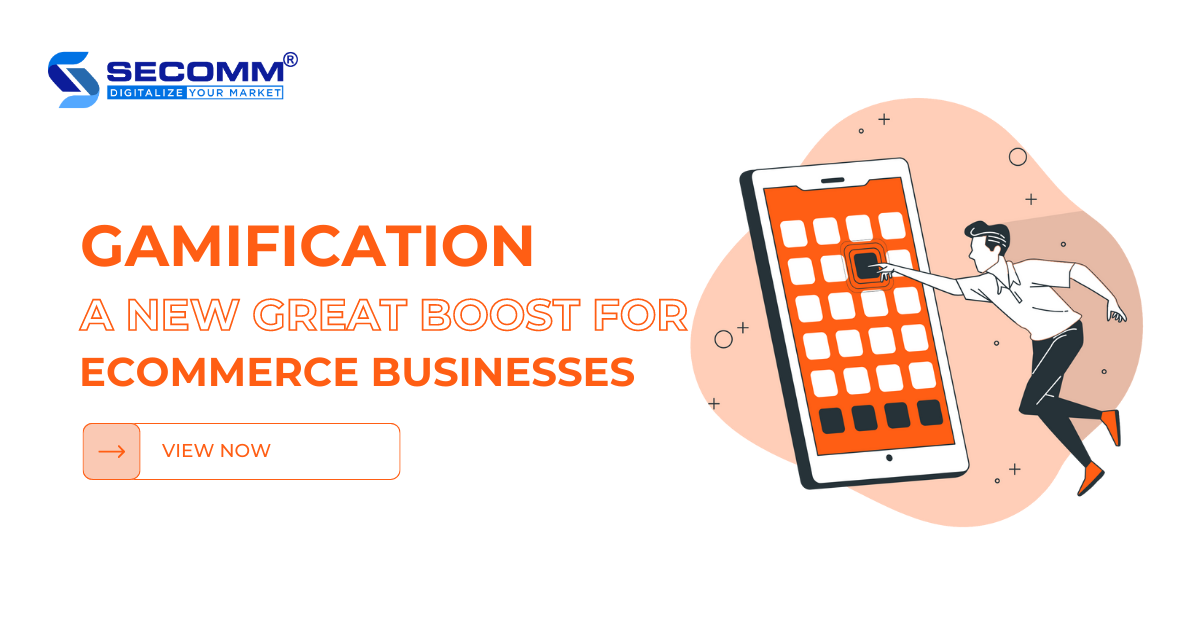
According to Research and Markets, the global gamification market was valued at over 10 million USD in 2020 and is expected to reach more than 38 million USD by 2026.
Gamification is a creative marketing strategy that has recently grabbed the attention of eCommerce business owners who are looking for ways to enhance customer engagement and achieve sales targets. In this article, we will discuss the ways Gamification empowers eCommerce.
Gamification hay trò chơi điện tử ứng dụng hoá, gọi tắt là Game hoá là thuật ngữ chỉ việc lồng ghép khéo léo cơ chế của trò chơi điện tử vào hoạt động marketing một cách sáng tạo, ấn tượng nhằm đạt được mục tiêu marketing đã đề ra.
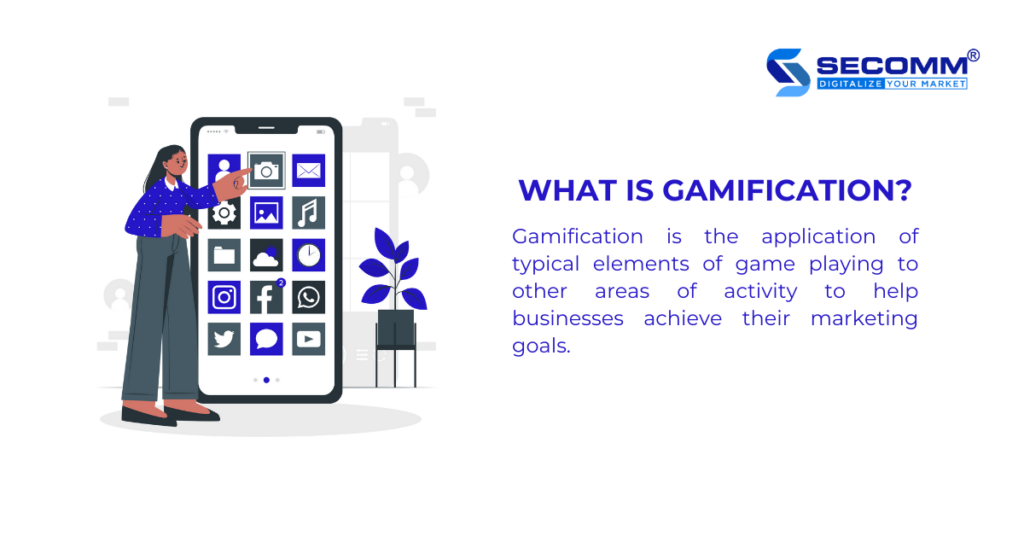
Gamification is the application of typical elements of game playing to other areas of activity to help businesses achieve their marketing goals.
Gamification emphasizes entertainment, making it a fantastic tactic for boosting brand loyalty and encouraging engagement with products or services. In recent years, eCommerce businesses have been accelerating the use of Gamification in the online shopping experience. Because customers today have more options, they also have higher expectations for their purchasing experiences. If an online store offers unique and enjoyable shopping experiences, customers are more likely to make a purchase quickly. Gamification will help eCommerce businesses stand out from the crowd.
Businesses can increase engagement by integrating Gamification into eCommerce websites and making shopping fun and interactive. Recent studies show that the eCommerce Gamification strategy will increase customer engagement by 47%.
Games usually ask players to complete tasks to earn reward points or to win the game (e.g sharing the game on social networks, inviting friends, browsing products, and adding to carts). If the game has some discount codes or vouchers, it will attract more players. That way, an eCommerce business can deliver its brand messaging directly to customers without pressuring or urging them into buying. An enjoyable shopping experience leads to an increased conversion rate.
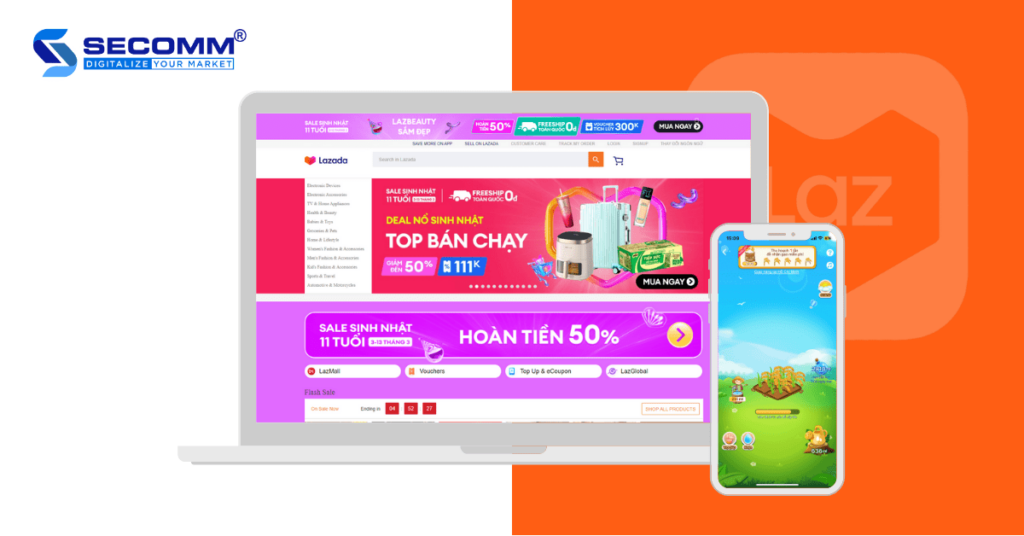
eCommerce Gamification strategy will help businesses boost sales if used effectively. When customers are engaged with the game, they are more likely to win discount codes and use them for later purchases which will make sales increase significantly.
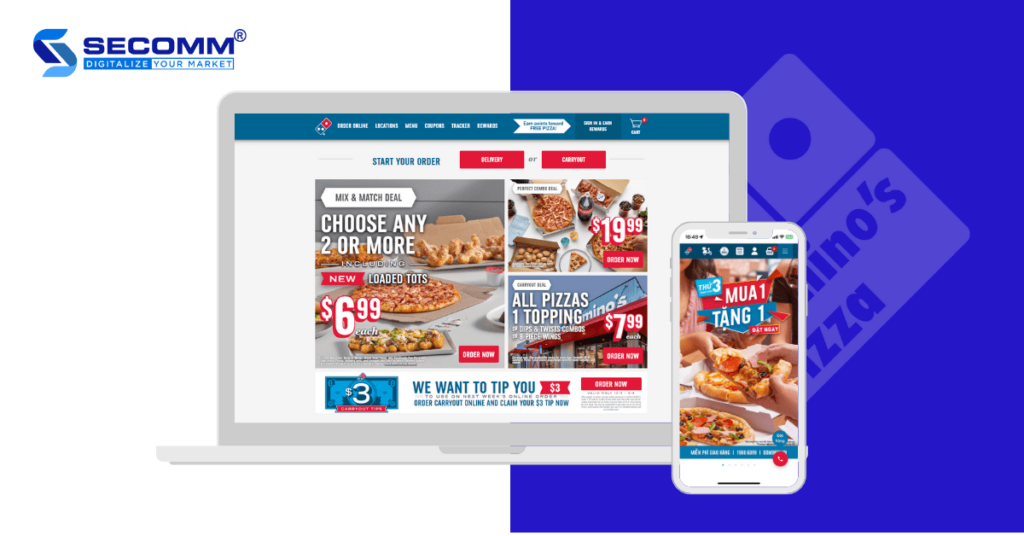
In 2021, Domino’s Pizza, one of the world’s leading pizza brands, increased its sales revenue by 30% with the help of Gamification. This company developed a game called Pizza Hero, in which users will make their pizzas on mobile devices. They can then click “Make an order” to order their pizza creation at a discounted price.
For brands, retaining customers and turning them into loyal customers is important. Gamification can help enhance brand loyalty by creating interesting experiences that encourage repeat visits. If a brand offers points or badges for reaching milestones, customers excited about earning rewards will be more likely to come back and play again. Whenever customers have shopping needs, they will recall and choose that brand.
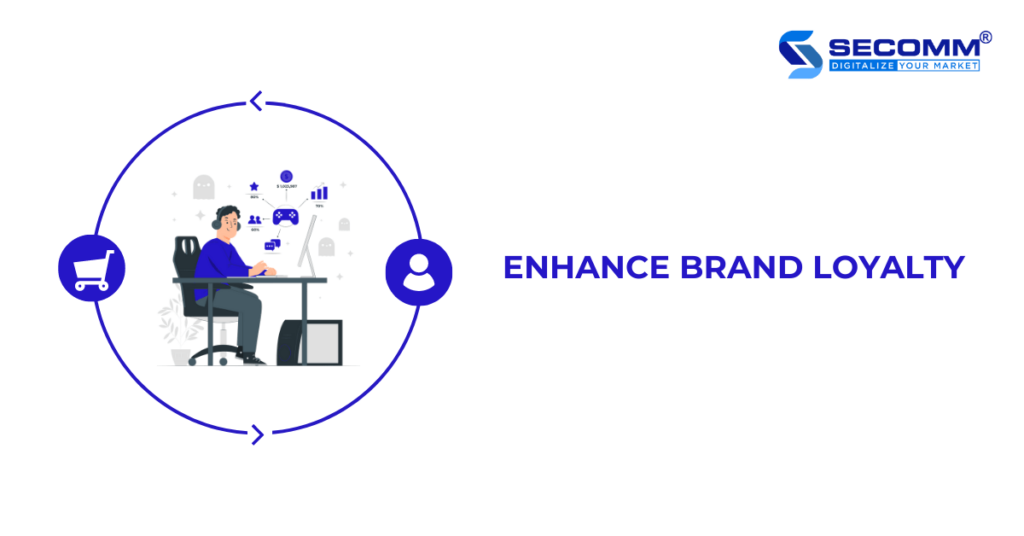
Although Gamification helps increase customer engagement, boost sales, and enhance brand loyalty, it still has potential drawbacks that eCommerce businesses should keep in mind before implementing it.
Developing amazing games requires creativity. Basic games like Quiz or Spin The Wheel are easy to create. These game experiences are too common among users so it’s unlikely to generate conversion. Hence, every business needs to get professional advice from creative agencies to design and develop engaging games that catch the eyes of users. However, it costs a lot of time and budget.
For example, creating a game with a variety of sound effects, images, videos, or personalized animated elements that enrich the user experience will increase the cost of implementation.
Among brands that have had success using Gamification, Starbucks would be the first one mentioned. Coffee brands usually offer vouchers or loyalty cards to encourage customers to return next time. Breaking out of the old rut, Starbucks developed a special game for its customers – “Flip the Cup”, in which the player chooses his favorite drink and could use one hand to flip the Starbucks cup. Each time, the player has 10 flips and each successful flip gets 10 points. Then, with the points achieved, the player can choose to play again or download vouchers. This exciting experience boosted engagement by 90% and the number of downloaded vouchers exceeded the targets by 110%.

As mentioned above, Domino’s Pizza first entered the market in 2012, and that same year the company also launched Pizza Hero, the first game that gave pizza lovers a new way to order. In case they don’t know what to order, they can shake their mobile devices to ask the app for suggestions. Especially, users can customize their pizzas, find coupons, place orders at a nearby store, and track order progress right on their devices.
By using this strategy, Domino’s was able to boost online sales by 30% and achieve $1 billion in the US market alone. Pizza Hero received 140,000 downloads in the first two weeks after its debut, propelling it into the top 15 Lifestyle ranking on Google Play and the iTunes Store. Moreover, Pizza Hero and Domino’s Pizza both won the praise of Forbes, the most prestigious magazine in the world.

Gucci has taken eCommerce Gamification to a new level. Gucci Arcade is one of the fashion giant’s Gamification strategies to attract the attention of Generation Z. It offers customers amazing games to engage with such as Gucci Bee and Gucci Ace. This experience helps Guccis reach a wide pool of potential Gen-Z customers.
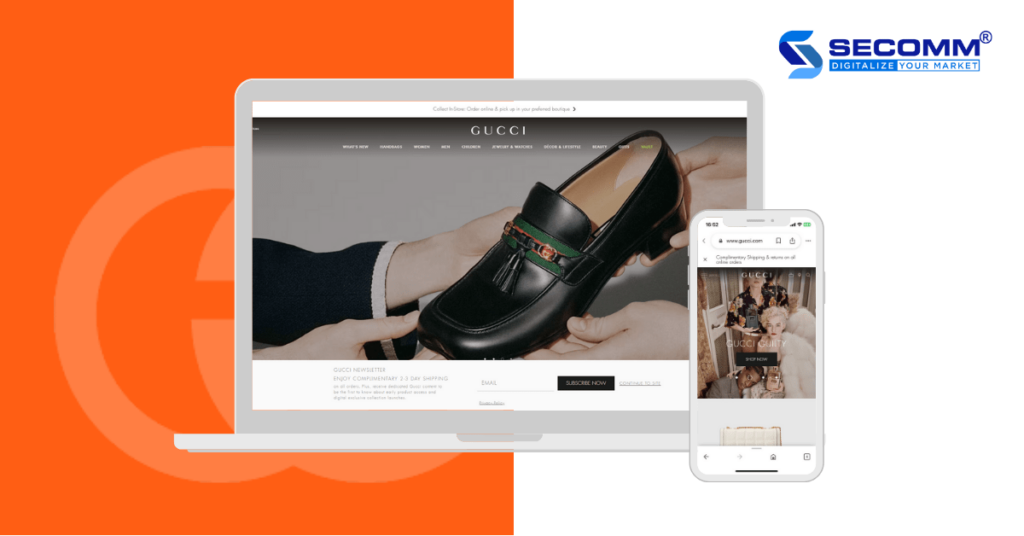
Gamification is a strategy that strengthens the development of eCommerce. It has become popular in the world as well as in Vietnam. Every business owner needs to seriously recognize its potential and plan for rapid implementation.
Talk to SECOMM today to get expert advice on eCommerce Gamification.
 4
4
 2,862
2,862
 0
0
 3
3
According to CommonThread, the global cosmetics eCommerce market size is valued at 483 billion USD in 2020 and grew to 511 billion USD in 2021 at a compound annual growth rate (CAGR) of 4.75%. The market size is anticipated to surpass 716 billion USD by 2025 and reach 784.6 billion USD by 2027.
The amazing growth rate of the online cosmetics sector demonstrates both the industry’s enormous potential to grow and its significant contribution to the global economy. Cosmetic companies must encourage the development of eCommerce websites to enter the market rapidly and take control of it in order to keep up with the economic trend as a whole.
It takes time to develop an online store for cosmetics, and SECOMM has detailed and analyzed the two key stages of the process.
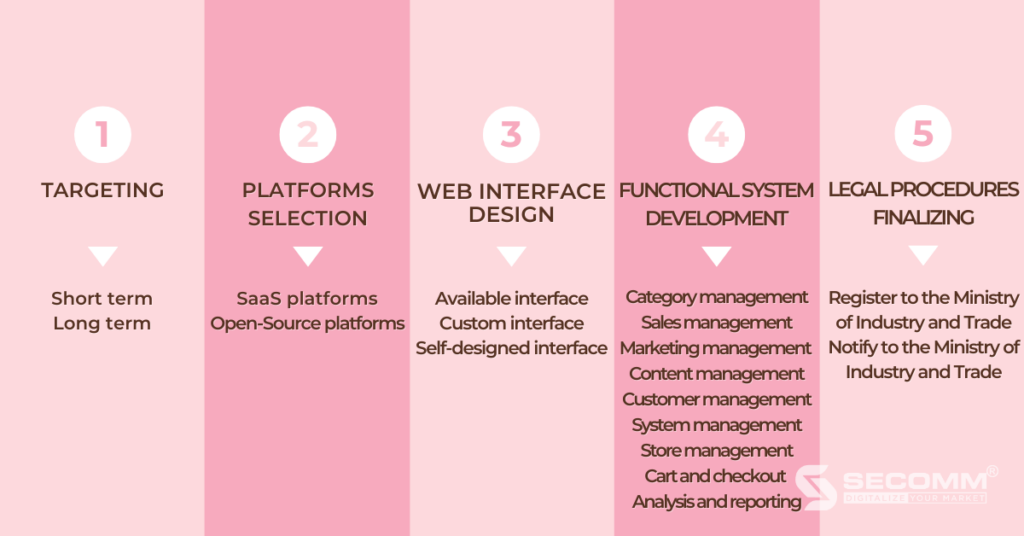
The first important thing a cosmetic business needs to do is to set goals and prioritize those goals in the short and long term.
In the short term, promotional activities, monitoring, analyzing, and measuring the effectiveness of marketing campaigns, especially user experience should be the top goals that need to be promoted.
In the long term, cosmetics eCommerce businesses should focus on increasing brand recognition and online business capabilities of their products.
At this stage, businesses do not have much data to analyze and evaluate for the whole process, so they can listen to a lot of advice from specialized eCommerce implementation consulting units with a lot of experience in long-term consulting to get the right list and priority of goals for both this period and beyond.
In today’s market, there are two types of platforms that are dedicated to building eCommerce websites, including SaaS platforms and Open Source platforms.
SaaS platforms
Service as a Software (SaaS) is a service-based software application distribution model for eCommerce business purposes.
In other words, the provider creates and maintains software to help build an eCommerce website and the business will pay a certain cost to use this service.
With SaaS, the entire website system is hosted on the provider’s server, so ownership and control of the source code and data will belong to the provider.
This means the SaaS service provider will be responsible for handling and fixing technical problems arising during the cosmetic eCommerce implementation.
Some of the popular SaaS platforms today are: Shopify, BigCommerce, Salesforce Commerce Cloud, etc
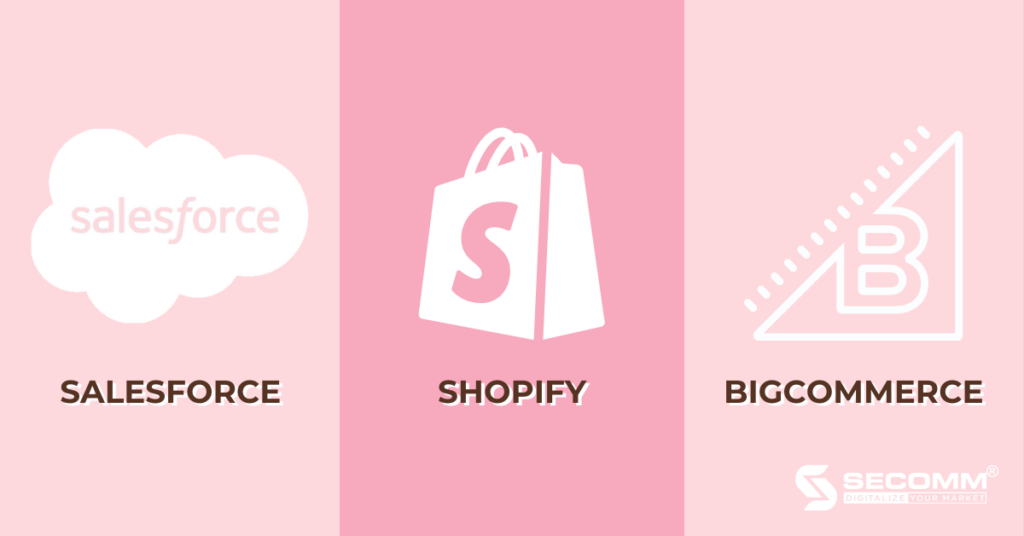
Open-Source platforms
An Open Source platform or an open source platform is software with a widely released source code that allows users to download, modify and upgrade necessary features for eCommerce business purposes.
The platform is often developed by a community of developers rather than a single company.
Moreover, this will be the ideal platform for implementing complex eCommerce website systems, specific to many fields including cosmetics thanks to in-depth customization functions.
This means that businesses need to cooperate with professional eCommerce website builders or develop a team of highly qualified internal staff to operate the website effectively.
The most prominent Open Source platforms on the market today: Magento, OpenCart, WooCommerce (WordPress Plugin), etc.
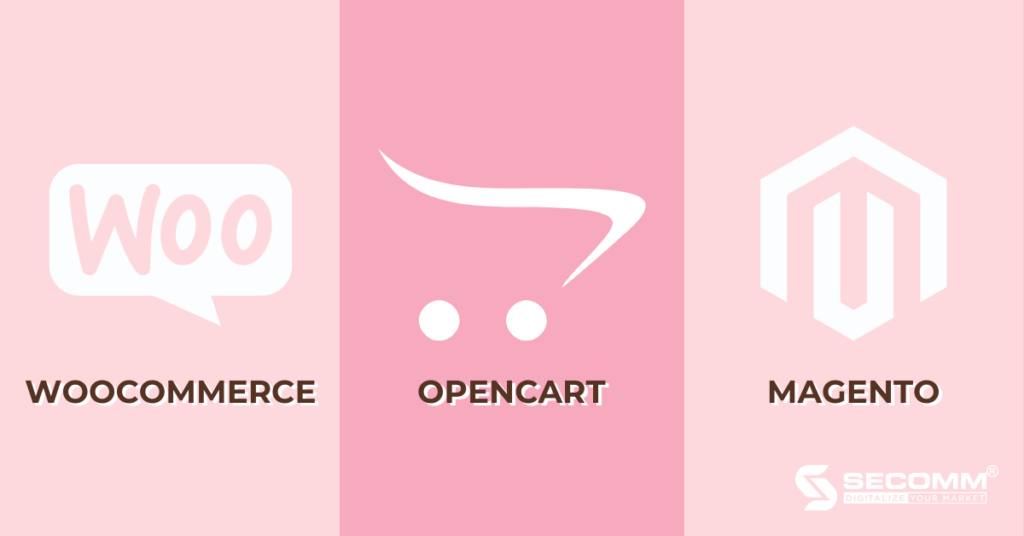
At this stage, businesses should choose a SaaS platform to start with to familiarize themselves with the eCommerce business as well as save budget for more important investments such as marketing,…
Then, when entering the second stage, the business scale has now grown and expanded, and switching to the Open Source platform is now necessary and reasonable to achieve the goal of eCommerce growth.
After choosing a platform to build a cosmetic eCommerce website, the business will design the website interface so that the standards of UI/UX are met in order to optimize the website, showing the characteristics of the brand and cosmetics industry.
So, businesses can choose one of the following three ways to design an eCommerce website interface:
Usually, in stage 1, businesses should only use the available interface or customize based on the available interface because the basic functionality system needed, most of the interfaces provided are already there.

In the first stage, businesses should prioritize developing the basic functional system needed for a complete cosmetic eCommerce website, specifically including:
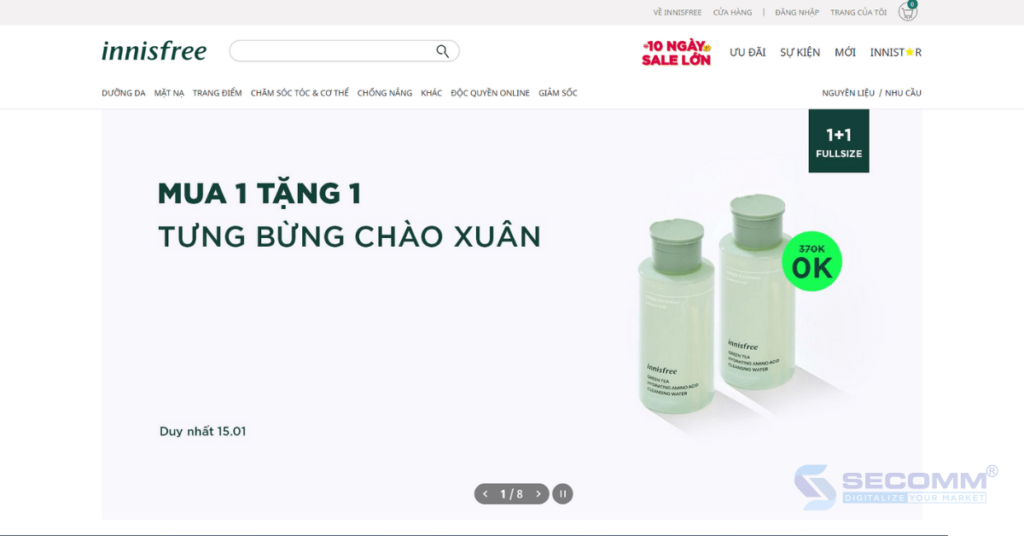
Functional system development
The final step of building a basic eCommerce website is completing the necessary legal procedures for the website to be allowed to operate legally.
Businesses can follow the simple registration steps as instructed at the eCommerce Management Portal.
This is a mandatory requirement of the Ministry of Industry and Trade for every individual or organization that owns an eCommerce website to sell goods and to perform the registration/notification obligation on time.
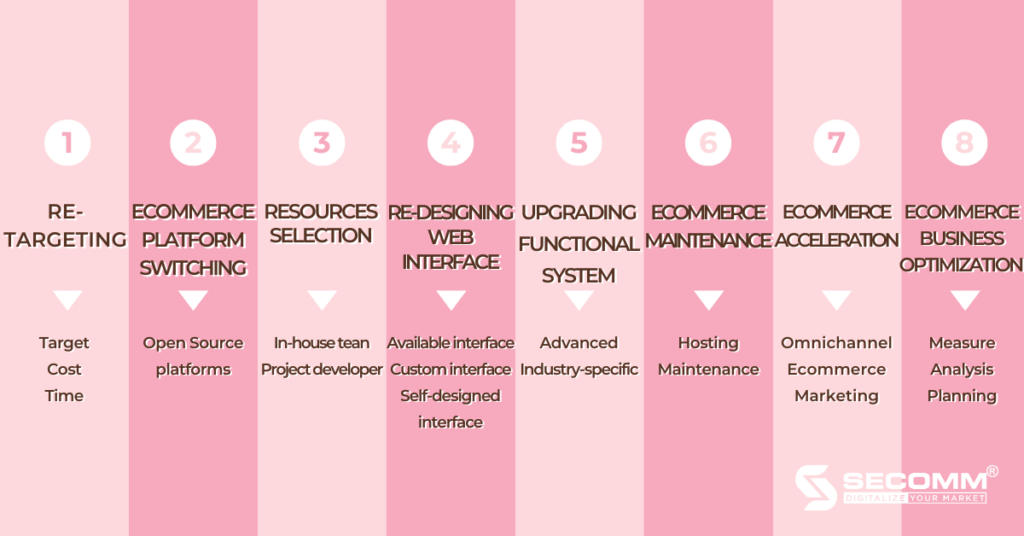
Along the business development journey that comes with the constant change of consumer behavior, business goals, and strategies need to be adjusted and re-established to match the current context of the eCommerce market. In addition, at this stage, businesses also have problems, data, and insights about online users, so setting goals will be easy.
In the short term, businesses can prioritize finding and attracting potential customers and growing online sales with effective marketing.
In the long term, a cosmetic business can consider the goal of expanding the market segment by identifying the target market segment and making a marketing strategy in accordance with the product characteristics and the direction of the business in the second stage.
In addition to short-term and long-term goals, businesses need to focus on considering the time and cost of investing in the cosmetic eCommerce website system because, at this stage, the cost and investment budget will often be large. much more than the basic construction phase above.
In the beginning, cosmetics businesses are advised to develop their initial eCommerce websites using SaaS platforms. However, the restricted capability and customizability of SaaS won’t be able to satisfy that expectation given the second phase’s objectives of growth and scalability.
To create more specialized cosmetic eCommerce websites at this moment, companies can think about moving to Open Source platforms with respected names like Magento, WooCommerce, etc.
Some suggested criteria to consider when choosing an Open Source platform:
Besides that, businesses should be aware of the costs associated with switching from a SaaS platform to an Open Source platform, the time required for staff to learn on the new platform, the danger of data loss, and any issues that may occur.
Unlike the basic eCommerce website building stage, in the second stage of the implementation process, businesses need to choose resources for development. Businesses can build an internal team or seek support from a specialized developer.
The business will hire and train skilled and specialized IT people on the chosen platform for internal team growth. In this case, it will require a lot of time and money from the company, but it will aid in better resource management, control, and active adjustment to develop the eCommerce website system in accordance with the original aim.
Businesses frequently work with a variety of firms to find “true love” in their collaboration with eCommerce website developers. As a result, businesses will receive the eCommerce websites they need as expected, the collaboration process will go smoothly, and businesses will gain more expert knowledge and website development experience from a partner, which will point them in the right direction in terms of the cosmetic eCommerce industry’s development trends.
These are the criteria that businesses should consider when choosing: In-depth knowledge and experience in eCommerce and the cosmetics industry; professional working team; clear and detailed working process; ability to quickly handle problems that arise during website development.
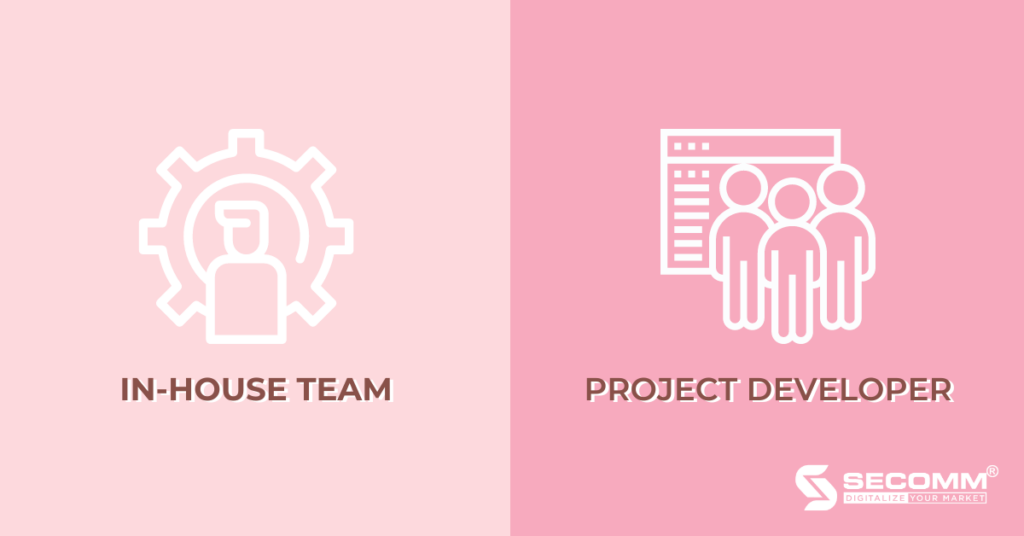
Businesses are not required to update the website interface while switching platforms. Redesigning the website interface to work with the Open Source platform, however, is today recognized as a wise company development approach that was introduced simultaneously with the deployment of advanced eCommerce websites.
Similar to the previous period, businesses have three options for designing e-commerce website interfaces, including using the available themes, customizing based on the available themes, and designing their own interface.
Usually, at this step, businesses should choose method 2 or 3 to design the interface to ensure the uniqueness of the brand and the specificity of the cosmetic eCommerce industry.
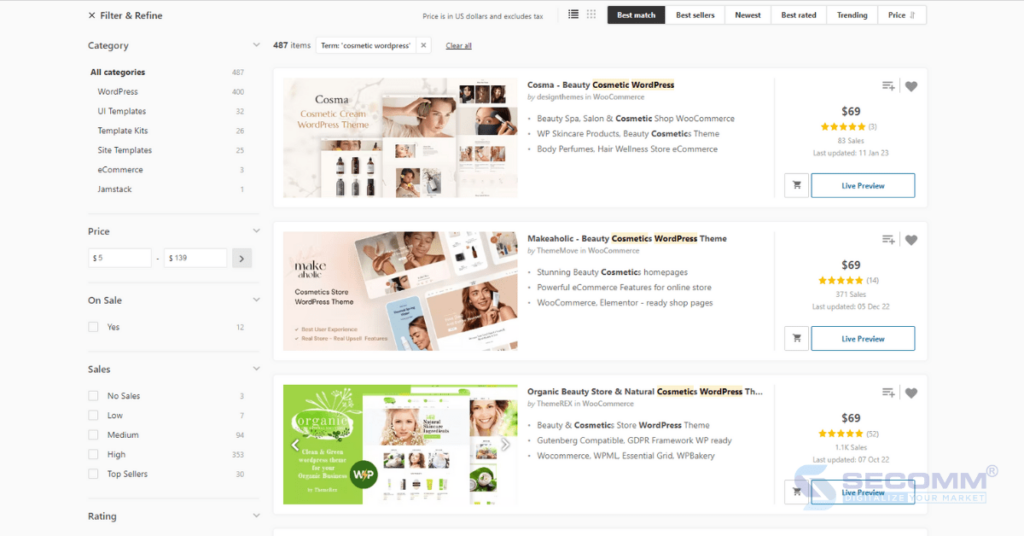
In addition to the basic functions that have been built for the eCommerce website system in stage 1, businesses should concentrate on developing a system of advanced and specific functions for the cosmetic industry in the later stages.
Today, several well-known cosmetic brands embrace AR (Augmented Reality) technology to improve the customer experience. Customers can now download the AR software, activate the camera, and sample the goods online rather than going physically trying it on in the store to see whether it will fit their face.
The Kylie Virtual World application, for instance, offers users an engaging product experience. Users of the newly released Kylie Cosmetics items, such as eye cream, foundation, and lipstick, can sample the product out in 360 degrees by using their phones to scan the QR code.
A sophisticated eCommerce website system demands a great deal of experience and effort to operate and maintain. This is the procedure of continuously maintaining, updating, and upgrading the entire system to aid firms in foreseeing and resolving problems (for example, sudden increase in traffic from the promotions that stimulate shopping).
That supports sustained and persistent online sales growth, which is important for eCommerce businesses in general and furniture eCommerce in particular as they compete for a market share of this “pie,” which is “delicious” but can be challenging to consume.
Furniture eCommerce enterprises readily accomplish growth above and beyond expectations by putting into practice efficient business and marketing strategies.
Therefore, the entire process—from planning through implementation—must be structured with effective, practical solutions that have been demonstrated to work. Implementing Omnichannel, eCommerce Marketing, and SEO optimization are some suggested methods for eCommerce enterprises to accelerate growth.
The journey of developing an eCommerce website ends with measuring, analyzing, and optimizing eCommerce business activities.
Businesses can use analytics tools such as Google Analytics, Google Tag Manager, Facebook Pixel, etc., to track, update and measure website performance metrics as well as the effectiveness of marketing campaigns.
From there, the eCommerce business strategy for the next stage of development will be carefully and methodically planned thanks to clear and detailed reports & analysis.
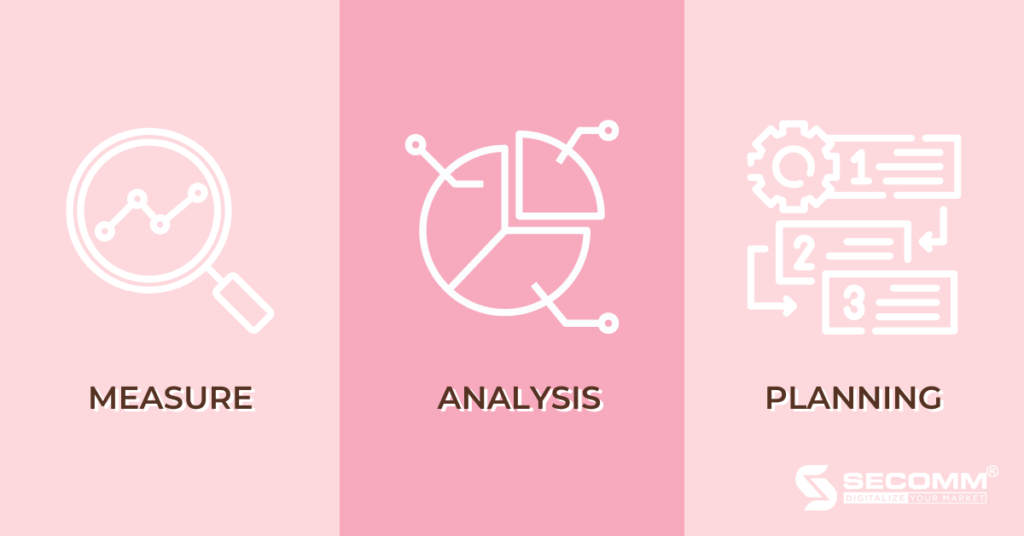
The journey of building a cosmetic eCommerce website with two stages from basic to advanced has been outlined in detail with meticulously analyzed implementation steps. Businesses in the industry can refer to it to draw their own development journey in this potential field.
With many years of experience in successfully implementing eCommerce for many customers in many countries in recent years, SECOMM understands the difficulties and challenges in the process of implementing an interior eCommerce website.
Contact SECOMM today for free support and advice.
 2
2
 2,539
2,539
 0
0
 1
1
It’s important when it comes to choosing the right platform to build an effective eCommerce system. Businesses have many options to choose from either the open-source eCommerce platforms or any eCommerce platform as a service (SaaS, Paas), depending on the eCommerce business model and business plans.
To have a comprehensive eCommerce system, the open-source eCommerce platform is the business’s best friend, because of the great flexibility, scalability, customization according to the products, and catalogue characteristics.
In addition, the open-source platform also allows businesses to own the entire system source code and data. With all of these outstanding features, open-source platforms are slowly becoming the eCommerce development choices that many businesses are aiming for.
However, businesses need to carefully consider choosing the right platform. There are a lot of open-source eCommerce platforms on the market (OpenCart, WooCommerce, Magento,…), and each platform has its pros and cons.
WooCommerce is a WordPress plug-in introduced in 2011, completely free, and allows businesses to turn their WordPress sites into online stores, with built-in and additional features.
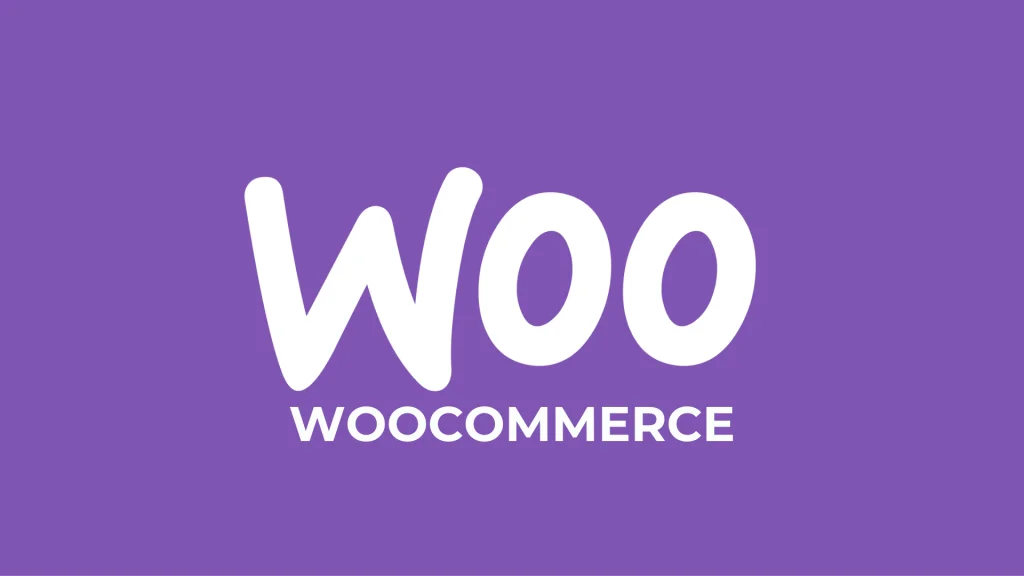
Ease of use
Many businesses that have been using WordPress for their online business, must be familiar with WooCommerce. Businesses can turn their website into an eCommerce system when implementing the WooCommerce Plugin into their WordPress website easily.
They can set up, integrate, and adjust functions on themes, and add-ons,… that have been built with high functionality from developers in a strong community around the world, making it easier to modify, and more flexible on the platform
In addition, WooCommerce is carefully built, convenient, also has huge and rich theme storage, and it is easy for businesses to design and build an e-commerce system right from the start, without knowing too much about technology.
Rich in features and add-ons
WooCommerce allows and supports features such as product management, orders, inventory, search engine optimization (SEO), discounts, sales, statistics reports, easy integration of payment units, shipping, handling units, and shopping experience optimization on all devices, making it easy for businesses to build a comprehensive system for simple and effective e-commerce business development.
Regarding security, WooCommerce ensures that businesses have the best security through a regularly updated system, and also ensures all of the business transactions are secure and safe through the features from the third-party services.
Low performance
One of the biggest disadvantages for businesses using the WooCommerce platform is the low performance, the system is easily overloaded with plug-ins and themes, and the number of products does not surpass 2000 SKUs, and often affects the system if the number of products exceeds the limit. Therefore, when businesses want to expand their business, it is necessary to consider switching to another platform.
Limited customization
WooCommerce is a plugin for WordPress, the platform lets businesses customize their eCommerce system, but building a complete, and comprehensive eCommerce system with unique features is very limited. The modification can cause instability for the system as well as the possibility that those built-in features are not compatible with the platform.
To customize a suitable system based on the available features system, businesses will face many challenges, it takes a lot of time and resources.
WooCommerce is perfect for businesses that are using WordPress and are looking to develop an e-commerce system. However, WooCommerce is not perfect for developing a comprehensive e-commerce system and expanding the business model. Some brands are using WooCommerce around the world such as Pluralsight LLC, and Gordon College, and famous brands in Vietnam such as Vietnam Airlines, Pharmacity, etc.
OpenCart is an open-source CMS (Content Management System) using PHP language, similar to WordPress but specially designed for e-commerce.

Friendly interface and easy-to-use
OpenCart provides an intuitive, easy-to-use, friendly interface, which is specialized for
the eCommerce industry. In addition, OpenCart also provides a completely free variety of interfaces and features, making it easy for businesses to develop e-commerce systems with basic website development knowledge and skills. Because OpenCart is built based on the MVC Model (Model- View- Controller), developing and writing a module for an e-commerce system on this platform is also quite easy.
Full of basic e-commerce features and a variety of add-ons.
OpenCart supports businesses with every basic e-commerce feature. Since OpenCart is a CMS specially designed for e-commerce, the open-source commerce platform such as OpenCart fully supports basic e-commerce functions such as sales, sales management, data management, statistics, customer data lists, and invoices.
Businesses can easily create and manage many different stores on the same system without having too much technical knowledge. This also means that businesses can access and manage all data of multiple stores at the same time with just one single central OpenCart system.
Not only supporting businesses build and manage an eCommerce system, but OpenCart also supports marketing such as search engine optimization (SEO), keyword advertising (Adwords), marketing programs, and affiliate marketing programs to be able to reach customers more easily, increase sales on the eCommerce system.
On top of the basic e-commerce functions, OpenCart also has additional applications to support businesses such as daily business operations and product categories. The backup and restore function helps businesses always have a backup system in hand and ready to restore all of the data on the system in case of an emergency
Besides that the platform also has many features such as a shopping cart, support customers to buy many products at once; gift features issuing gift cards, and loyalty programs. In addition, businesses can integrate other utilities such as payment gateway VNPay, and PayCEC, to help businesses have a better, faster, and seamless shopping experience.
Customization
With all of the basic features of an open-source program, businesses can easily modify, edit and customize on the OpenCart platform. In addition, the OpenCart e-commerce platform has a great ecosystem with many functions suitable for e-commerce business, firms can fully explore, as well as develop modules that are suitable for a satisfactory e-commerce system.
Although the OpenCart platform has many advantages that are the best fit for e-commerce businesses, there are also some limitations that businesses should be aware of when using the platform.
Low performance, and unstable
Although the platform is highly rated and well designed for the eCommerce industry, the system is still not stable enough because the modules and functions are not fully optimized, many errors occur while operating, as well as the installation steps are still very perplexing.
Therefore, businesses still encounter many problems when building and operating, which might affect the business’s processing speed as well as the revenue.
Feature development costs can become expensive
OpenCart owns extensive storage with quite a lot of basic features to serve e-commerce businesses quickly and conveniently, but the platform still cannot meet the advanced and specialized features according to specific product characteristics, product categories, and business needs of each field.
Therefore, businesses will need to invest time and resources to develop advanced features. For example, the SEO feature is supported on the platform, but there are many difficulties when censoring content via Google, not as effective as on the WordPress platform.
The OpenCart platform is relatively new compared to other platforms on the market, has many limitations and needs to be optimized. Similar to the WooCommerce platform, this is a good platform to start an ecommerce business, but not perfect for developing a comprehensive ecommerce system that goes along with growing and scaling your business. Some of the international brands that are using OpenCart such as Sunglass Hut, Virgin Enterprise, Audio-Technica Ltd, and the brands in Vietnam that are using OpenCart are Mobifone, RitaVo, etc.
Magento is an open-source platform specially built for e-commerce. It is recognized as one of the leading e-commerce platforms today, offering various outstanding advantages such as high flexibility, a diverse ecosystem, and optimal security. Currently, Magento has two versions: Magento Open Source (free) and Magento Commerce (paid).
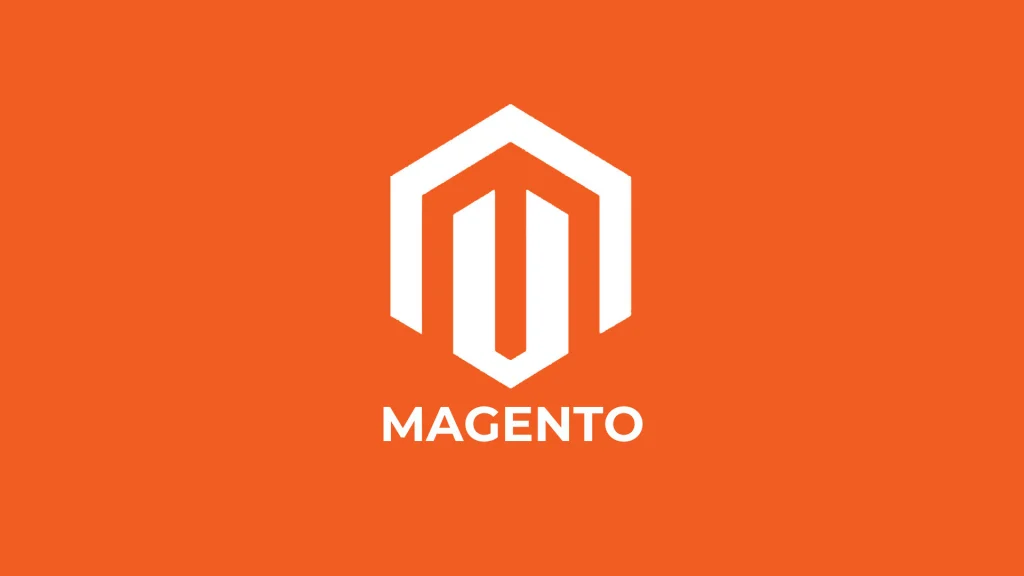
Diverse features for e-commerce from basic to advanced
Magento possesses many features available from basic to advanced to develop a complete e-commerce system including Category Management, Content Management, Customer Management, Marketing Management, Order Management, Store Management, System Management, Shopping Cart and Checkout, Reporting & Analytics. These features have been built with flexibility, and high availability to deliver outstanding results when integrated into the system, meeting all of your business e-commerce operations and sustainable growth needs
Scalability
One of the biggest fears of all ecommerce businesses is having a slow, poorly functioning system, or being overwhelmed when there are too many SKUs. With Magento, businesses do not need to worry about these issues even with millions of SKUs or thousands of transactions per hour. Magento can meet all the operational requirements, and business sustainable e-commerce development needs, with the ability to handle up to 500,000 products, and thousands of transactions in an hour.
High flexibility and customizability
Owning all of the advantages of an open source ecommerce platform, Magento has outstanding flexibility and customization. Businesses can easily change and develop new and specialized features according to the characteristics of products, industries, and businesses to be able to catch up with the rapid change of the market.
On top of that, businesses easily integrate third-party systems such as payment, shipping, POS, ERP, CRM, PIM, and BI to help develop all resources, and seamless processes without affecting the level of production, and the performance of e-commerce systems.
A global community for technical support and consulting
The customer support from Magento is for the customers, who are using the enterprise version, Magento Commerce. For customers, who are using the free edition, of Magento Open Source, there will not be any customer support from the platform.
However, Magento has a strong global technical support and consulting community. Therefore, most of the problems in eCommerce that businesses are facing can be solved from the Magento ecosystem or extensions from a third party. Having a strong global technical support community is also a testament to the level of reliability, quick resolution, and constant updates that Magento open source platform brings to customers.
High development costs
Magento open source e-commerce platform is highly appreciated with outstanding functions to develop a sustainable commerce platform, but businesses need to invest significant resources to deploy and develop the system.
Magento is an open source platform built specifically for e-commerce. This is known as one of the leading eCommerce platforms today on the market with many outstanding advantages such as high flexibility, diverse ecosystem and optimal security. Currently, Magento has 2 versions: Magento Open Source (free), and Magento Commerce (paid).
Magento has several outstanding features to develop a complete e-commerce system, and become a one-stop-shop for businesses that need development:
High Scalability
The biggest fear of all e-commerce businesses is having a slow, poor-performing website, or being overloaded with too many SKUs. With Magento, businesses do not need to worry about these issues, whether they have millions of SKUs or thousands of transactions per hour. Magento can meet all business needs for sustainable e-commerce operation and development. Therefore, businesses can scale up their business with Magneto.
High flexibility and customizability
The fact that the Magento platform has a high degree of flexibility is because of an open source platform. Businesses can modify and customize the templates, as well as adjust the features that the business needs to operate. In addition, businesses can completely build features from scratch to have an e-commerce system that is most suitable for businesses.
On top of that, businesses can easily integrate third-party systems such as ERP, CRM, and payment methods without affecting the level of performance of the main e-commerce system. In addition, businesses can easily separate the front-end interface from the back-end commercial activities.
Magento is an ideal place for businesses to host their software, but also a place with a lot of features. If your business currently has an experienced developer, or finances to attain a developer, and is ready to have an impressive e-commerce system, then Magento is a good choice. You have complete freedom to adjust the features until you are satisfied with your e-commerce system.
Big developer’s community around the world
However, the customer care from the Magento e-commerce platform is completely absent, in addition to that, Magento has a global developer support community. Therefore, there will be a lot of support for businesses to solve problems, and related techniques, as well as advice on building the most suitable solutions for businesses anytime, anywhere, and of course with a fee.
High development cost
A fully functional ecommerce system for a business is estimated to be at least $20,000 annually or more. If your business is just getting into e-commerce and has absolutely no technology experience, choosing Magento is a risky choice. But if businesses have the capacity and resources to run the system with this platform, then business growth will be faster with additional features such as sales automation.
Fully functional enterprise versions are estimated to be at least $20,000 annually or more. If your business is just getting into e-commerce and has absolutely no technology experience, choosing Magento is a risky choice. But if businesses have the capacity and resources to run the system with this platform, then business growth will be faster with additional features such as sales automation.
Complexity of specialized functions
Many businesses currently still face difficulties when transforming to e-commerce because of the specific characteristics of different industries and fields. These specific functions require an appropriate technology solution to ensure that the ecommerce system can operate efficiently and sustainably after the transformation. To build a specific feature with high complexity for an e-commerce system, businesses will need to spend more resources and time than the usual plan that businesses have set out to get a solution that fits the specific requirements of your e-commerce business.
Vietnamese firms that are using Magento
Magento is the best-fit solution for small and medium B2C businesses that have the need as well as the time, manpower and skills to build an e-commerce system. Famous brands in Vietnam are using the Magento ecommerce platform: Sendo, Vietnamworks, SJC, etc.
Different e-commerce platforms offer different features and values. No matter what route your business follows when building your e-commerce system, always think carefully about the following factors:
BigCommerce
With BigCommerce, businesses can choose the price that suits their business needs. In addition, the BigCommerce eCommerce platform is designed for everyone to use, from beginners to professional developers. However, if the business does not have a lot of capacity, as well as finance, then using BigCommerce to develop an e-commerce system is not suitable.
WooCommerce
With the WooCommerce ecommerce platform, businesses have full control over the ecommerce system. In addition, businesses can freely compare, and adjust any functions in the ecommerce system. However, expanding your business on the WooCommerce platform would be an inappropriate choice, as the platform can be overloaded with functions on the ecommerce system. However, businesses can start an ecommerce system with WooCommerce with less investment than competitors like BigCommerce.
Magento
Magento is a comprehensive ecommerce platform capable of supporting businesses to expand and grow their business in all aspects. However, all the disadvantages of Magento can be narrowed down to a single problem: the technical challenges, which require businesses to have an in-depth programming team. Meanwhile, businesses can solve this by having a team with experience building e-commerce systems.
Businesses can contact SECOMM to receive detailed advice for the journey to develop a comprehensive and sustainable e-commerce system for businesses and consult Magento solutions specifically for SMEs in Vietnam!
 2
2
 14,143
14,143
 0
0
 1
1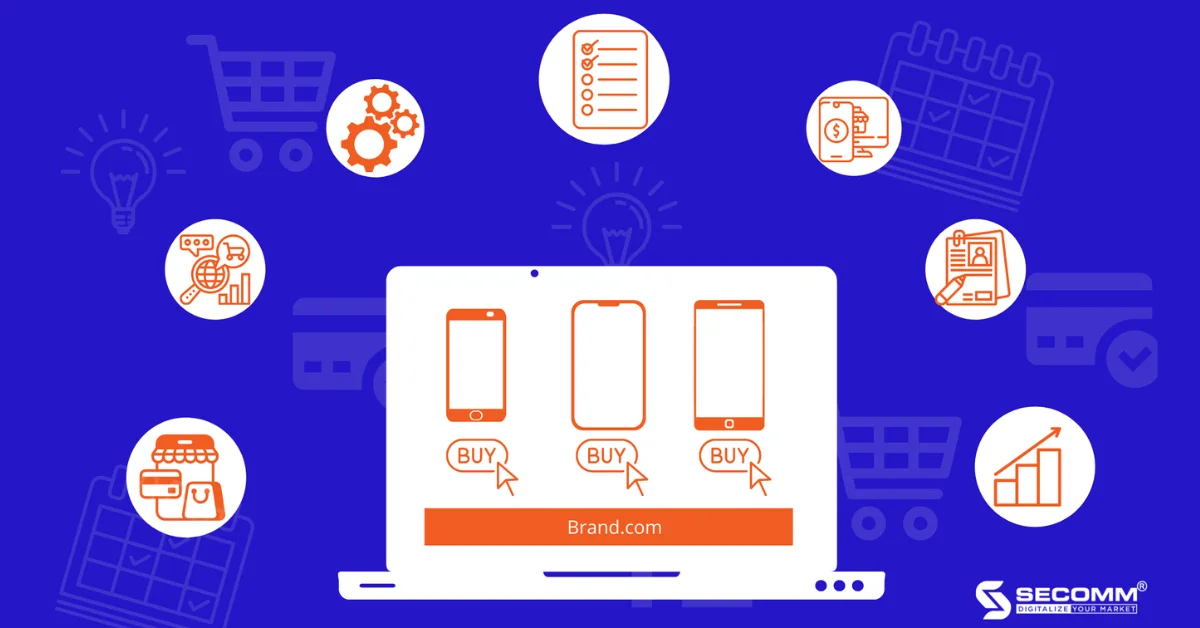
The COVID-19 pandemic has shifted shopping trends from traditional stores to online channels. Due to the pandemic, the demand for electronic products such as phones, laptops, and tablets has increased. This has helped mobile phone retail businesses achieve high revenue growth and profitability.
The “leap” into e-commerce has opened up many opportunities for businesses to develop – opportunities to provide a fast and seamless shopping experience for customers, expand sales channels, increase revenue, and establish brand identity.
In this context, owning an e-commerce website is almost a prerequisite for starting a successful online business. An e-commerce website can support businesses in several ways:
Related article: Top 10 retail websites for mobile phones in Vietnam
Though the benefits are plentiful, how can one design a comprehensive e-commerce website for a business professionally and effectively?
Below is the journey to build a comprehensive e-commerce website for a mobile phone retail business with two main stages: (1) building the basic e-commerce website and (2) transitioning to building an in-depth e-commerce website.
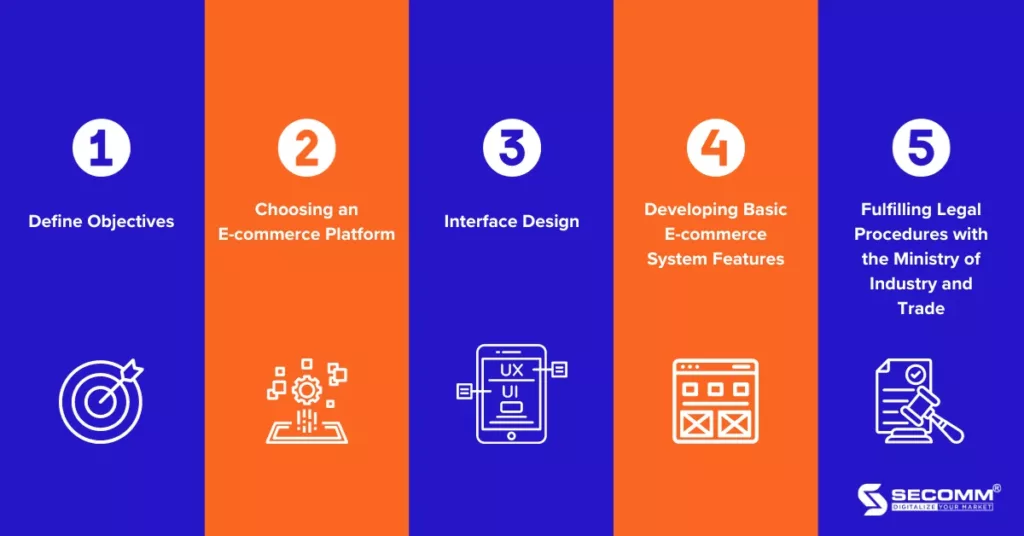
The first step in constructing an e-commerce website is for the business to determine elements such as objectives, budget, and time for project development.
After completing the “ideation” for the e-commerce website, businesses can kickstart the project by purchasing suitable hosting and domain names aligned with the products or services the business intends to offer.
Once the specific business strategy has been identified, the business needs to carefully consider choosing a platform for building the e-commerce website. Currently, the two most popular types of e-commerce platforms are Software as a Service (SaaS) and open-source platforms.
With SaaS platforms, businesses can choose from various pre-designed templates and features to build a website through simple drag-and-drop operations, requiring minimal investment in terms of time and development costs. However, with SaaS platforms, businesses do not own the source code and data; they can only utilize the available features of the platform. The flexibility and scalability of the system are limited, and usage costs may increase over time. Some popular SaaS platforms in Vietnam include Haravan, Shopify, Sapo, etc.
With open-source platforms, businesses have complete freedom to design the interface according to their requirements. These platforms offer high flexibility and can be customized extensively. Open-source platforms provide a full range of features and additional utilities, supporting sustainable development. Businesses own all the source code and data. However, businesses will need a skilled in-house team or experienced development partners to accompany them, investing time and money in development. Some popular open-source platforms include Magento, WooCommerce, OpenCart, etc.
Businesses can initiate the interface design for the website on the selected platform by using existing templates or themes available on the system. Alternatively, they can customize and design a unique interface that aligns with the brand image and specific preferences of the mobile phone retail industry.
At this stage, the business collaborates with an in-house IT team or a deployment unit to establish fundamental eCommerce features, ensuring smooth sales processes on the system. On both SaaS and open-source platforms mentioned earlier, businesses can choose suitable functions and integrate them into the website. Some common basic features include:
A mandatory criterion for the official operation of a business’s eCommerce website is the completion of legal documents following regulations. According to Decree 52/2013/ND-CP by the Government, individuals or organizations owning eCommerce websites for selling goods are required to notify or register with the Ministry of Industry and Trade on the eCommerce Management Portal.
Businesses can either complete the registration process themselves or enlist the services of law firms that provide related services.
Typically, a basic website may only support a business in its initial stages and face challenges as the business model evolves. Businesses gradually realize the need to develop a more specialized eCommerce system to enhance service quality and improve the overall experience for both customers and the business itself. The development of a sophisticated system requires businesses to be more prepared in terms of time and costs compared to the initial phase.
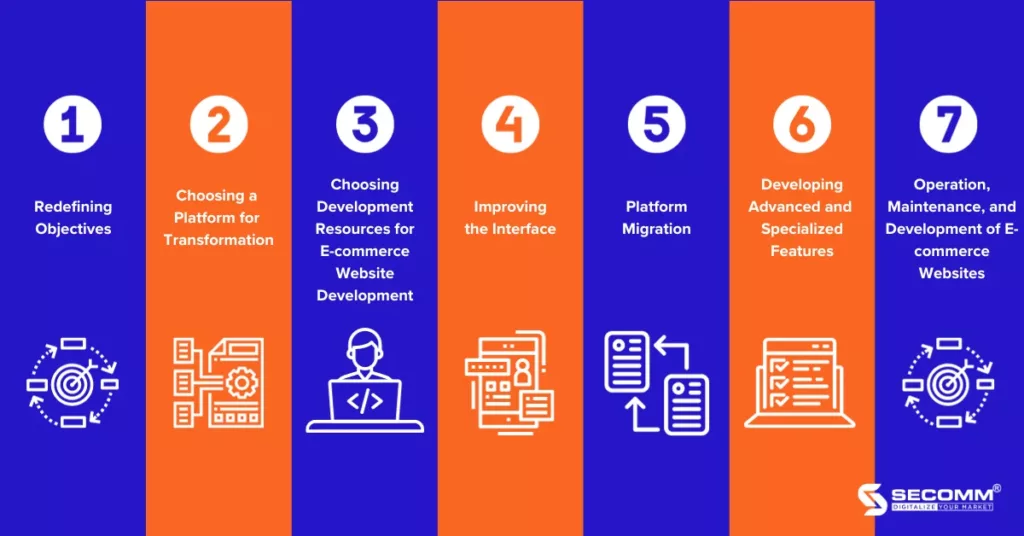
Similar to developing a basic eCommerce system, the first step in developing a sophisticated e-commerce website is for the business to redefine its objectives, costs, and timelines for the project. It is crucial to explore specific features and advancements within the industry. This allows the business to plan a detailed and accurate development strategy that aligns with its business model.
To develop a deep eCommerce system, businesses should opt for open-source platforms such as Magento, WooCommerce, OpenCart, etc. Open-source platforms can best meet the expanding system needs and sustain development alongside the business. However, besides the drawbacks of high development costs and an extended construction period, businesses also need an experienced IT team to effectively utilize these platforms.
Criteria for Platform Selection at This Stage:
Allows the development of a standardised user interface that reflects the brand’s characteristics and showcases product images clearly and cohesively.
Enhances brand identity and differentiation.
The admin interface should be user-friendly, facilitating easy navigation, control, and management of the entire system’s data.
The system should support basic functions and be flexible enough to accommodate the development or integration of advanced and specific features.
This flexibility ensures stable business operations in the long term and the ability to adapt to evolving business models.
Seamless integration with other software without compromising the performance of individual systems.
High scalability to adapt and grow alongside the business, catering to various business models.
Cost-effective long-term budgeting while constructing a sustainable and efficient system suitable for the business.
The ability to expand, whether it’s adding multiple websites, operating in multiple countries, dealing with various currencies, or managing multiple channels.
Ensures the system can efficiently meet the evolving needs of the business.
Can extend to multiple websites, support internationalisation, handle diverse currencies, and manage various sales channels.
Ensures stable system operation regardless of increasing web traffic and transaction volumes over time.
To build a sophisticated eCommerce website, businesses can either establish an in-house team or collaborate with external development partners. In both cases, a skilled and experienced workforce with a professional work ethic is essential.
In-House Team:
External Development Partners:
Recommended Service Providers: Several service providers specialize in deploying advanced eCommerce systems. Some notable examples include SECOMM, SmartOSC, Co-Well Asia, Isobar, and Magenest.
Choosing between an in-house team and external partners depends on the business’s specific needs, resources, and preferences. Each option has its advantages and challenges, and businesses must carefully evaluate their circumstances before making a decision.
While transitioning to a new eCommerce platform, businesses have the flexibility to retain their current website interface or redesign it for an enhanced user experience and improved brand positioning. Redesigning involves adjusting existing themes to save time and budget. However, some businesses opt for a custom redesign to meticulously tailor the interface to their specific needs, which may require a higher investment in terms of time and budget.
Platform migration is a crucial step in building a deep eCommerce website. Automation is typically used to minimize errors during the transition. Businesses need a comprehensive plan encompassing features, data, and scenarios to ensure a smooth and effective transition. The process begins with data extraction from the old system and recording it into the new system.
Post-migration, thorough testing is essential to verify that all components and data have been accurately and adequately transferred according to the plan.
When constructing a deep eCommerce website, businesses must introduce advanced and specialized features to support business model expansion, enhance competitiveness, adapt to market changes, increase revenue, and improve the shopping experience. Some advanced features for eCommerce and mobile retail may include Buy Now Pay Later, Flash Sales, and advanced product search functionalities.
Continuous learning and staying informed about necessary features are crucial for system development. This can be achieved through online applications, an in-house development team, or external development experts. After outlining the development plan, collaboration with design experts to create a system model is essential. The subsequent step involves programming features based on the approved plan. Before deployment, thorough testing, based on the requirements specification document, is conducted to update test scenarios and log errors using error management tools.
After developing an eCommerce website, regular maintenance, care, and updates are necessary to ensure continuous online business operation, seamless system operation from online to offline, and optimal user satisfaction. Ongoing research is vital to optimize and develop the website to create a satisfying and comfortable shopping experience.
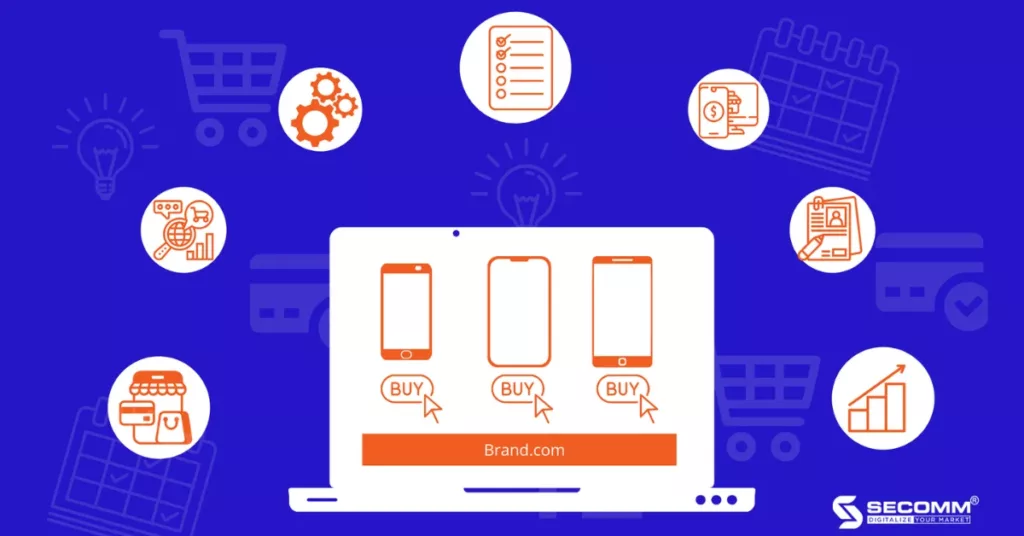
In summary, a comprehensive eCommerce website is crucial for the current and future success of mobile phone retail businesses. Building such a website involves a meticulous process, and each step is critical. Businesses can contact SECOMM for free consultations on comprehensive eCommerce website solutions tailored to mobile phone retail businesses.
 2
2
 12,095
12,095
 0
0
 1
1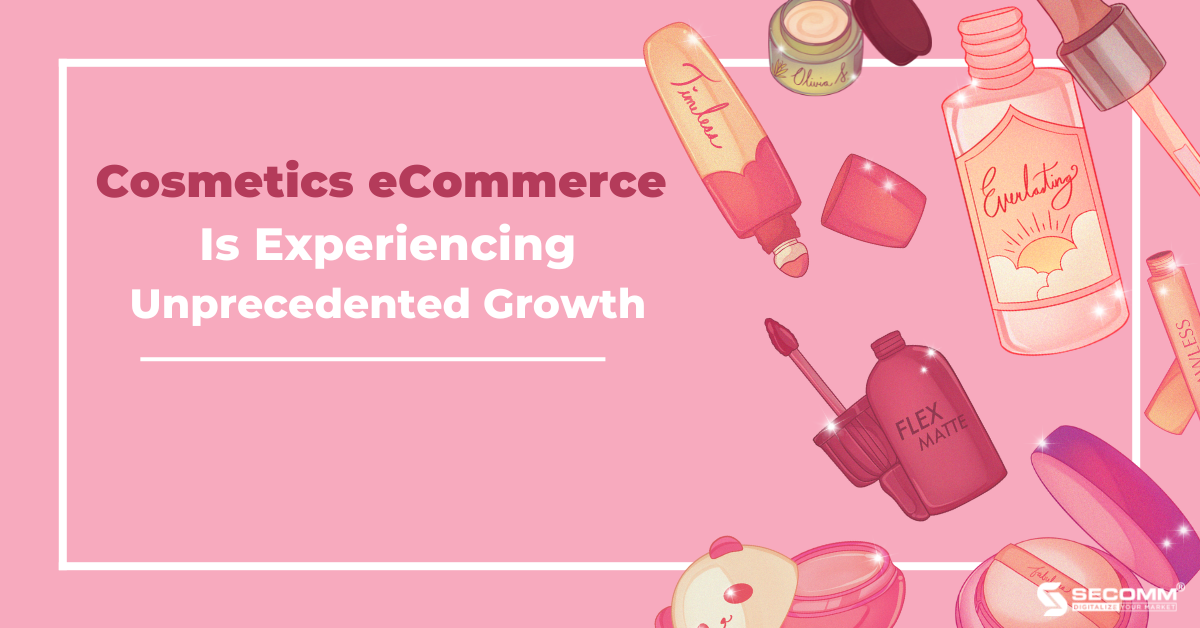
Consumer demand for beauty and health care is rising as the quality of life gradually improves. The fact that so many individuals are involved in commerce has also contributed to the cosmetics industry’s reputation as one of the most important sectors in the modern economy.
Additionally, the rapid growth of eCommerce following the pandemic is gradually emerging as a successful business strategy and a crucial step in the digital transformation of every industry, including the cosmetics industry.
The market size for cosmetics sold online is estimated by CommonThread to be $483 billion in 2020 and expand to $511 billion in 2021 at a compound annual growth rate (CAGR) of 4.75%. The market size is anticipated to surpass 716 billion USD by 2025 and reach 784.6 billion USD by 2027.
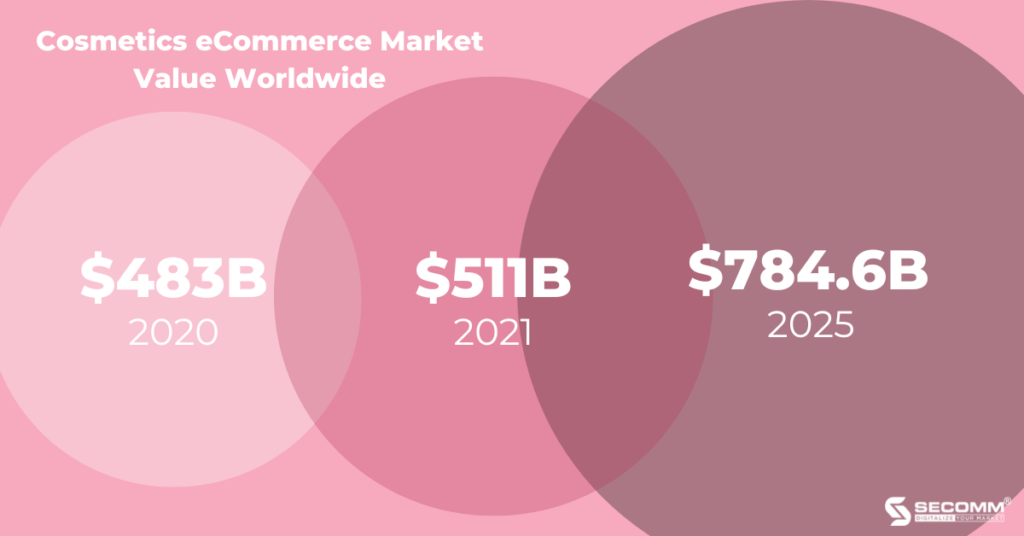
In the past pandemic years, the global economy has witnessed a sudden decline in sales in many industries, including the cosmetics industry.
People are compelled to reduce their social interactions while social distancing mechanisms are in effect.
At this time, people’s psychology will be more concerned with keeping an eye on and caring for themselves. Due to the unpredictable changes of the pandemic, there has been a sharp rise in the need for skincare, hair care, and body care products to enhance spiritual life.

Due to restrictions on leaving the house, online shopping at the time had become not only a need but also an urgent method of purchasing in place of in-person purchases. That serves as a springboard for eCommerce to take off and spur significant growth in other industries like fashion, grocery, wine, and even cosmetics.
These two elements highlight the enormous potential of this “cake,” assisting several cosmetic companies in realizing and swiftly implementing eCommerce for both sustainable development and market revolution.
Using eCommerce as a solution will allow the cosmetics industry to shift from offline to online (O2O) business models rather than allowing their businesses to “get lost” in the crisis of the global pandemic.
Additionally, if businesses still do not have a competent eCommerce website to introduce and sell products to customers who love to shop online in the age of digital transformation, they will quickly lose many potential customers to rivals.

This is especially true for a highly competitive industry like cosmetics, but several firms, including Hasaki, LixiBox, Watsons, Guardian, etc., have embraced the trend early and are now the market leaders in cosmetic eCommerce.
Furthermore, early eCommerce development will also provide benefits that will make marketing efforts more successful, broadening the economic opportunities for businesses.
Businesses must consider customers’ purchasing experiences when launching eCommerce websites, and not just for the cosmetic industry.
Thanks to the use of contemporary technologies, which are quite popular in the cosmetics industry, the purchasing procedure will be swift, and effective, and bring customers satisfaction when they choose to buy cosmetics online.
For example, a 360-degree intuitive vision, virtual reality (VR), or augmented reality (AR) technology (AR).
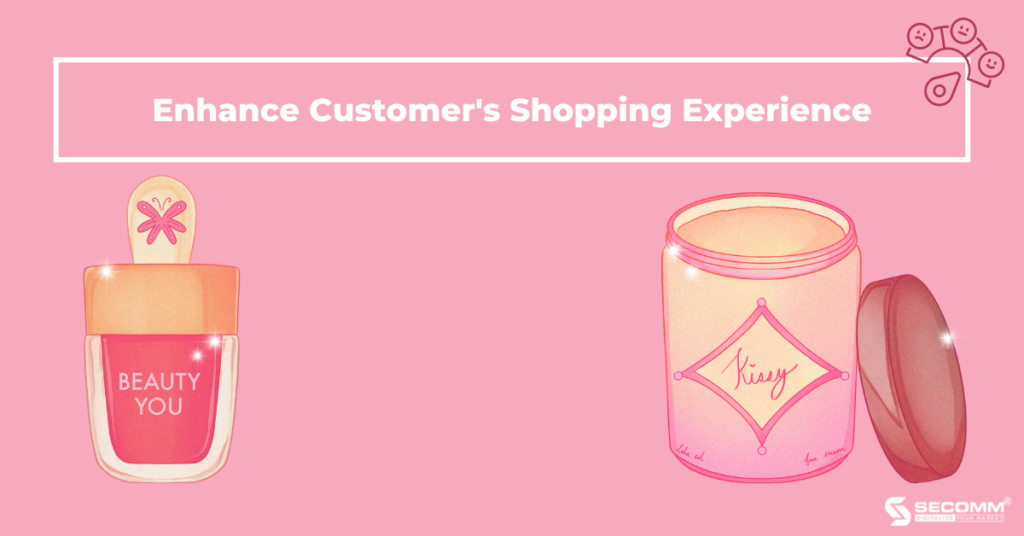
eCommerce enables businesses to quickly and effortlessly tailor the experience for customers by gathering, evaluating, and synthesizing the consumption behavior of each target group. Typically, this is done with the capabilities listed below: Products have seen, similar product recommendations, etc.
eCommerce provides clients with a seamless experience in addition to an intuitive one across a variety of channels, including social networks (Facebook, Instagram, Tiktok, Zalo, etc.), eCommerce platforms (Shopee, Lazada, Tiki, Sendo, etc.), eCommerce websites, mobile apps, etc.
One of the most successful cosmetic brands that has a significant global media impact is Kylie Cosmetics. When it comes to Kylie Cosmetics, it’s tough not to give Kylie Jenner credit.
She’s the youngest female millionaire in the US and has been hailed as a business genius by prominent publications like Forbes due to her success in the saturated cosmetics industry.
When Kylie Cosmetics was founded in 2015, it generated an astonishing $ 420 million in revenue in its first 18 months. It is predicted that by 2022, net sales will have reached $ 1 billion.
The sensible business strategy, in addition to the founder’s reputation, focuses on utilizing the “gold mine” of eCommerce and launching social media marketing campaigns, which are the factors that contribute to that respectable revenue block.
As a result, the company used Shopify, a platform that specializes in creating websites for the top online retailers in North America, to develop its eCommerce website.
With pink and white as its primary colors, the website’s design is incredibly clean and uncomplicated. The layout of the website centers on showcasing the company’s products.
Also, this is a part of Kylie Cosmetics’ business strategy, which includes releasing collections of cosmetic products like lipsticks, eyeshadow, and eyebrow pencils with limited design and manufacturing to appeal to customers’ FOMO (Fear of Missing Out).
It is not surprising that Kylie’s new collections or cosmetics Cosmetics are continually “sold out” every time it is published because this is thought to be a very intelligent strategy of Kylie Cosmetics, completely different from other well-known cosmetic firms.

The business also utilizes social media platforms that are hugely popular in the US, like Instagram, Youtube, and Snapchat, to create content to market brands and products and engage with a huge audience across three platforms before driving traffic to the eCommerce website and generating conversions.
The company’s inventiveness and innovation are also on display in offline events that draw customers to free product samples. Here, the company wins over even customers who have reservations about the product’s quality, which greatly increases sales.
Since Kylie Cosmetics established its first traditional cosmetic retail store in 2018, customers may now purchase cosmetics from this cult brand at Ulta Beauty locations around the US.
Indeed, Kylie Cosmetics started off quite shrewdly and went on to tremendous success by keeping up with market changes by building an online business model at first, that is, selling through an eCommerce website and relying primarily on social media for promotion.
Since entering the Vietnamese market in 2011, Guardian has grown to be a very well-known and recognizable brand among consumers of cosmetics. This brand is a part of the Dairy Farm Group, a company that manufactures and distributes health and beauty products in Asia.
Since its start, Guardian has made ongoing improvements to encourage millions of followers to lead healthy lifestyles and offer a trustworthy, high-quality purchasing experience at the finest rates and services.
With a system of more than 100 outlets “encompassing everywhere,” this retail chain is delighted to be a place to shop for cosmetics “for everyone” who can “purchase everything” and simply select appropriate items.
A clever business strategy and significant investment in successful marketing efforts are the only explanations needed to understand Guardian’s success.
When first entering the Vietnamese market, Guardian specifically pushed to quickly expand its business chain, focusing on cities with high purchasing power, with 80% of stores located in Ho Chi Minh City, the rest in Hanoi and some other major cities such as Da Nang, Can Tho, Bien Hoa, and Vung Tau.
Because at the time, online channels were not really well-known and powerful enough for this business to keep an eye on.
As a result, the company successfully raises the level of brand recognition with extensive coverage from the Guardian orange white wave, taking into account the characteristics of the cosmetics and beauty care industry, which require customers to have a direct point of contact, learn from, and test.
By 2019, the company began its journey toward digital transformation by combining offline and online (O2O) business models in parallel, and simultaneously, deploying Omnichannel.

It is even more critical for Guardian to immediately implement potential sales channels like marketplaces, applications, fast delivery services like GrabMart, and eCommerce website operate side by side with a chain of 105 retail outlets in strategic locations due to the pandemic’s dual effects, which include changing market trends and altering consumer buying habits.
The orange and white colors and quick page loads make the Guardian website’s design stunning. Additionally, Guardian offers enticing incentives in the shipping policy, such as free fast delivery within 4 hours with orders from 349,000 VND, to encourage online shoppers.
The company’s unique product catalog, which is prominently shown on Guardian’s eCommerce website and features items like shampoos, shower gels, and hand sanitizers, is another standout.
The foundation for helping Guardian dominate the cosmetic retail market and leave a lasting impact on customers is a deliberate investment in developing a multi-channel ecosystem.
Modernity and growth come with invisible pressures that have an impact on everyone’s life as people struggle to keep up with the “standards” of the times.
However, that does not result in a drop in the demand for beauty and self-care, on the contrary, it is always rising, with a diversity of sufficient options to match customer expectations.
Vietnamese women are among the most beautiful in Asia, but, due to the responsibilities of work pressure and family, they occasionally neglect to care for and love themselves.
Because of this, Hasaki Beauty & Clinic was established with the desire to become a reliable beauty and spiritual care destination for Vietnamese women.
The Hasaki store system, which was introduced in 2016 and now has 76 locations across 29 Vietnamese provinces and cities, has steadily established itself as one of the top retail chains for real cosmetics. Hasaki is dedicated to offering real cosmetics at discounted pricing, living up to its motto of “True Quality – True Value”.
Along with system expansion, Hasaki also works on creating an eCommerce website with features appropriate for the cosmetics industry and always enhancing and upgrading the system to provide customers with the greatest online shopping experience.

The Magento platform was used to build the website, and the interface is attractive with green serving as the primary color tone for the entire eCommerce website and app system. Customers can check current promotions and conveniently look up order details when accessing the Hasaki website.
Additionally, the “handbook” section at Hasaki has a wealth of knowledge on cosmetics and skin care tips that each customer may learn and arm themselves with before making a purchase decision. Since then, the process of beauty restoration is safe and effective.
Similar to Guardian, Hasaki encourages people to order online with NowFree 2h and take advantage of free shipping rules.
As a result, Hasaki will provide free delivery to customers within two hours of receiving orders of 90,000 VND in 29 provinces and cities where the company has locations, including on Saturday and Sunday. Customers will benefit from free national shipping on orders that are at least 249,000 VND.
Therefore, Hasaki has sparked a “green craze” among many beauty fans and is now gradually competing with the country’s top cosmetics brands thanks to its quick recognition of market trends and broad perspective with an efficient marketing mix strategy.
It is clear that the growth of the furniture market has been hastened by the speed at which eCommerce is developing.
Today, numerous local and international cosmetics companies participate in and offer the greatest shopping experiences to customers through the effective implementation of an eCommerce website, including Kylie Cosmetics (USA), Guardian, and Hasaki (Vietnam).
From there, companies may quickly connect with a wider pool of Internet users and generate conversions through efficient marketing strategies.
However, business leaders need to carefully and comprehensively take into account the growing customer expectations and rapidly shifting market trends, not to mention specifically describe a systematic and precise business strategy for taking the most advantageous actions in the short and long term.
Completing that difficult task will take a lot of time and resources. As a result, many cosmetics companies opt for a more straightforward approach to the issue, enlisting the assistance of a highly qualified and dependable unit.
SECOMM has many years of expertise in effectively executing eCommerce for numerous customers in various countries. We specialize in offering free consultation services with qualified eCommerce implementation solutions.
Contact us right away for free counsel and assistance.
 2
2
 4,899
4,899
 0
0
 1
1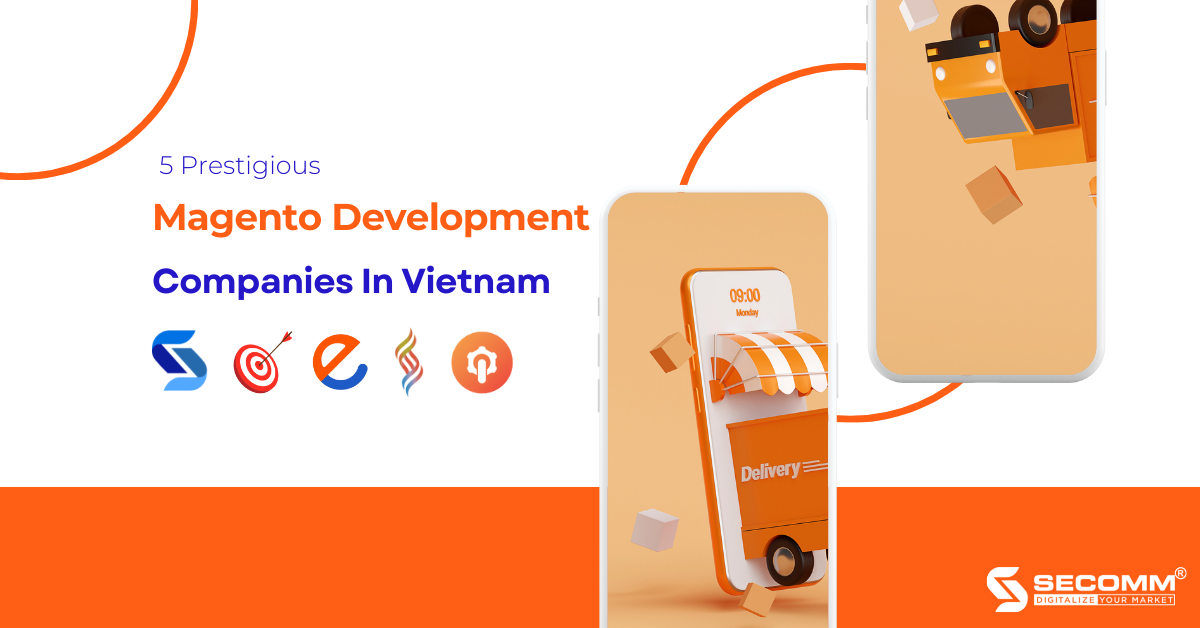
The vast and competitive eCommerce sector is witnessing the constant entry of all-sized businesses, making it challenging for many “nascent” companies to prosper in a billion-dollar market that is seen as the domain of technology giants.
Therefore, creating a professional eCommerce website is a crucial objective for new enterprises looking to take the first steps firmly, quickly dominate the market, and follow the success of the big guys.
As a result, Magento is one of the best options to consider when establishing an eCommerce website to ensure that the process is carried out successfully. It can be difficult to find a partner with strong IT skills and Magento platform development experience.
The list below details the top 5 leading Magento development companies in Vietnam that businesses can refer to make the best choice.
One of the leading consulting companies providing solutions to develop eCommerce websites with the Magento platform and Omnichannel (Omnichannel) is Kyanon Digital. through many years of operation steadily established itself as a trustworthy technology partner of many major retail groups in the Asia-Pacific region thanks to its team of qualified experts.

Magenest is a longtime technology solutions partner based in Vietnam and a leading partner of Adobe Magento, Odoo ERP, Salesforce, AWS, and Google Cloud Platform.
The company specializes in providing comprehensive hosting services and eCommerce implementation and providing package solutions in line with market trends to promote the business activities of partner businesses.
Magenest strives to support brands in achieving their goals of developing eCommerce websites with Magento. Magenest has a solid technical and consulting experience from over 30 certified consultants and developers.

BSS Commerce is an Adobe Solution Partner that provides proper Magento-related eCommerce solutions to businesses throughout the world.
The business has serviced more than 22,000 customers worldwide since its foundation in 2012, accomplished more than 500 projects, and earned the greatest level of customer satisfaction.

SECOMM is another well-known eCommerce website developer in Vietnam that is well-regarded by customers for the excellence of its work and service.
This business specializes in eCommerce consulting and offers a wide range of services, including site development, maintenance, and upgrades on platforms including Magento.
Since its establishment in 2014, SECOMM has worked with major local and foreign clients like LayByLand, Trentham Estate, An Nam Group, and others to implement eCommerce websites on the Magento platform effectively.
By simplifying all eCommerce activities, SECOMM is confident to be a reliable companion in the comprehensive digital transformation journey of businesses in Vietnam and globally.

AgileTech is a top software outsourcing company in Vietnam that has a team of experienced Magento developers who specialise in creating and maintaining high-performance E-Commerce websites.
The company is constantly up-to-date on the latest Magento features and developments, and they use this knowledge to create websites that are scalable, secure, and user-friendly during their 8-year establishment. AgileTech is committed to providing clients with the best possible Magento development experience.
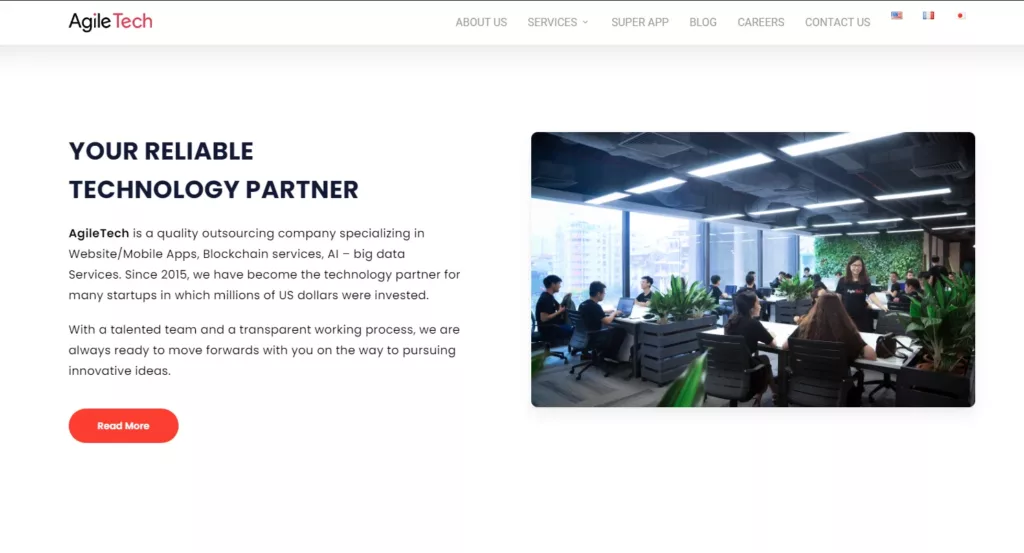
It is evident that eCommerce implementation offers businesses many advantages for entering and dominating the industry. The top 5 support firms for creating and developing eCommerce websites on the Magento platform that companies can rely on are listed above.
 2
2
 2,936
2,936
 0
0
 1
1
Exporting and trading internationally has become challenging due to the Covid-19 epidemic. In order to increase sales and find online customers, numerous companies in several industries, including the cosmetics industry, have used eCommerce.
Additionally, to support eCommerce activities and achieve the objective of growth and scalability, cosmetic retailers shift from traditional business practices to keep up with the general development trend of the global economy.
In Vietnam alone, a handful of cosmetic firms in Vietnam have demonstrated extraordinary flexibility and agility in reacting to market adjustments “despite” the complicated changes brought on by the global pandemic.
The following brands have gained the trust of and made a lasting impression on cosmetic customers by creating professional and insightful eCommerce websites.
Hasaki, a company founded in April 2016 to provide full health and beauty care for Vietnamese people, has developed secure and quick online shopping experiences with a choice of high-quality cosmetic items from many of the world’s leading brands in today’s market.
Hasaki’s eCommerce website was invested in and methodically developed from the start with the open-source platform – Magento – in order to deliver clients satisfaction in terms of comfort and efficiency when purchasing online.
More than 7 million visitors per month of traffic at a very high level demonstrate the wisdom of Hasaki’s eCommerce investment. This company’s expansion of its distribution network increased market penetration, and identification and diversification of the target customer were all made possible by sensible strategy.

The Gioi Skin Food is another well-known eCommerce site with over 2 million monthly visitors that focuses on selling cosmetics. This business worked with Haravan to create an effective eCommerce website with an easy-to-use interface.
The Gioi Skin Food has up now employed eCommerce in addition to the conventional retail shop method, which has been incredibly successful. This would enable the business to catch up with the online-to-offline (O2O) trend and raise brand awareness and revenue.

The Watsons Group, Asia’s top retail organization for health and beauty products, owns the Watsons Vietnam brand. The company desires to provide Vietnamese customers with the finest shopping experience possible while also bringing them high-quality products that are appropriate for their needs.
Notably, Watsons adopted the O2O business model right away after entering the Vietnamese market. With the goal of dominating the market, Watsons Vietnam invests in developing an eCommerce website with SAP Commerce Cloud in addition to the store system dispersed throughout the neighbourhoods of Ho Chi Minh City.
Additionally, the user-friendly and aesthetically designed interface contributes to the website’s amazing monthly visitation of more than 1 million.

The Gioi Son Moi is one of the places where people go to get lipstick that is well-known and reputable because of the guaranteed product quality and the courteousness of the staff. Every day, new products are added to the site, ensuring that there is always enough supply of well-known companies’ lipstick lines in the right hues at competitive rates.
The Gioi Son Moi also swiftly launched an eCommerce website to join the common playground of the cosmetic retail sector, in addition to two physical locations in HCMC that are constantly being renovated, extending the amount of shopping space. As a result, the website is built on the Haravan platform and has a straightforward interface that is nonetheless opulent and complex.
Also, the extremely high monthly traffic volume (more than 1 million) also demonstrates the company’s successful business strategy in the context of the market’s innovation trend.

Beauty lovers in HCMC can’t help but be aware of Bo Shop, a company that provides a broad range of high-quality cosmetics, from skincare to makeup, at rates that are specifically stated to fulfil customers’ demands for all types of beauty care.
The company quickly creates an eCommerce website using WooCommerce to keep up with contemporary business trends in order to become the top cosmetic retail brand in Vietnam.

For many years, Vietnamese consumers of cosmetics have been familiar with the name Guardian. This is a brand from the Dairy Farm Group that manufactures and distributes well-known health and beauty care goods all over Asia. In Vietnam, where Guardian first opened in 2011, the company now has more than 100 outlets.
In 2019, the business started its transformational path and parallel fusion of offline and internet business models. In order to create an omnichannel sales network (Omnichannel), Guardian focuses on building eCommerce websites with Shopify in addition to deploying potential sales channels like eCommerce platforms, apps, and fast delivery channels via GrabMart.
This gives customers more affordable, quick, and convenient home shopping options. After only a short period of time in operation, the Guardian website has attracted close to 1 million visitors each month.
Guardian has risen to the top of the industry and evolved into the biggest and most prominent retail chain for health and beauty products in existence today thanks to a significant investment in developing a multi-channel ecosystem.

Since Lam Thao Cosmetics’ formal opening in 2017, young people have come to love it as one of their favourite cosmetic shops. Lam Thao Cosmetics is continually upgrading its product line with the most affordable rates in an effort to give customers more options with the trendiest goods and improve their experience.
Along with offering high-quality goods, Lam Thao also runs an eCommerce site on the Haravan platform to enhance clients’ offline and online purchasing experiences. The success of eCommerce implementation has also helped Lam Thao Cosmetics reach a significant number of online prospects, boosting both sales and brand recognition.

For those who love cosmetics, Nuty Cosmetics is regarded as a cosmetics heaven. After operating and growing for more than ten years amid market ups and downs, the business is still a renowned source for real beauty products from well-known manufacturers in the US, Germany, France, Japan, and Korea.
The WooCommerce platform was used to create Nuty Cosmetics’ website, which has an easy-to-use interface and exceptional features that may satisfy clients when they shop online. Additionally, Nuty Cosmetics’ website offers thorough information about each product, along with clearly stated costs.
Because of this, despite the fact that there are only roughly 200,000 visitors per month on the site currently, Nuty Cosmetics has the potential to become a major player in the cosmetics industry with the correct efforts and attitude.

In the midst of the Covid-19 outbreak that was raging in 2020, AB Beauty World (ABBW) was founded with the goal of being the top family-friendly cosmetics retailer in Vietnam. The brand has not given up despite the fact that this birth appears to have occurred at the wrong time.
In fact, AB Beauty World has grown and expanded with approximately 20 branches spread throughout the city’s districts in just two years since opening the first store in HCMC, concentrating on growing eCommerce, thanks to the timely redirection.
The WooCommerce-powered cosmetics website for AB Beauty World features an interface and capabilities tailored to the sector. The website has already seen more than 150,000 visitors in the short time since it launched, which is nonetheless viewed favourably for a newcomer to the fight for digital transformation.

Beauty Garden is one of the top retail and distribution brands for real cosmetics today. Since its establishment in 2014, the company has effectively extended its retail network to be present in numerous provinces and major and minor towns throughout the nation, including Hanoi, Da Nang, Ho Chi Minh City, Dak Lak, Gia Lai, Dong Nai, and Can Tho.
In addition, Beauty Garden concentrates on developing eCommerce websites in the context of economic integration. As a result, the company’s website is expertly and systematically constructed using WooCommerce, the most popular eCommerce development platform worldwide, and is ideal for the cosmetics business.
The eCommerce implementation of Beauty Garden is seen as a sensible move since the development potential of this area is extremely great and at that time, the company had many advantages to build a business model, even though the number of users is still modest with more than 100,000/month.

All things considered, the Covid-19 pandemic outbreak has impacted and altered consumer shopping behaviours for a variety of goods. Shopping for cosmetics, in particular, has seen a significant change from physical to online formats.
The information above is a summary and evaluation of SECOMM for 10 eCommerce sites with a good reputation and the capacity to meet customers’ demands when making a decision to purchase cosmetics.
These companies demonstrate their efforts to create the technological infrastructure needed to enhance the online shopping experience as well as their well-founded optimism regarding the market’s growth potential and dominance in Vietnam.
With many years of experience in successfully implementing e-commerce for many customers in many countries, SECOMM specializes in providing consulting services with comprehensive and professional e-commerce implementation solutions.
Contact SECOMM today for free support and advice.
 37
37
 16,375
16,375
 1
1
 4
4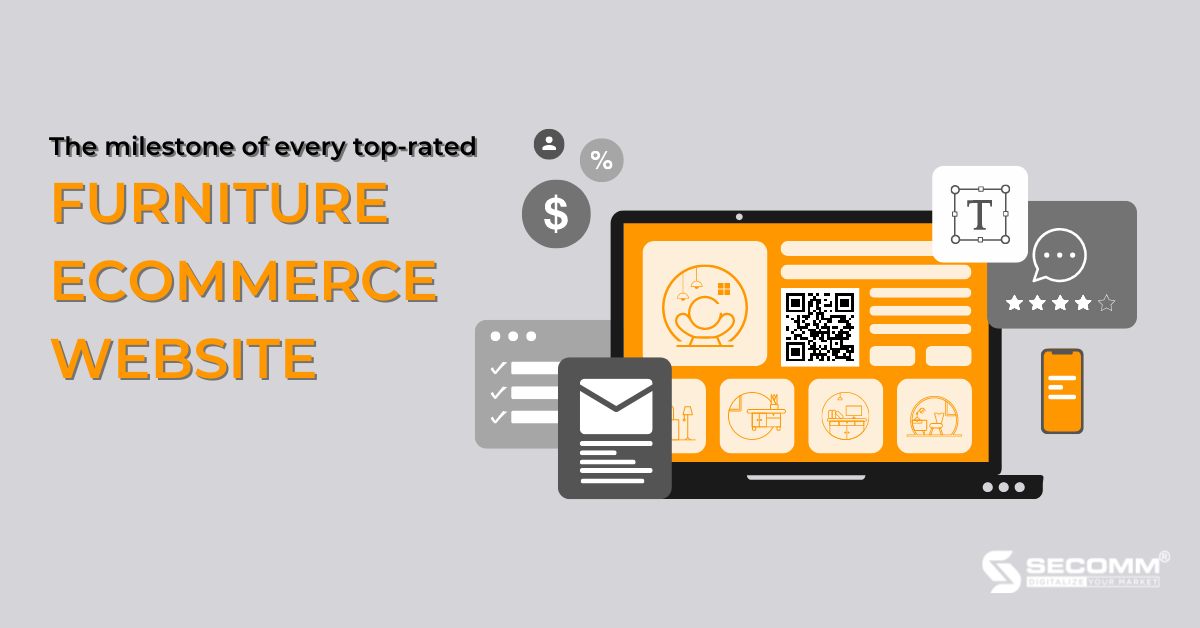
In the context of the Covid-19 pandemic, which is seen as an “obstacle” to the business activities of most businesses, eCommerce is emerging as an efficient way to enable Vietnamese furniture businesses to participate in the typical “playground” of global digital transformation.
At the same time, it is a pressing solution for furniture products to be consumed easily and accessible to many potential customers.
Therefore, the first wise step furniture brands have been hurrying to do in order to fast access the market is developing an eCommerce website. However, this difficult path calls for a significant investment of time and energy.
With years of expertise supporting several companies, SECOMM has developed a thorough process for developing a successful eCommerce website exclusively for the furniture sector.
The Covid-19 pandemic’s convoluted dynamics made travel challenging, which led to a necessity and urgency that resulted in the explosion of global eCommerce. At that point, internet buying and selling, which is more practical, takes the place of on-the-spot buying and selling.
Global eCommerce sales will rise from 15% in 2019 to 21% in 2021 and then continue to rise to 22% in 2022, according to Morgan Stanley. eCommerce will likely continue to have a large surplus. The market is established, and its growth rate might rise from its current level of 3.3 trillion USD to 5.6 trillion USD in 2026 as a result of significant company penetration in all industries worldwide.
In Vietnam alone, many service sectors had negative growth as a result of the Covid-19 outbreak, although the eCommerce market continued to grow steadily. In particular, the sector for wholesale and retail fell by 0.21%, transportation and warehousing fell by 5.02%, and that for lodging and food services fell by 20.81% in comparison to 2020.
In contrast to that doom, eCommerce has consistently grown at a pace of 16%, with retail sales reaching $13.7 billion USD in 2021. Additionally, the proportion of eCommerce retail sales in all retail consumer goods and services nationally reached 7%, up 27% from the same period in 2020. (Vietnam eCommerce White Paper in 2022).
Because of this, even if the epidemic is now under control and customers are beginning to purchase again in stores, expectations about the potential and rapid growth of the post-Covid eCommerce business are well-founded. The furniture business will not be the only one promoted to extraordinary growth from that point on.
According to Forbes, furniture and building materials have experienced the biggest growth in eCommerce sales during the past two years of the epidemic, with a cumulative growth rate of more than 200% over the year prior to the pandemic, 2019. The category of furniture and home appliances likewise experienced a remarkable cumulative gain of more than 66% compared to the same time in 2019.
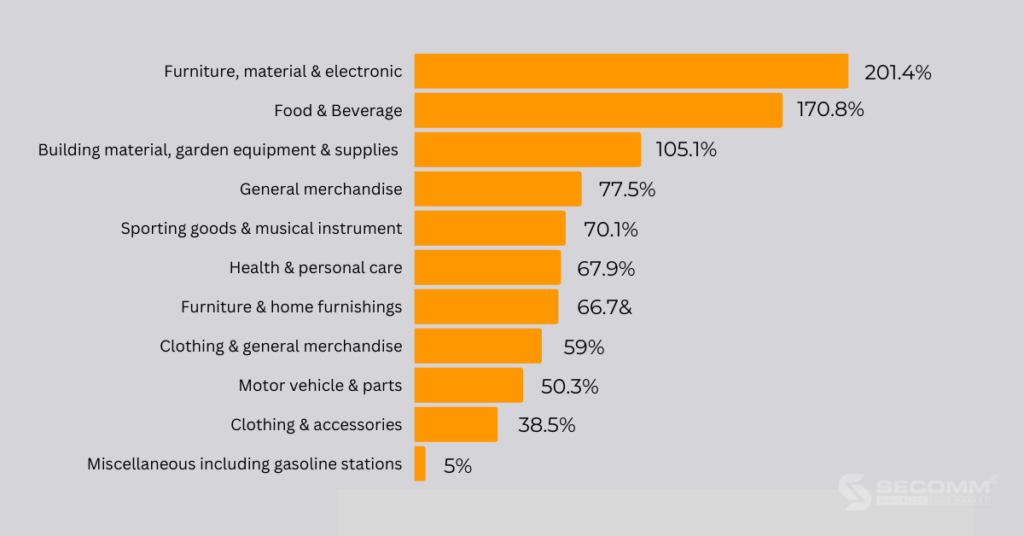
Recent findings made by Maddyness include the following intriguing details:
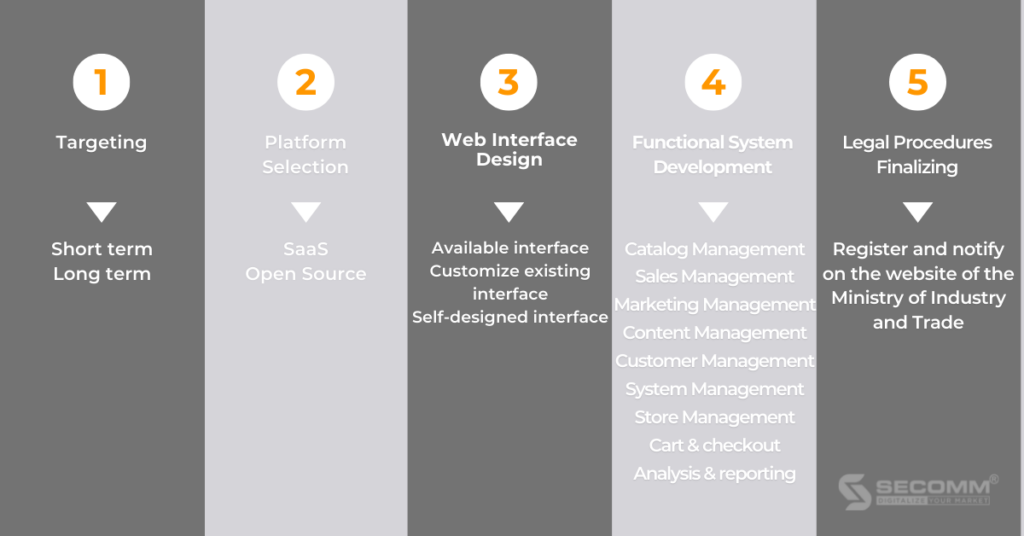
The very first thing that furniture businesses need to do is to determine their short-term and long-term goals and priorities before starting to develop an eCommerce website.
To accomplish the anticipated revenue increase in the short term, firms should place a priority on promoting marketing activities, tracking and analyzing customer behaviour, and assessing the efficacy of marketing initiatives. Furthermore, user experience is a crucial consideration that furniture companies must have in mind while advertising eCommerce.
Long-term objectives for firms could include raising brand awareness and coverage as well as evaluating the viability of individual items on online marketplaces. Effective marketing campaigns are also one of the long-term objectives that firms should take into consideration if they want to increase their online consumer base.
Businesses can take a lot of advice from specialized eCommerce implementation consulting units with a lot of experience in consulting a long-term roadmap to get the right list and priority of goals for both this period and beyond since they currently have little data to analyze and evaluate for the entire process.
There are currently two categories of platforms available on the market that enable the development of expert eCommerce websites and are highly well-liked, namely SaaS platforms and Open-source platforms. When used to create eCommerce for the furniture sector, these two types of platforms will each have the following advantages and disadvantages:
A service-based software application distribution mechanism for eCommerce commercial purposes is the simplest definition of a SaaS platform. To put it another way, the service provider develops and maintains software to aid in the creation of an eCommerce website, and the firm pays a set fee to use this service.
With SaaS platforms, the provider will own and manage the source code and data because the complete enterprise website system is hosted on the provider’s server. This means that the service provider will be in charge of handling and resolving technical issues that arise during the implementation of eCommerce by businesses.
Popular SaaS platforms are especially favored by businesses today, such as Haravan, Shopify, BigCommerce, etc.
Some of the advantages of the SaaS platform include:
The leading furniture enterprises in Vietnam using the SaaS platforms to build eCommerce websites include
However, there are still several drawbacks to the SaaS platform that should be taken into account:
Open Source Platform is software with generally available source code that enables customers to obtain, upgrade, and modify additional features required for eCommerce company needs. Instead of being produced by a single corporation, open-source platforms are frequently created by a community of developers.
In addition, because it offers extensive customization options, this platform will be perfect for creating sophisticated eCommerce website systems tailored to a variety of industries, including the furniture industry.
This means that in order to efficiently administer the website and handle technological issues, firms either need to work with expert eCommerce website builders or develop a team of highly qualified internal workers.
In Vietnam, the most popular Open Source platforms to mention are Magento, OpenCart, WooCommerce (WordPress Plugin), etc.
The outstanding advantages of the Open-Source platform:
The following well-known Vietnamese furniture companies are developing their online stores using the Open Source platform:
The disadvantages worth noting when implementing eCommerce with the Open Source platform:
Businesses should focus on making sure that the website interface conforms to UI/UX standards, clearly displays the brand’s distinctive characteristics and those of the furniture industry, and is synchronous in terms of product presentation and layout when designing the interface of an eCommerce website.
So, businesses can select one of the three methods listed below to create the website interface:
Firms should typically only use methods 1 or 2 at this point because the functional system is still in its early phases and easily found in the available interface.
In phase 1, businesses can prioritize the development of a system of basic functions needed for a complete furniture eCommerce website, specifically as follows:
The final step of building a basic eCommerce website is completing the necessary legal procedures for the website to be allowed to operate legally. Businesses can follow the simple registration steps as instructed at the eCommerce Management Portal.
This is a mandatory requirement of the Ministry of Industry and Trade for every individual or organization that owns an eCommerce website to sell goods and to perform the registration/notification obligation on time.
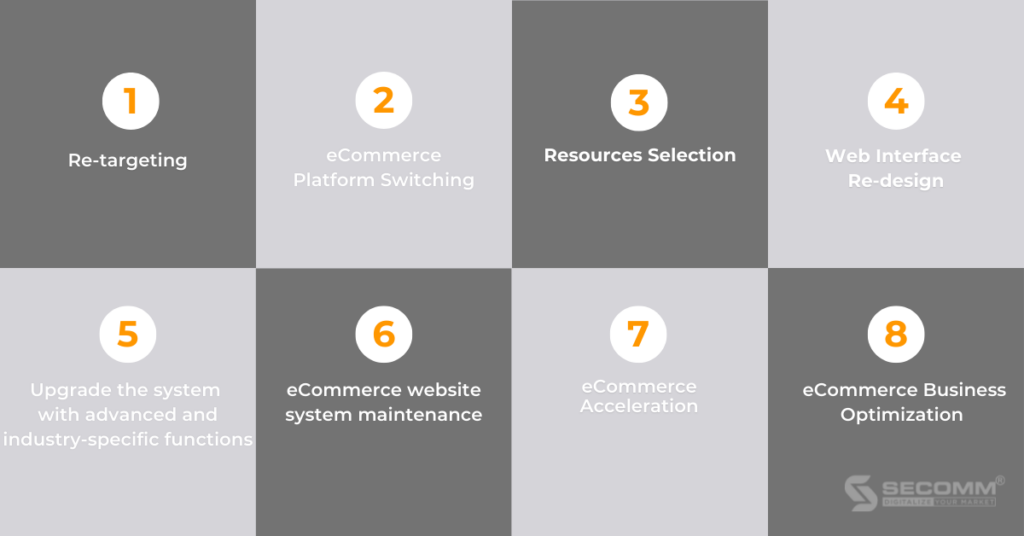
Along the journey of business development that comes with ever-changing consumer needs, business goals and strategies need to be adjusted and reconfigured to fit the current business landscape In addition, at this stage, businesses also have problems, data, and insights about their online users, so setting goals will be easy.
In the short term, companies can use efficient marketing techniques to locate and connect with a wider pool of new potential clients online and boost online sales.
In the long run, market sector expansion and building a loyal customer base might be objectives for furniture eCommerce firms. In the second step of the trip to create a successful eCommerce website, businesses will simply develop and implement marketing strategies in accordance with the product features and individual directions of each business by identifying the target market segment.
Businesses must prioritize thinking about the time and cost of investing in a furniture eCommerce website system in addition to short- and long-term objectives because at this stage, the cost and investment budget will frequently be substantial and much higher than the above basic building phase.
If a company decides to use the SaaS platform to create an internal eCommerce website in the first stage, it will not be able to satisfy the expectations for development and expansion in the second stage due to its restricted customization and capability. Businesses should now convert to an open-source platform with well-known names worth considering, such as Magento, WooCommerce, Ziel Commerce, etc., in order to create an advanced furniture eCommerce website.
Following are some criteria for furniture companies to take into account when selecting an Open Source platform:
Businesses should focus on the costs associated with switching from a SaaS platform to an Open Source platform, the time required for staff to adapt to the new platform, the risk of data loss, and any errors that may occur during the changeover.
Resource selection for the deployment of an advanced system must be made with considerable thought, in contrast to the basic system development phase. Businesses have the option of creating an internal team or hiring a professional website developer to assist them.
The business will hire and train skilled and specialized IT people on the selected platform for internal team building which requires a lot of time and money, but it will improve resource management and control and actively adapt the development of the eCommerce website system in line with the original objective.
Businesses frequently consult several eCommerce website developers before choosing the finest one for their collaboration. The needs of the businesses for an eCommerce website will thus be satisfied as anticipated, the collaboration process will go smoothly, and the businesses will gain more expertise and experience in website development from that partner, which will provide them with directions consistent with the development trend of the furniture eCommerce industry.
These are the criteria that businesses should consider when choosing: In-depth knowledge and experience in eCommerce and the furniture industry; professional working team; clear and detailed working process; ability to quickly handle problems that arise during website construction.
Businesses are not required to update the website interface while switching platforms. However, the redesign of the website interface to fit the Open Source platform is now turning out to be a beneficial piece of advice given the new company development plan introduced concurrently with the implementation of eCommerce websites at a more advanced level.
Similar to the preceding period, companies have three alternatives for designing the user interfaces of their eCommerce websites: they can use the existing interface, customize it based on the existing interface, or create their own interface. To ensure the distinctiveness of the brand and the particularity of the furniture eCommerce industry, businesses should typically use methods 2 or 3 to develop the interface at this stage.
Businesses should concentrate on establishing a system of advanced and specific features of the furniture eCommerce industry to suit the new development phase, in addition to the basic functions that have been established for the eCommerce website system in the early stages.
Businesses may better grasp the challenges of implementing intense furniture eCommerce and provide solutions to address those challenges and fulfil the market’s rising expectations thanks to advanced and distinctive functions.
As a result, companies use AR technology to improve the consumer experience. While augmented reality (AR) technology is built on virtual reality (VR) technology, it focuses on fusing the actual environment and digital data to give users the ability to view digital data in the physical world. The furniture eCommerce sector makes extensive use of this technology.
Customers now only need to download the company’s AR program, turn on the camera, and evaluate the product’s fit with the area of the house rather than physically going to the store to see the things and try them on to see whether they fit.
Customers’ buying experiences are improved and made more unique by augmented reality (AR) applications, which convert traditional marketing into interactive marketing. IKEA Place App, the furniture buying an app from “big man” IKEA, is a wonderful example because it offers clients a novel and engaging shopping experience.
Customers can use their smartphones to place and try out the more than 2,000 tables, chairs, sofas, shelves, and other household appliances in a real room, change the viewing angle, and zoom in and out. Also, the software will scale items to their true size with 98% accuracy.
A sophisticated eCommerce website system demands a great deal of experience and effort to operate and maintain. This is the procedure of continuously maintaining, updating, and upgrading the entire system to aid firms in foreseeing and resolving problems (for example, sudden increase in traffic from the promotions that stimulate shopping).
That supports sustained and persistent online sales growth, which is important for eCommerce businesses in general and furniture eCommerce in particular as they compete for a market share of this “pie,” which is “delicious” but can be challenging to consume.
Furniture eCommerce enterprises readily accomplish growth above and beyond expectations by putting into practice efficient business and marketing strategies.
Therefore, the entire process—from planning through implementation—must be structured with effective, practical solutions that have been demonstrated to work. Implementing Omnichannel, eCommerce Marketing, and SEO optimization are some suggested methods for eCommerce enterprises to accelerate growth.
The journey of developing an eCommerce website ends with measuring, analyzing, and optimizing eCommerce business activities.
Businesses can use analytics tools such as Google Analytics, Google Tag Manager, Facebook Pixel, etc., to track, update and measure website performance metrics as well as the effectiveness of marketing campaigns.
From there, the eCommerce business strategy for the next stage of development will be carefully and methodically planned thanks to clear and detailed reports & analysis.
The journey of developing an eCommerce website for the furniture sector is divided into two phases with clear step-by-step instructions. Businesses will, however, be able to go in one of two strategies, each with its own advantages and drawbacks, depending on the platform they decide to use for the first phase.
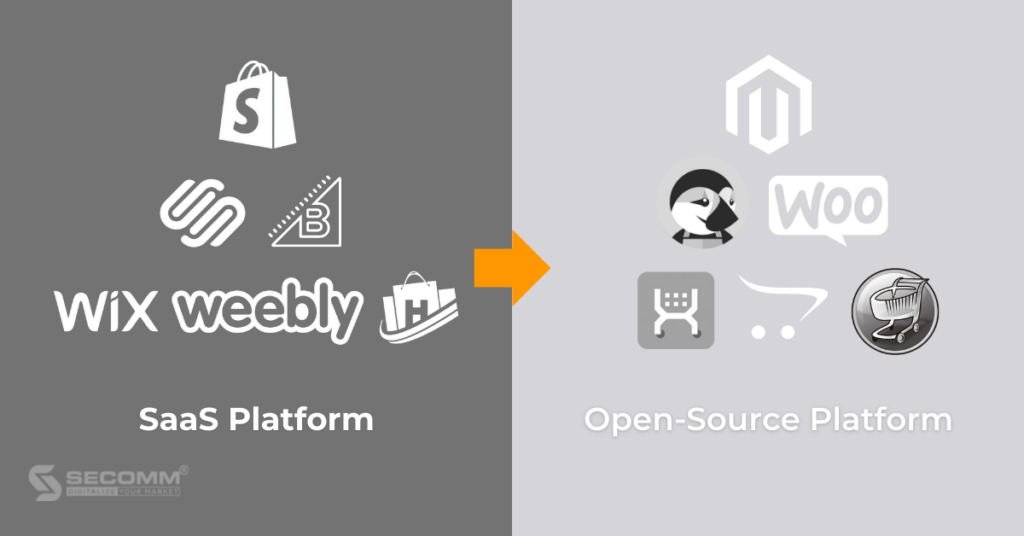
The quick deployment time of a SaaS platform is one of its benefits. In order to swiftly enter the market and create a simple website system, enterprises can pick SaaS at an early stage. Businesses will evaluate the furniture items’ suitability for the eCommerce market’s demands as well as their influence on upcoming consumer trends there.
The switch to an open-source platform will make it more reasonable to extend and develop a specialized website system in order to raise brand awareness and increase online sales over a period of time long enough for businesses to become accustomed to and adapt to the ever-changing market.
Businesses will save a lot of money by implementing eCommerce utilizing the SaaS platform early on as opposed to developing a website using the Open Source platform. Businesses can use that capital to invest in other activities, such as marketing strategy, which is one of the crucial components for the success of any company, not only furniture companies, because the initial cost of a SaaS platform is typically not too expensive.
The ability to conduct business while gaining knowledge and expertise in technology and how to efficiently implement eCommerce is another advantage of this approach to developing an eCommerce website. In general, running a business is challenging, and operating an eCommerce firm is even more challenging in today’s continuously shifting market and technologically complicated and varied trends.
As a result, acquiring knowledge and real-world experience is both a necessary and a sufficient condition for businesses to achieve extraordinary success. Because a SaaS platform is simple to use and doesn’t require a lot of technical knowledge, choosing one to deploy in the early stages can help businesses become comfortable with eCommerce terminology, concepts, and how to build a website at a basic level.
Due to the complex requirements of an extensive eCommerce website system, businesses will need support from a strong IT team during the second stage of switching to the Open Source platform. The collaborators and partners will then complement each other’s knowledge and experience at that point.
As was stated in the introduction to the platform, the fundamental functional system of SaaS platforms will not be sufficient to meet the needs of the eCommerce business at the growth and scalability stage.
Therefore, whether you like it or not at this moment, you must switch to the Open Source platform in order for the eCommerce system’s expansion and scalability goals to continue to be successfully implemented.
When adopting this approach for the process of developing and perfecting the website system, eCommerce firms in general, and furniture enterprises, in particular, should pay close attention to this first drawback.
Businesses will significantly reduce the initial cost of the working process by using this strategy. The initial benefit, though, later turns into a detriment in the long run. In addition to the ongoing platform usage fees that companies must pay for the SaaS platform, additional service costs are also significant enough to complicate and make cash flow management challenging to manage.
Because of the characteristic of the SaaS platform, customers are not permitted to keep the source code and data when switching platforms, thus enterprises must once again pay the initial development costs after the stage of moving to the Open Source platform. Additionally, the cost of development using an Open Source platform is rather costly, ranging between $30,000 and $50,000 on average.
Additionally, firms will “headache” from the sunk costs associated with switching platforms. The cost of staff training is seen as an additional expense rather than a true investment if you are accustomed to the new system, especially at a time when the economy is anticipated to rebound following COVID-19.
Furthermore, it is easy to make mistakes during the platform shift that result in the loss of crucial firm data, such as data that is closely tied to financial matters. With all the hazards mentioned, managing cash flow and maintaining balance is still a challenging issue that obviously affects furniture companies’ eCommerce business strategies.
Strategy no. 1 will be appropriate for startups or SMEs learning about eCommerce and entering the market safely based on the pros and disadvantages highlighted.
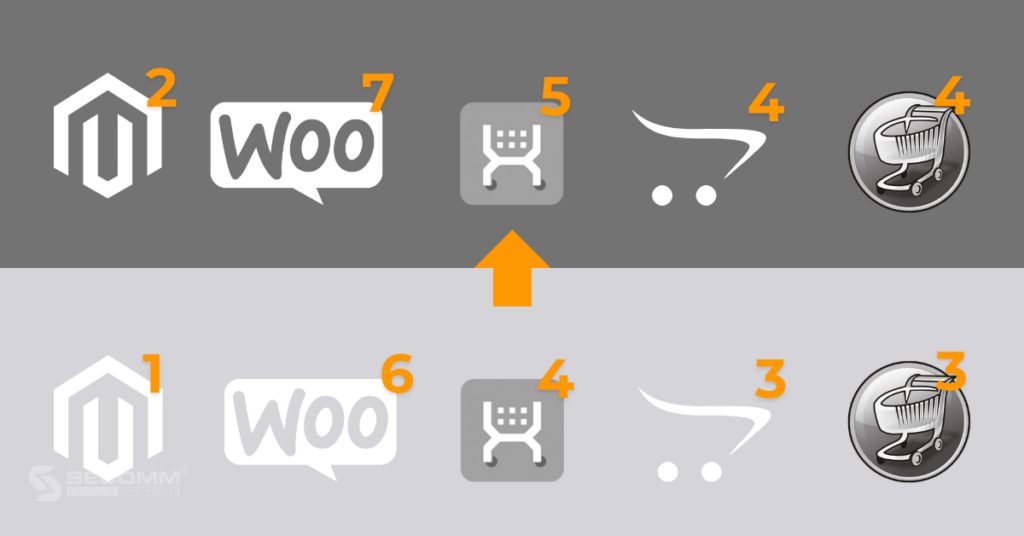
With the second strategy, companies develop eCommerce websites on the Open Source platform from the very beginning. Due to the smooth website development process, businesses merely need to gradually improve their functional systems in line with their growth and scale rather than switching platforms.
Long-term cost savings for enterprises are made possible by this seamlessness. In which, addition to saving money by avoiding the cost of starting over when switching platforms as a first strategy, firms also minimize the danger of data loss and spend less time and money training staff to use the brand-new platform.
The second approach, on the other hand, aids firms in laying a strong foundation right away with a professionally designed and smooth eCommerce website system and a team of essential technical personnel who are knowledgeable and well-trained from the start.
Similar to the first strategy, despite its notable benefits, the second one still has some drawbacks that companies should take into account before implementing furniture eCommerce. The market penetration will be slowed down if Open Source is chosen for the first phase of the deployment process.
All of the website’s features will be designed from the ground up because it will be built on an open-source platform. It takes the team a lot of effort, time, and brainpower to accomplish the entire process, which often takes between three months and a year.
Therefore, the lengthy implementation period is a drawback that slows down market entry, increasing the risk of falling behind in the competitive eCommerce race. Correspondingly, firms will have to pay a considerably larger upfront development fee than they would for a SaaS platform.
When companies must invest a significant sum of money in a platform upfront yet are unsure of its viability and effectiveness for adopting eCommerce, there is a risk involved.
From a business perspective, this drawback is viewed as an opportunity cost, meaning that while this strategy offers firms enormous long-term rewards, it also comes with trade-offs that present difficulties in the short term.
To meet growth and scalability objectives as well as avoid potential risks from switching platforms mentioned in advance, or to make the process of eCommerce implementation simple and efficient.
Therefore, it is incredibly appropriate to invest time and money in starting from scratch with Open Source.
The second approach can be appropriate for firms with a variety of business models, including B2B, B2C, and B2B2C, when the advantages and downsides are carefully thought.
With the high growth rate of Vietnam’s economy, eCommerce makes a significant contribution to promoting the flow of goods and services, supporting small and medium enterprises, especially those in the furniture sector, to seek effective business opportunities in the context of deep integration and the spread of the 4th Industrial Revolution.
Moreover, a qualified eCommerce website serves as a “bridge” for furniture companies to achieve that integration objective. However, building a comprehensive, modern, and professional eCommerce website is never simple and necessitates a significant financial investment.
The journey to develop an eCommerce website is described above in great detail by SECOMM with a few extra tips that furniture businesses can refer to shorten your own planning.
With many years of experience in successfully implementing eCommerce for many customers in many countries in recent years, SECOMM understands the difficulties and challenges in the process of implementing an interior eCommerce website.
Contact SECOMM today for free support and advice.
 2
2
 4,257
4,257
 1
1
 1
1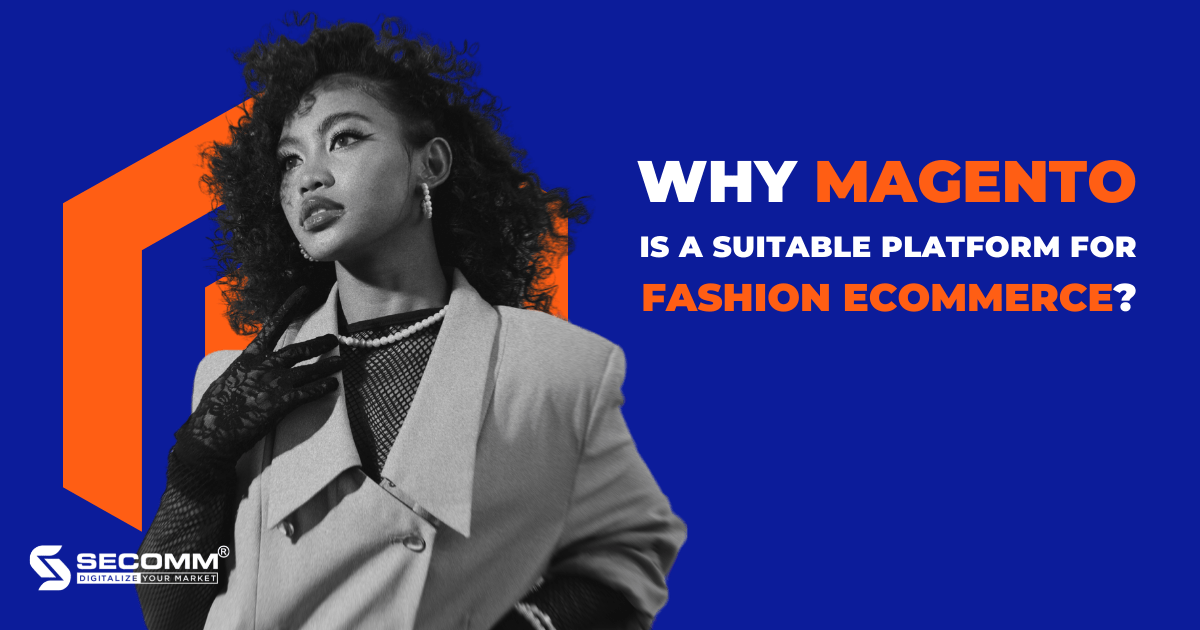
Fashion eCommerce has shown excellent development potential in recent years, with a worldwide market worth USD 759.5 billion in 2021 and predicted to reach USD 1 trillion by 2025. Clothing (+12.7%), Footwear (+11.6%), and Bags and accessories (+8.5%) are expected to increase the fastest in 2023.
Furthermore, fashion is one of the “four pillars” of Vietnam’s e-commerce economy, accounting for 43% of all online purchases, trailing only the eGrocery industry. According to the e-Conomy SEA Report 2021, 47% of Vietnamese respondents think that fashion eCommerce has become a consumer purchasing habit.
Despite the numerous prospects, this industry has multiple problems, including numerous rivals, continually changing consumer preferences, pushing firms to diversify models, Omnichannel sales to create more customer touchpoints, and so on.
As a result, to properly deploy fashion eCommerce, company managers must examine various elements, including the fundamental factor of developing a website. Among eCommerce platforms such as Shopify, BigCommerce, and WooCommerce, Magento is renowned as a platform used by many famous brands to establish eCommerce, including Canifa, Hoang Phuc International, OnOff, and others. So, why have these companies selected Magento?
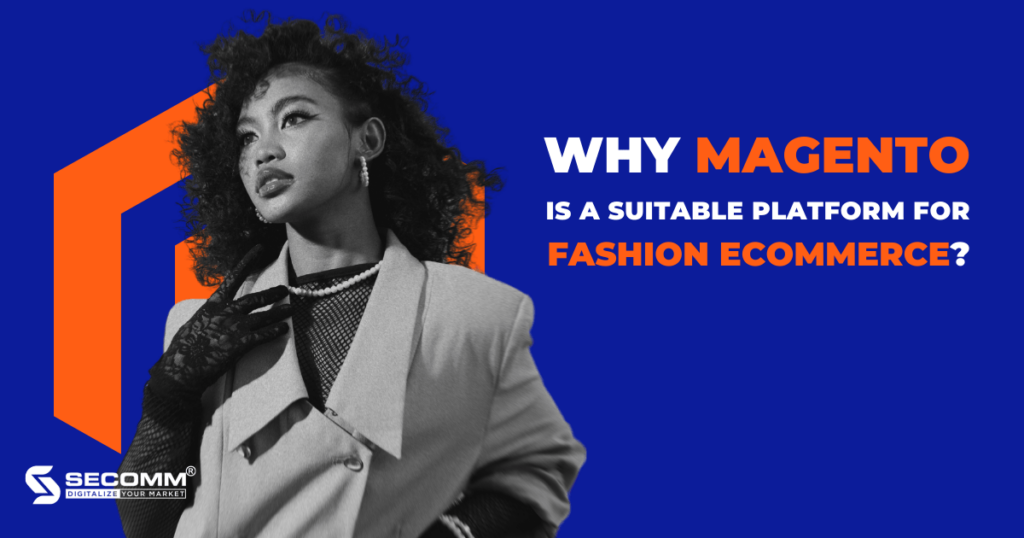
The demanding consumer base with excellent aesthetic sensibility is a common element of the fashion sector. This necessitates that fashion firms concentrate on the design of the eCommerce website interface, particularly the homepage, which must be professional and eye-catching.
The disadvantage of online fashion purchasing is that you cannot “See it with your own eyes, touch it with your own hands.” Therefore, the more detailed and colourful the image/video, the more authentic and trustworthy it will appear to buyers.
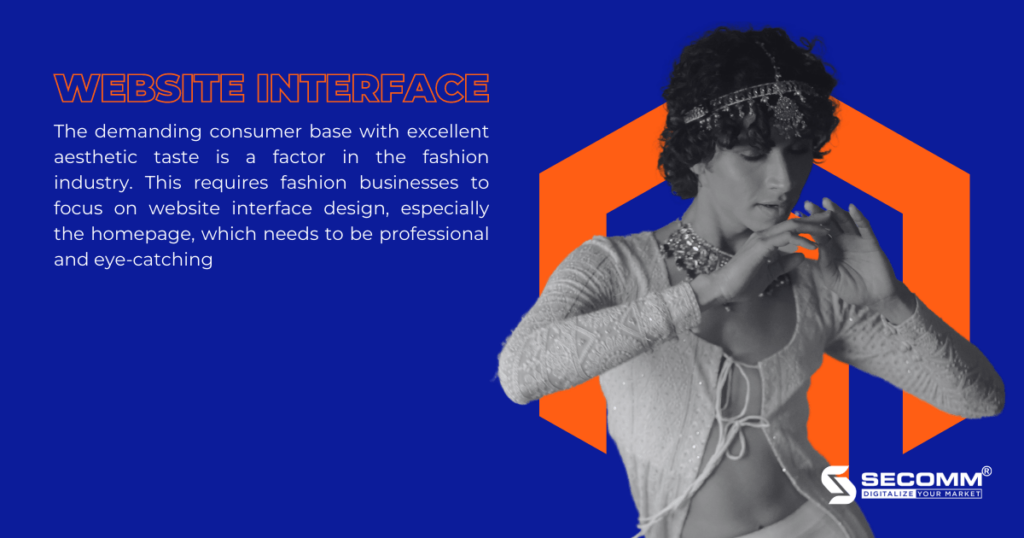
In terms of the UI (User Interface), visualisation affects the capacity of customers to engage with the website, helping to answer the question: “Has the user being able to navigate clearly from one page to another in a convenient way? “
Another website interface design is user experience (UX), from consistency in call to action button (CTA) or illustration locations, everything should be more convenient to create the most consistent experience for all website users.
Many functionalities are required for an online fashion business website to satisfy industry requirements.
The fashion sector is distinguished by multichannel sales and numerous client touchpoints. For instance, on e-commerce platforms (Shopee, Lazada, Tiki, Sendo), social networking channels (Facebook, Tiktok, Zalo, Instagram), and e-commerce websites and applications. When implementing eCommerce for fashion companies, administrators must employ an Omnichannel approach.
Usually, the fashion industry will have a lot of product categories and collections, from clothes, and shoes, to bags and accessories, so consumers’ need to search for products on the website and e-commerce app is very high. From there, businesses should build multi-layer menus and advanced product search functions by keywords or filters to serve the needs of searching and navigating customers.
Furthermore, because fashion is a highly competitive market, the more influential the communication strategies, the more orders the brand will obtain. Loyalty Programs, Livestream, Shoppertainment, Affiliate Marketing, and other fashion-related communication strategies on websites and mobile apps.
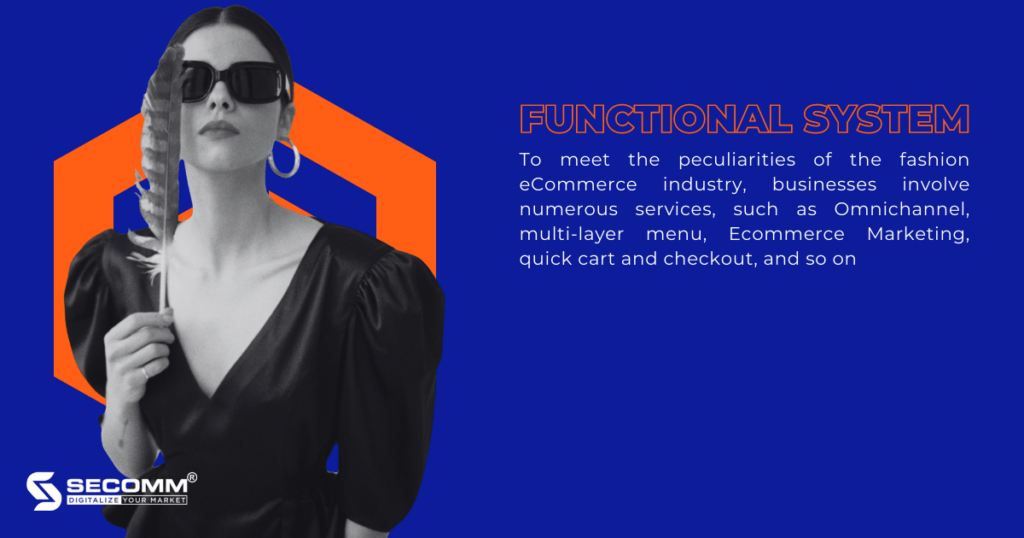
Clothing, bags, shoes, and fashion accessories are frequently low-involvement goods, thus creating a rapid shopping cart function would assist consumers to speed up the purchase process, increasing online sales for businesses.
Businesses should construct a feature to help categorise consumers to take care of and tailor the experience for each type of client in the fashion sector, which frequently has several customer groups, such as new, old, and VIP. From there, organisations will gradually use the understanding of each sort of consumer to develop better business solutions in the future.
After all, fashion eCommerce systems must frequently manage high traffic levels during peak seasons.
Businesses require a highly integrated website construction platform to properly execute fashion eCommerce, including Omni-channel, management system, payment, shipping, analytics, and reporting.
Because the fashion industry is distinct, it needs considerable coverage across all sales channels to reach many potential customers. Therefore, while implementing eCommerce, businesses have to use an Omnichannel strategy. However, to synchronise all data from front-end to back-end when deploying Omnichannel, companies require a highly linked system across all sales channels.
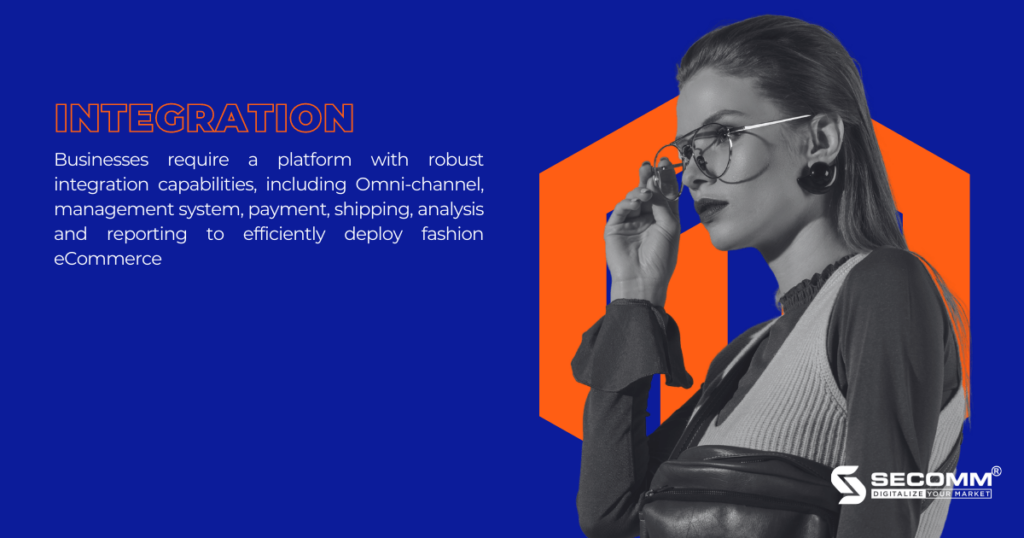
Simultaneously, fashion firms frequently utilise several third-party management systems such as POS, CRM, ERP, and BI, so businesses must find an eCommerce platform that can combine and manage all data information on” a single screen”
Furthermore, companies must vary payment and delivery methods so that clients have more options when buying fashion goods.
Finally, organisations must integrate analytics and reporting tools to provide real-time measurements with the most user-friendly reporting table. From there, firms could provide more practical guidance in the future.
Fashion businesses will have many different sizes, from startups, SMEs (small and medium enterprises), and new entrants to large corporations. Moreover, each business will have a different operating model, such as B2C, B2B2C, and so on.
All sizes and operating models will have unique requirements for each stage of brand development, so businesses need a platform to accompany them throughout the journey, preventing the circumstance of switching platforms consumes time and money when firms install eCommerce.

In summary, companies require a comprehensive platform to efficiently implement fashion eCommerce for the long run, including website interface, functional system, integration, and scalability.
When designing a fashionable eCommerce website interface on the Magento platform, businesses have many choices, including using existing themes, customising themes, and designing their own interface.
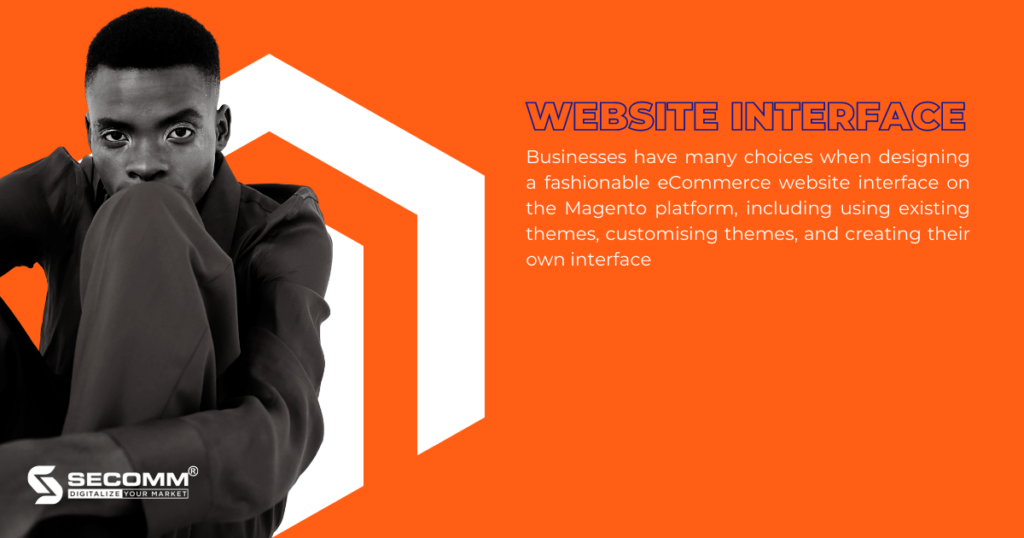
For using existing themes, companies may find these in the marketplace, developer community, or partner for Magento-specific themes in the fashion industry. This helps businesses reduce the expense of interface design, but it limits firms’ brand positioning because the interface is easily imitated by other websites.
For customising themes, businesses can save money and add brand identification aspects like colours, fonts, layout and so on. However, to efficiently set up and customise the website interface, businesses require a team with significant knowledge and experience.
For designing their own interface, businesses will have a “tailored” website for their fashion brand. However, this will necessitate a more significant investment in development expenditures and a more competent workforce.
When using Magento to develop an eCommerce website, most fashion businesses often choose a customised theme or design their own interface to support a centralised eCommerce business.
The Magento platform has all the capabilities needed to create a comprehensive eCommerce website, from essential to complex. At the same time, this platform permits the development of custom functions to tackle unique difficulties in the fashion business.
Basic features that assist businesses in running an efficient and seamless fashion eCommerce website, such as:
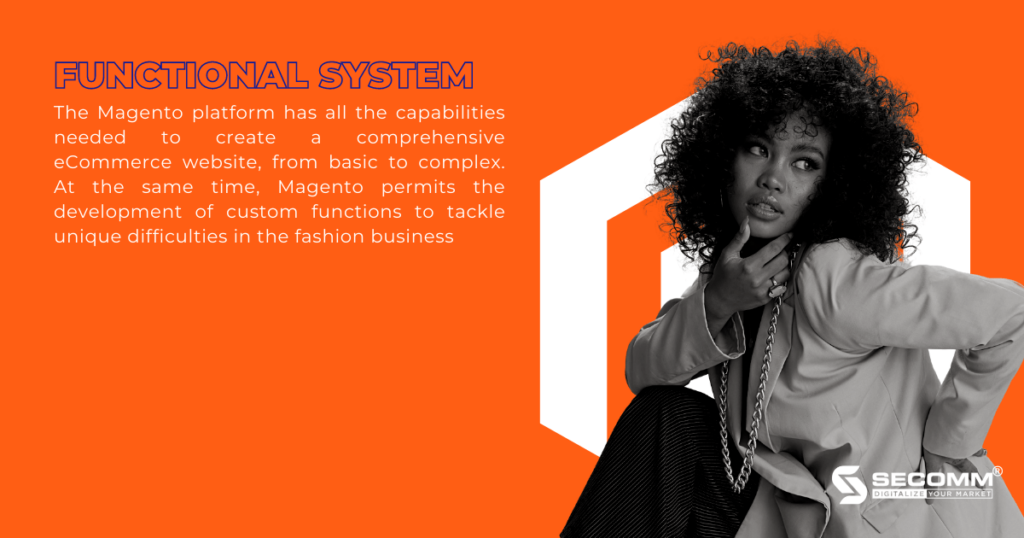
Advanced functionality that enhances the online shopping experience for consumers, such as:
Specific functions are those that assist businesses in dealing with fashion industry issues, such as:
In general, Magento can create any sophisticated functional system, with infrastructural development before and after depending on the demands of each organisation.
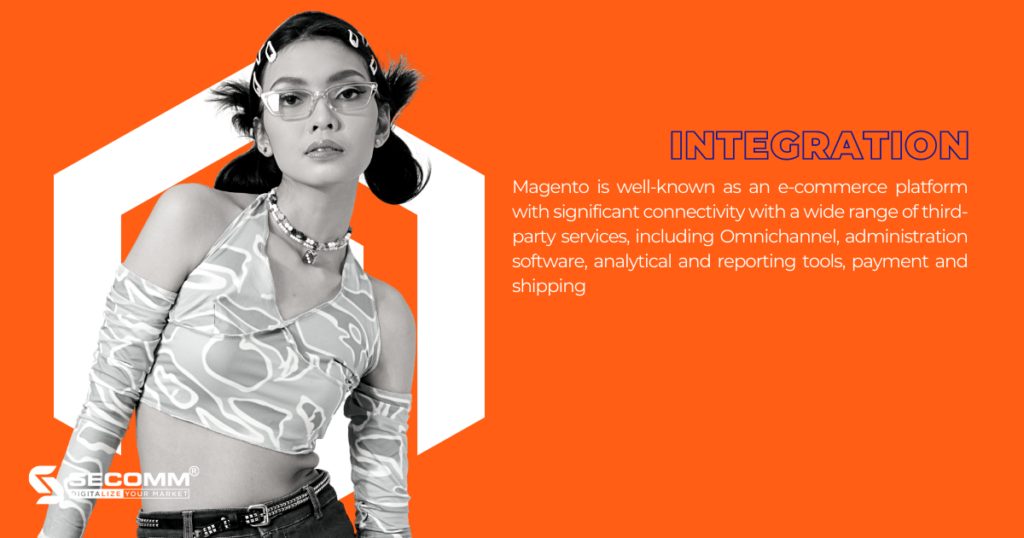
Magento is well-known as an e-commerce platform with significant connectivity with a wide range of third-party services, including Omnichannel, administration software, analytical and reporting tools, payment and shipping.
Magento allows organisations to extend from one website to many distinct websites on the same system to satisfy the requirements of company-scale development. This implies that organisations can access and manage data from a single central Magento system.
With Magento’s language-switching functionality, businesses can create an attractive eCommerce website with customer-friendly content and languages. Furthermore, the Magento system enables businesses to effortlessly exchange currencies, allowing them to grow into new markets in a variety of nations.
From then, Magento can help businesses scale and function effectively without switching to another eCommerce platform from the beginning of business through the period of expansion.
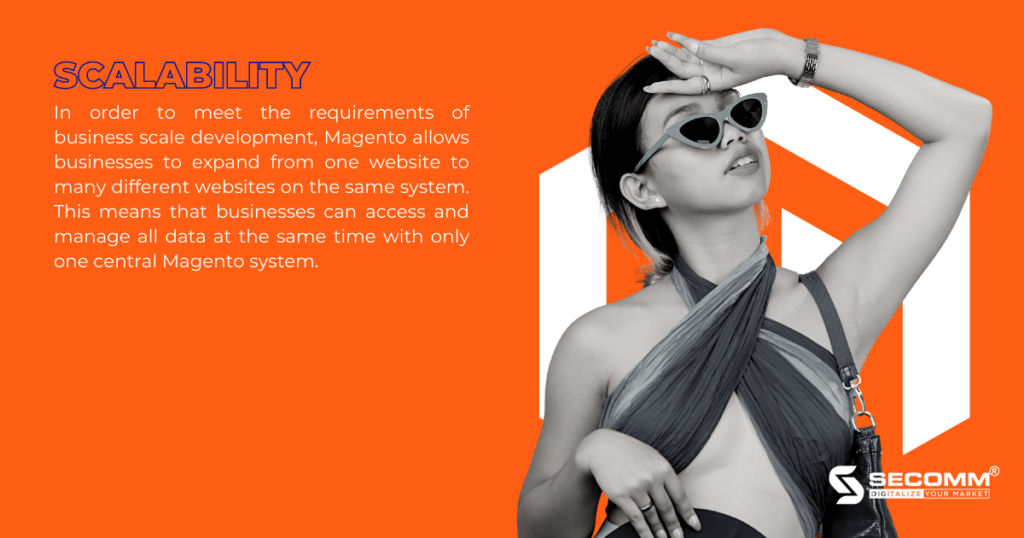
In a nutshell, Magento is an e-commerce platform that caters for the demands of all types and sizes of fashion businesses, from website interface design and functional system development to integration and scalability. However, there are numerous challenges that firms must overcome when implementing fashion eCommerce with Magento, such as high installation costs, long construction times, and the requirement for highly skilled employees.
Recognising the aforementioned business difficulties, SECOMM provides free consultation services on technology and resource solutions for each company.
Contact SECOMM now for more details!
 2
2
 6,065
6,065
 2
2
 1
1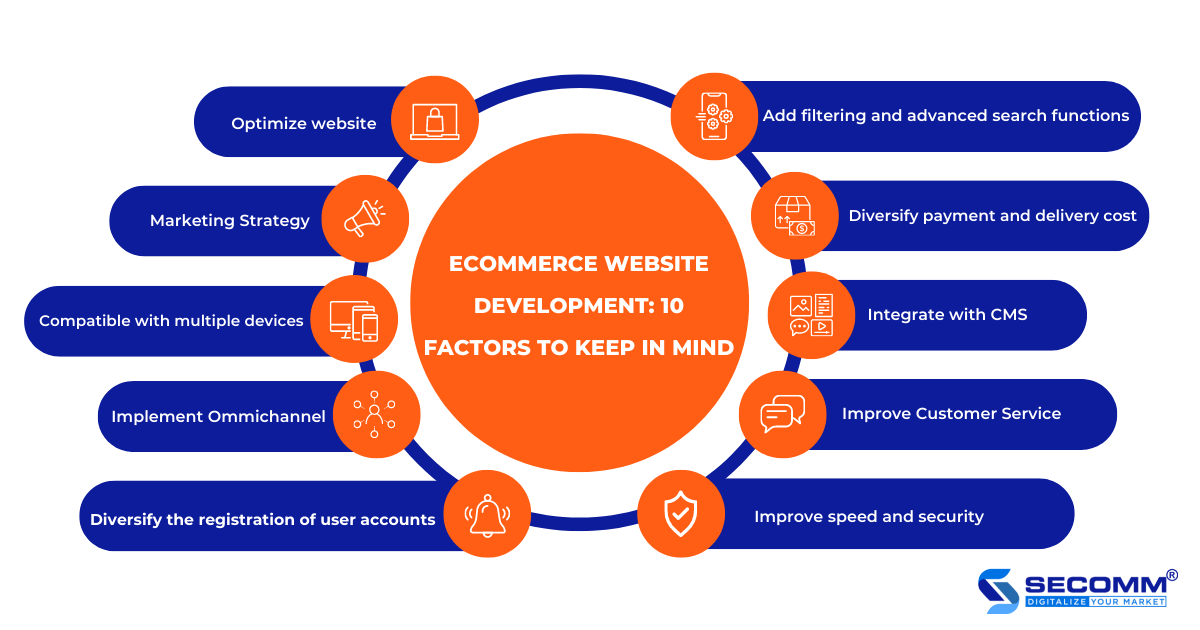
Creating an eCommerce website is a critical step in assisting businesses in spreading their brands and increasing their ability to reach potential customers on the Internet, thereby increasing revenue and profit. However, developing a business website is a complicated process with many aspects, particularly with eCommerce websites.
Businesses must consider everything from user experience to operational performance and many other aspects of the site. Here is a summary of the key factors of an eCommerce website that businesses and website developers should consider before getting started.
According to Think with Google research, if a web page takes up to 5 seconds to load, the likelihood of a user exiting increases by 90%. As a result, businesses must prioritize optimization and ensure that their eCommerce website is always operational.
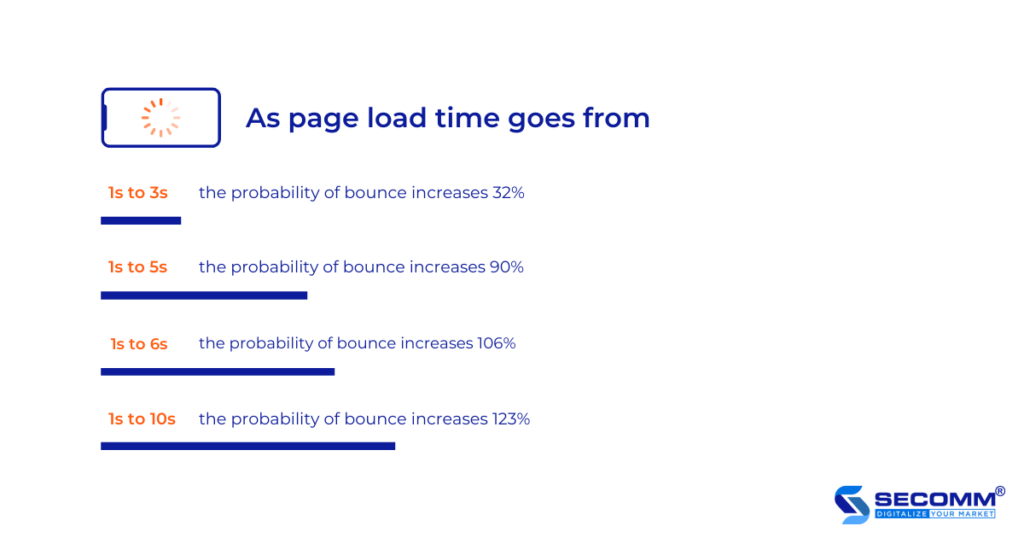
Furthermore, businesses must pay attention to optimizing SEO so that the website has the highest possible ranking on search engines using specific techniques and strategies if they want to maximize revenue on their brand websites. One of them is the strategy of incorporating keywords into the eCommerce website’s content, as well as description, title, and image information.
When adding an “alt text” description to an image, many businesses forget that customers can find their website through image search. This is also a significant flaw that results in a significant loss of potential customers.
Furthermore, in the early stages of e-commerce website deployment, businesses should consider hiring SEO experts. They can launch the website with the necessary meta tags, organize the page structure and internal links, create content strategies, design recommendations for cross-device-friendly functionality, improve page load speed, and many other critical aspects.
A good marketing strategy may benefit the first orders offline and online, particularly in eCommerce. Creating an early marketing strategy assists businesses in identifying the features that must be included in developing eCommerce systems.
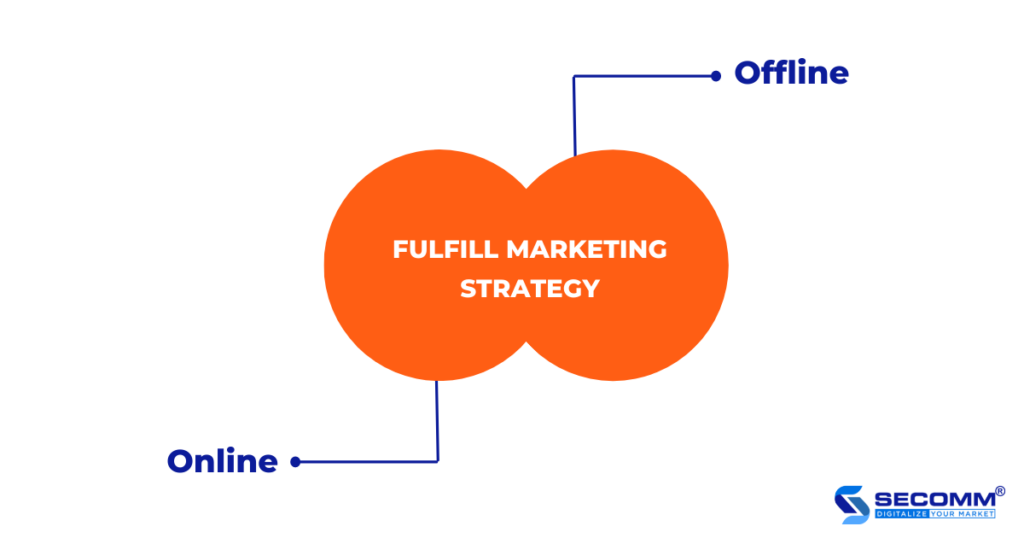
For example, when businesses want to add the option to share a promotion campaign to social networks or push notifications on mobile apps from an eCommerce website, it will be more effective if this is part of the Marketing strategy and is planned to be implemented during the development of the eCommerce website rather than proposed to be developed after the website has been launched.
According to the World Bank, two-thirds of adults worldwide use digital payments, with this figure expected to rise from 35% in 2014 to 57% by 2021. Although users prefer to make purchases via mobile apps, businesses can still increase conversions if the eCommerce interface is easily adaptable to the mobile web.
For example, after releasing a more optimized responsive design, Walmart Canada successfully increased website conversions by 20% and improved mobile order growth by 98%.
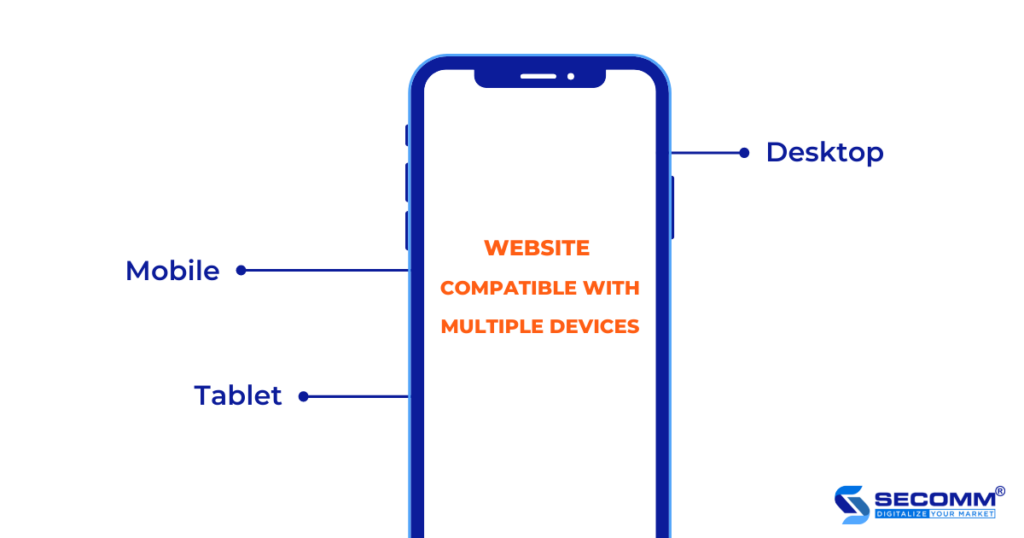
Furthermore, businesses must ensure that customers from all over the world can easily access and shop on their eCommerce website using any available browser.
As a result, businesses will conduct cross-browser testing using Google Chrome, Internet Explorer, Firefox, Opera, Safari, and other browsers to find and fix errors, ensuring customers have a great shopping experience on your website using any browser, any device, and anywhere. Businesses can hire a qualified third party to assist them, or they can conduct their own testing using a few available help tools.
In the digital age, “Omnichannel” is becoming increasingly popular and is an essential communication strategy between businesses and their customers. Every business should adopt an omnichannel strategy to connect with customers, increase traffic, drive sales, and survive the changes of the times.
As a result, implementing Omnichannel enables businesses to synchronize all sales channels for easier data management and increased eCommerce business efficiency. At the same time, Omnichannel provides customers with a seamless experience, allowing businesses to sell omnichannel and increase conversion rates.
When implementing Omnichannel, businesses can use Omnichannel platforms and systems (ETP Group, NEF, GoSELL) or choose one system as the data center for the entire system, such as an eCommerce system (Magento), ERP (Odoo, SAP).
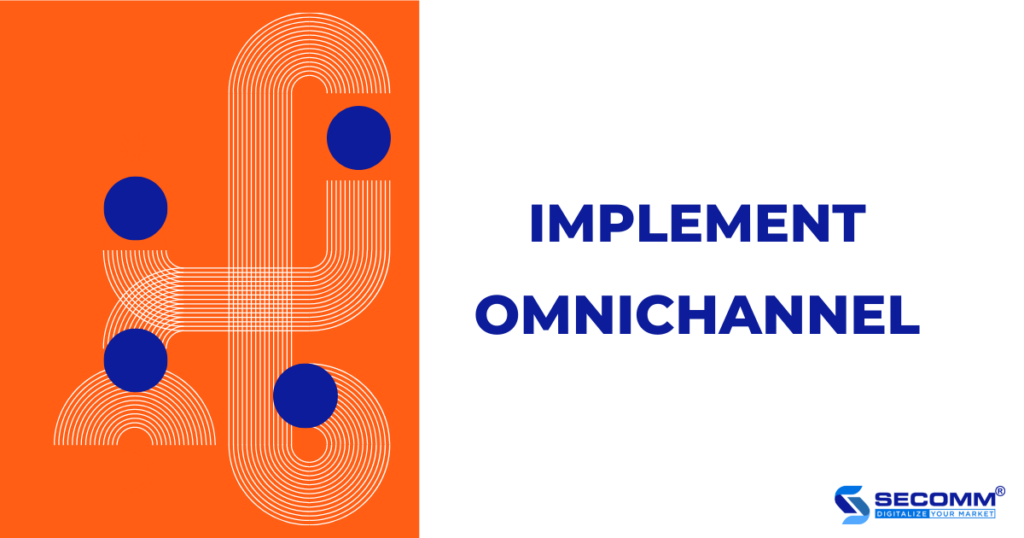
Omnichannel implementation process:
Most eCommerce websites require customers to create an account before making a purchase. This allows businesses to store the customer’s purchase history, delivery address for demographic analysis, purchase behavior assessment, sales analysis, and incentive to buy next time through Marketing campaigns.
Regular customers, in particular, will be willing to do this to reap the benefits of having an account on the website, such as quickly saving information for the next purchase or receiving notifications about upcoming big promotions. However, not all customers want to register for an account to purchase products.
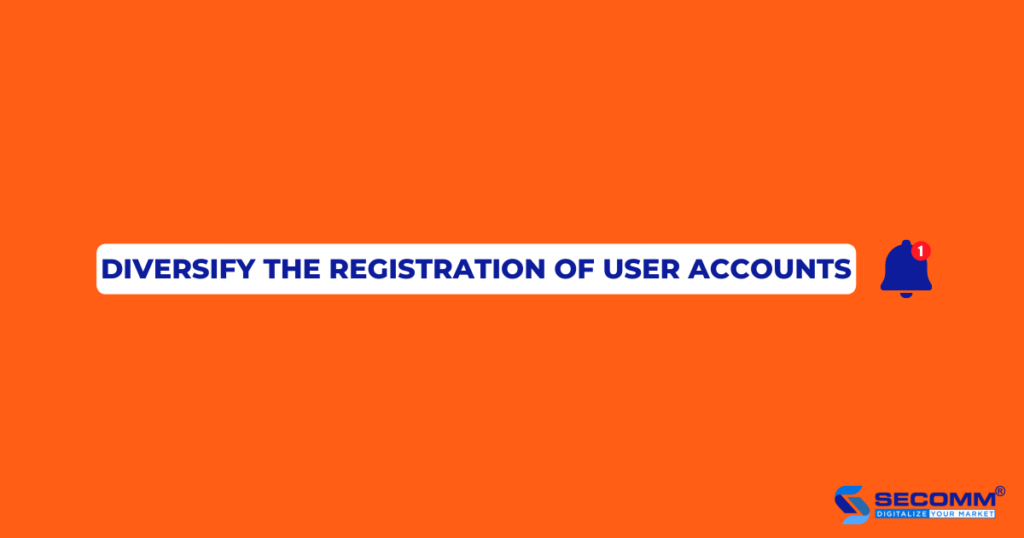
Therefore, businesses must provide options for customers who want to buy goods without registering an account, such as requiring customers to log in with a social network account or fill out a small payment form with their name, email, phone number, and address to complete the purchase process.
The eCommerce website system will automatically create an account and submit guest email login information in both cases.
Even on websites that do not sell anything, users frequently use the search bar. For businesses with eCommerce websites, the search bar must provide advanced search functionality.
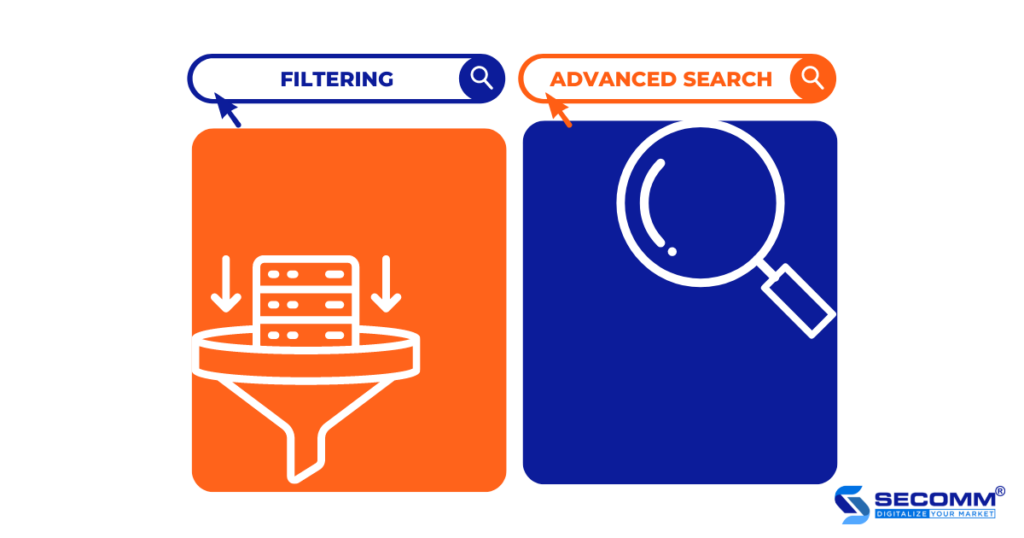
The image search feature, for example, allows users to upload a photo of a favorite item and have the eCommerce website’s search engine return products that are the same, nearly identical, or similar to the product the customers are looking for.
If users don’t know what to look for and need some suggestions, they should browse the website’s product categories. In these cases, the multi-layered product catalog function is extremely useful. In other cases, customers already have search objectives; a search bar with advanced support functions will also assist customers in finding the products they require with a few clicks.
Because online shopping and payments are becoming incredibly popular, it is critical to provide the appropriate payment options when developing an eCommerce website. According to the Payment Methods Report 2019, many shoppers abandon shopping carts because of delivery costs (55%) and complicated checkout processes (26%).
As a result, depending on the product and market that the company is targeting, the company will select a payment method that is appropriate for customers, products, and regions. The most popular payment methods in North America, according to Hostgator, are PayPal, Amazon Pay, Google Pay, Apple Pay, Visa or MasterCard, and so on.
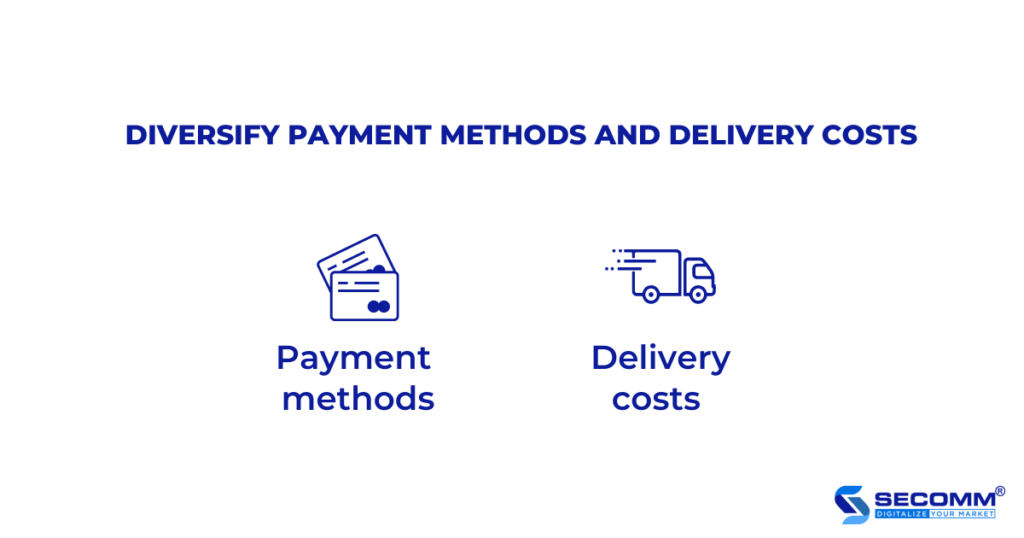
MoMo, Zalo Pay, Shopee Pay, Visa or MasterCard, and others will be particularly popular in the Vietnam market.
Furthermore, businesses should consider delivery costs because this is one of the primary reasons why customers abandon the purchasing process. Businesses can deploy flexible free shipping offers on special promotions, or if customers are required to pay shipping fees, the system should provide detailed information to avoid confusion and create a bad customer experience.
A content management system (CMS) allows you to centrally store and manage your written, visual, and document content. Businesses can change or add information, and the changes will be reflected on the eCommerce website. CMS can also help staff respond more quickly to customer feedback.
Most Internet shoppers are Millennials, Gen Y, and Gen Z. These generations value personalization, such as personalized recommendations, recommendations, or solutions from the support team.
Many eCommerce businesses are trying to meet this, the customer care department will help buyers solve problems during the purchase, payment, delivery, returns, complaints, and so on.
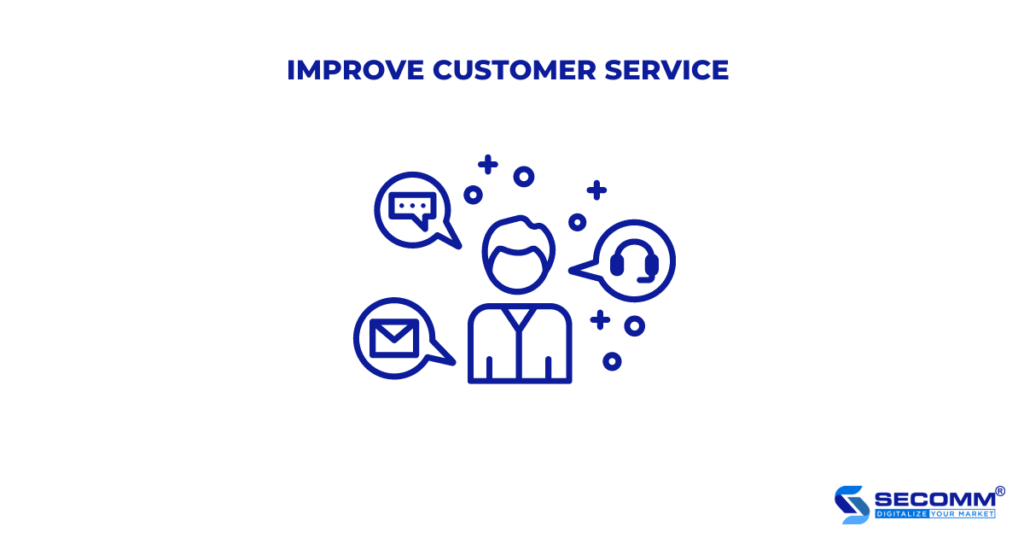
Furthermore, businesses should add a contact section to their eCommerce website with a hotline number or email that can be easily clicked or linked to the Facebook Messenger application, Zalo, live chat for orders, and general support chat for those who prefer this method of communication.
Businesses will be responsible for storing large amounts of user data and product information on an eCommerce website, so safety and security are the most important factors for any eCommerce website. Any negligence can put the company in danger of permanent data loss, and customer information can be stolen and sold.
Google and other search engines will flag an eCommerce website if it is deemed unsafe and has poor security, such as no SSL certificate and HTTPS protocol. This is considered a warning or recommendation for Internet users to be cautious about accessing websites that lack the above two components, as a result of which businesses will easily lose a large number of potential orders, causing marketing disruption and affecting the brand’s reputation.
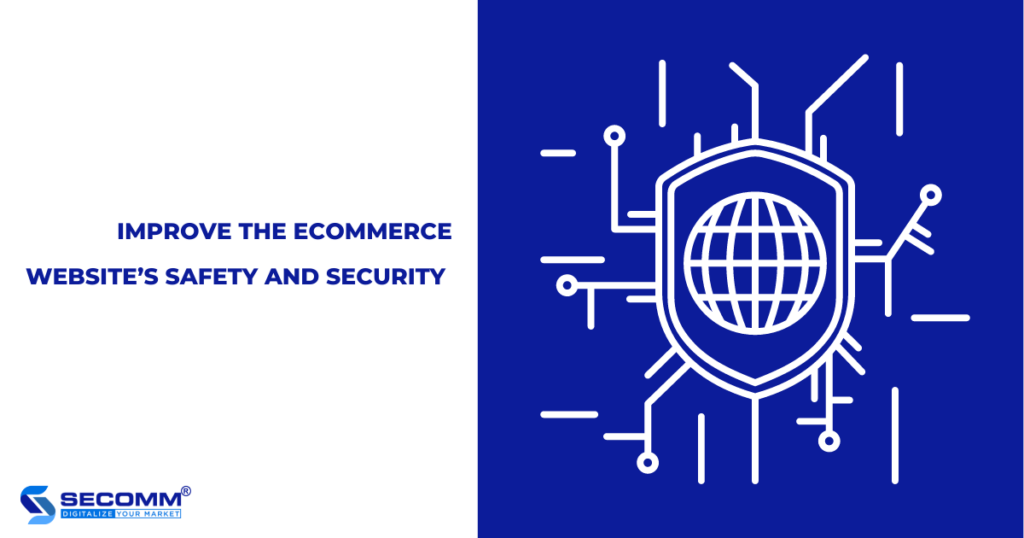
Furthermore, businesses must register an eCommerce website with the Ministry of Industry and Trade at the eCommerce Management Portal to demonstrate the website’s transparency following Vietnamese Government Decree 52/2013 ND-CP.
The 10 essential factors listed above are those that businesses must consider when implementing eCommerce. In reality, even when businesses use WordPress, the Woocommerce plugin, or a SaaS platform like Shopify, it is not easy to create an eCommerce website with full features that work well to attract customers. If your business decides to hire a website development company, that company must be capable of creating a comprehensive eCommerce website in terms of both design and functionality.
With many years of experience implementing eCommerce in many countries, SECOMM provides free consulting services with professional eCommerce solutions.
Contact us today for free support and advice!
 2
2
 4,921
4,921
 0
0
 1
1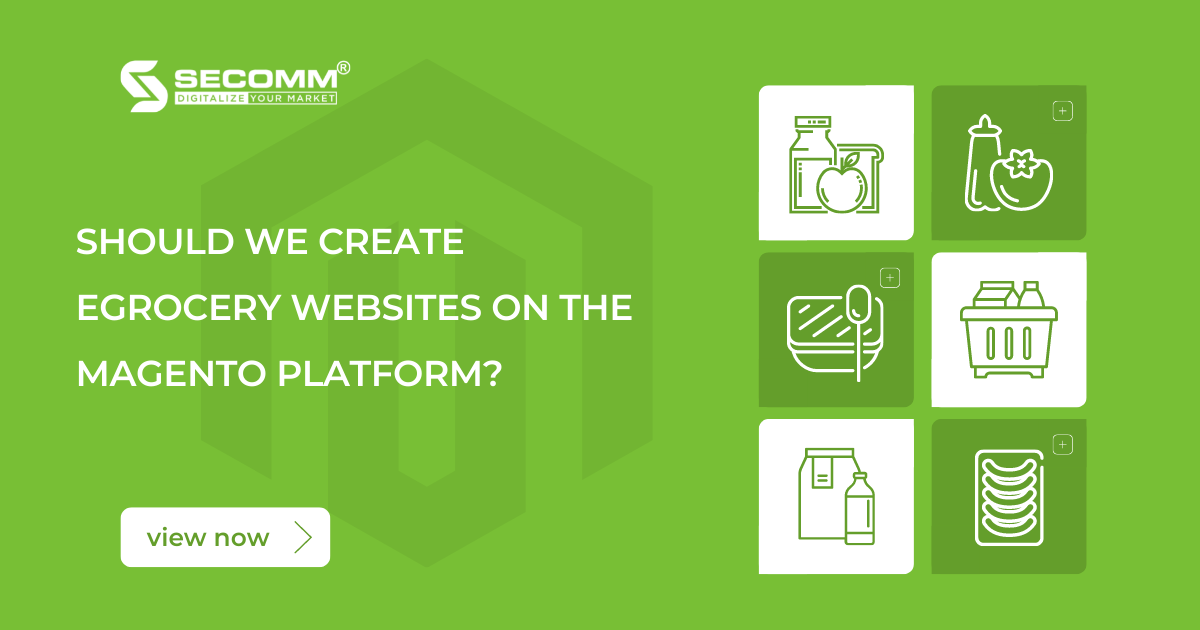
The growth of the grocery eCommerce industry in the Vietnamese market in 2021 is undeniable. According to the Google report, online grocery-related searches will increase by 223% in 2021, 3.6 times in June, and 11 times in July during Vietnam’s lockdown due to Covid-19 in several provinces.
Recognizing the market’s enormous potential, the need for a professional eCommerce website for online grocery businesses has grown significantly to expand the business system, supporting digital transformation and long-term revenue growth. Some of Vietnam’s largest grocery businesses, including Annam Gourmet Market, Bach Hoa Xanh, Organica, Farmer’s Market, and WinMart, have led the way in developing an eCommerce website system and have seen great success.
Choosing the right platform to build an eCommerce website makes the above brands successful. Platforms play a significant role in developing and operating an effective online grocery website. Along with well-known names such as Shopify, BigCommerce, and WooCommerce, Magento is considered the best online grocery support platform.
Businesses have many options when designing the eGrocery website interface on the Magento platform, including using available themes, customizing themes, and creating their own.
Businesses can find Magento-specific themes in the grocery field, developer community, or partner using available themes. It helps businesses reduce the cost of interface design, but it limits businesses’ brand positioning because the interface is easy to duplicate with other websites.
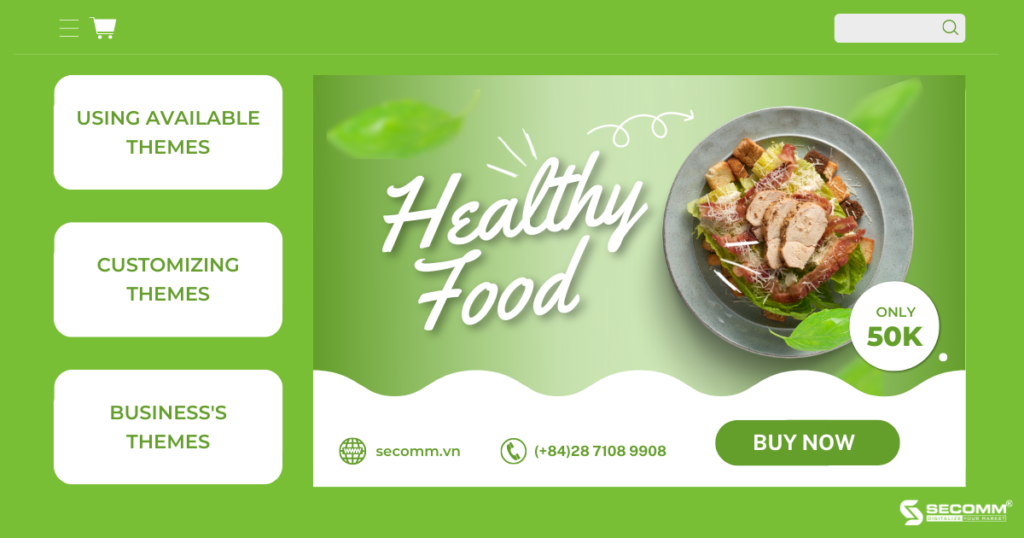
Businesses can save money and add brand identity elements such as colors, fonts, layout, and so on by customizing their themes. However, businesses need a team with extensive Magento expertise and experience to set up and customize the interface efficiently.
Businesses will have a one-of-a-kind website for their brand if they design their interface. However, it will require an enormous investment in development costs and a professional team.
When choosing Magento to develop an eCommerce website, most grocery stores often customize or use their themes to support an in-depth eCommerce business.
The Magento platform provides a comprehensive set of features, ranging from basic to advanced, for the development of professional eCommerce websites. Additionally, Magento allows you to create custom functions to solve specialized grocery industry problems.
Basic functions to assist businesses in running an efficient and smooth website system, such as
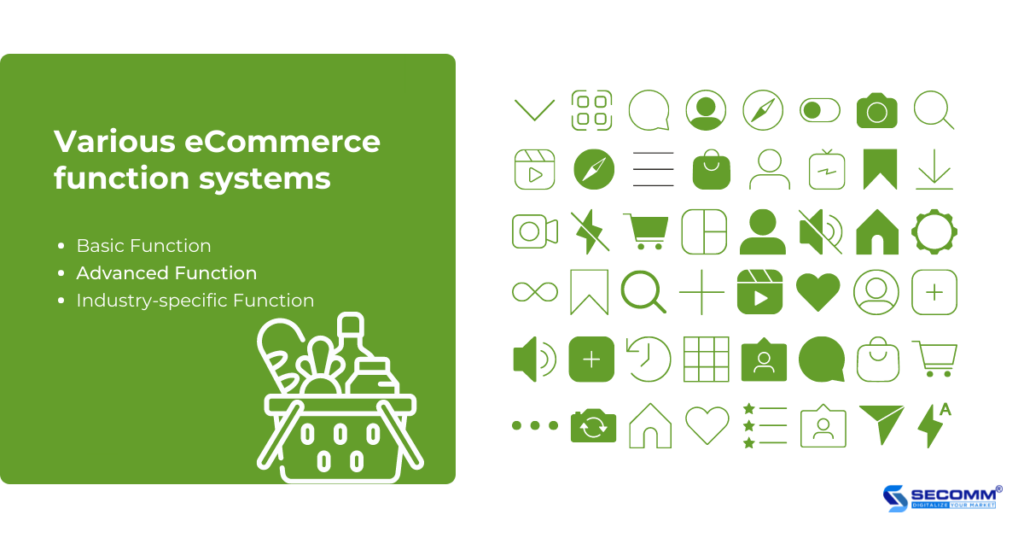
Advanced functions that improve consumers’ online shopping experiences, such as advanced search (Elasticsearch, live-search), MSI (Multi-Source Inventory), abandoned cart, similar product recommendations, PWA (Progressive Web Apps), multi-layered product catalog, and so on.
In addition, industry-specific functions assist businesses in dealing with their problems and reducing mistakes in the online grocery industry, such as order tracking, fast delivery, delivery time and location options, etc.
The high flexibility of Magento open source is an outstanding advantage that helps the system not only operate effectively at present but also expand the system to accompany businesses in the future.
Grocery businesses can fully integrate 3rd party services with Magento, making eCommerce operations efficient and smooth:
Marketing: Integrating with marketing software from Email Marketing (Mailchimp, Getresponse) to advertisement (Facebook, Google, Zalo, Tik Tok) to optimize eCommerce business
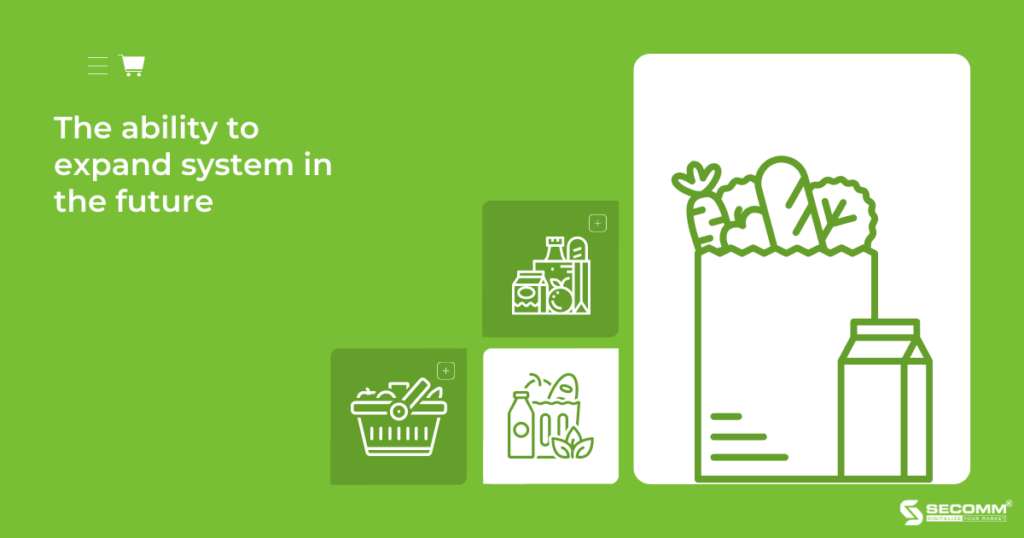
Besides that, Magento also allows businesses to expand from one website, and one store to many websites, and stores, and convert multi-language, and multi-currency flexibly while still being able to manage all data at the same time.
As a result, Magento is a suitable platform for a wide range of business models, including B2C, B2B, B2B2C, and O2O, as well as a wide range of business sizes, including new businesses entering the eCommerce market, startups, SMEs (small and medium enterprises), and large corporations.
In the path to building a website, security is another significant benefit that makes the Magento platform the preferred platform for online grocery stores.
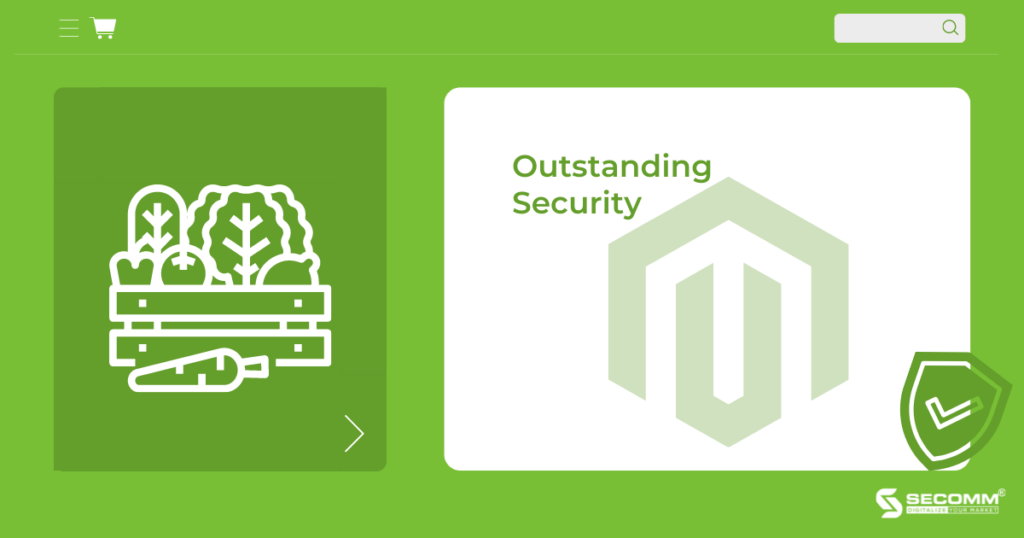
Magento includes a security scan tool that helps identify problems and propose security solutions to handle arising errors, effectively optimizing the security of grocery eCommerce websites. Moreover, to improve admin account security, Magento requires admins to use advanced passwords with at least 7 characters, including letters, numbers, and special symbols. Simultaneously, password complexity can be added to lowercase and uppercase passwords or re-login after a certain amount of login session time. Furthermore, Magento supports two-factor authentication, such as OTP or CAPTCHA code, to strengthen the security of the grocery eCommerce website system.
The Magento platform has a worldwide developer community that includes many experienced and professional Magento developers.
Magento is also part of the Adobe ecosystem, helping businesses easily access new technology trends and use Adobe’s available application store.
With such a strong development community, online grocery store businesses will receive the most assistance in resolving technical issues and consulting on building eCommerce solutions that are appropriate for their business model.
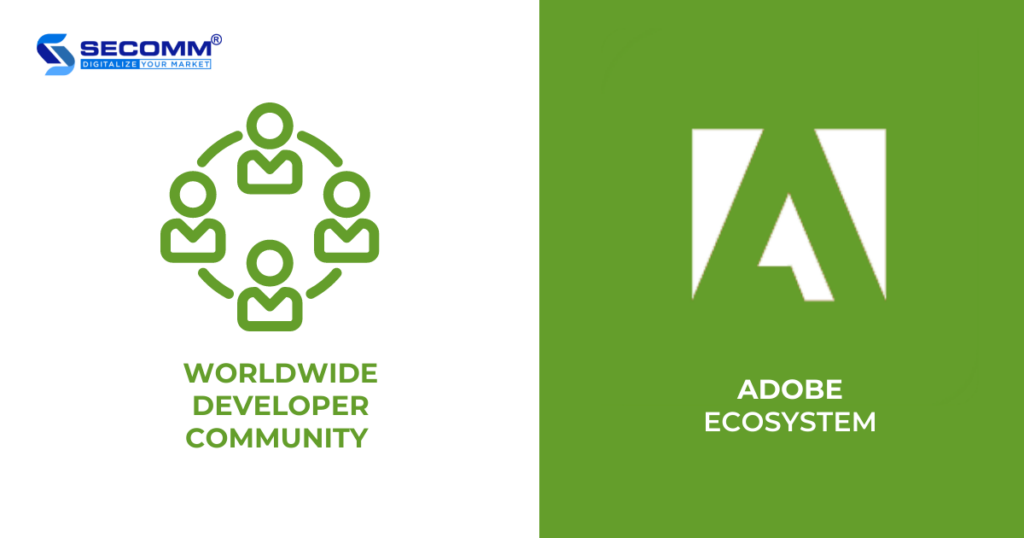
Although Magento is highly appreciated for its features and performance, the cost issue is still a significant obstacle that makes many eGrocery businesses hesitate to choose Magento.
Implementing a complete eCommerce website system built on Magento costs between $10,000 and $250,000.
| Cost | Magento Open Source | Magento Commerce | Magento Commerce Cloud |
| User licenses | Free | $22.000 -$125.000/yr | $40.000-$190.000/yr |
| Hosting | $100-$500/yr | $500-$6.500/yr | Free |
| Domain | $10-$400/yr | $10-$400/yr | $10-$400/yr |
| SSL Certificate | $50-$300/yr | $50-$300/yr | $50-$300/yr |
| Creating website | $5.000+ | $5.000+ | $5.000+ |
| Developing website | $1.800-$10.000/yr | $10.000+ | $10.000+ |
| Extensions | $60-$600/ea | 60-$600/ea | 60-$600/ea |
| Total | $10.000-$17.000 | $33.000-$149.000 | $50.000-$207.000 |
The table comparing Magento construction costs
A complete Magento project typically requires 3 to 6 months, with some projects requiring up to a year. As a result, businesses frequently waste time because of the complex functional system and the scarcity of Magento experts.
Businesses require a professional team with a deep understanding of Magento as well as practical experience on highly complex systems to implement an effective eGrocery website using Magento.
Although Annam Gourmet has previously owned a website, it is primarily used for brand development, and the effectiveness of eCommerce activities has not been prioritized. As a result, this website system is not comprehensive and is limited to crucial eCommerce functions. Furthermore, to transition into the “new normal”, Annam Gourmet must expand its online sales channel more intensively and effectively.
In order to meet the needs mentioned earlier, as well as to support the company’s long-term development goals in the Vietnamese market, Secomm and Synova successfully built a complete eCommerce website system on the Magento 2 platform.
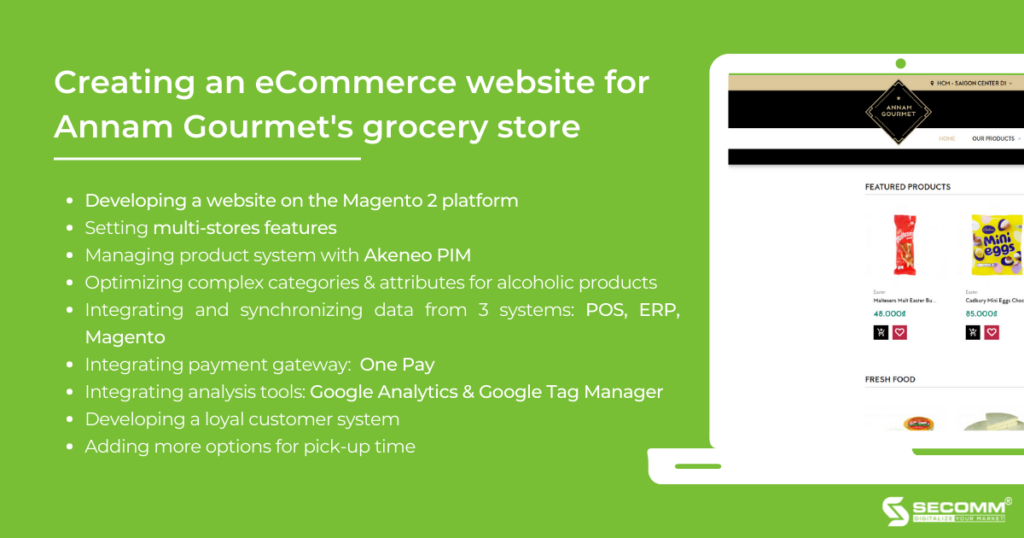
The Magento 2 website system is operationally stable and effective with other components in Annam Gourmet’s operating system. As a result, Annam Gourmet’s eCommerce website, with typical grocery industry elements, is capable of meeting all business needs, such as operating effectively in a highly complex system, quickly processing huge amounts of data about products, customers, and orders, and seamlessly syncing with ERP, CRM, POS, and so on.
In general, when building a grocery eCommerce website with Magento, businesses can master everything from interface design to feature system, leveraging a diverse ecosystem, a system capable of flexible customization, and superior security. On the other hand, businesses must prepare and invest in a budget, time, and team to successfully and effectively implement it.
Our company – SECOMM, has been partnering with many big enterprises such as An Nam Group (Vietnam), Jasnor (Australia), and Changi Airport Group (Singapore). As a result, we are aware of the challenges and worries firms face while developing an eCommerce website system.
Get in touch with us now for FREE eCommerce consultancy and solutions in eGrocery businesses.
 2
2
 4,443
4,443
 0
0
 1
1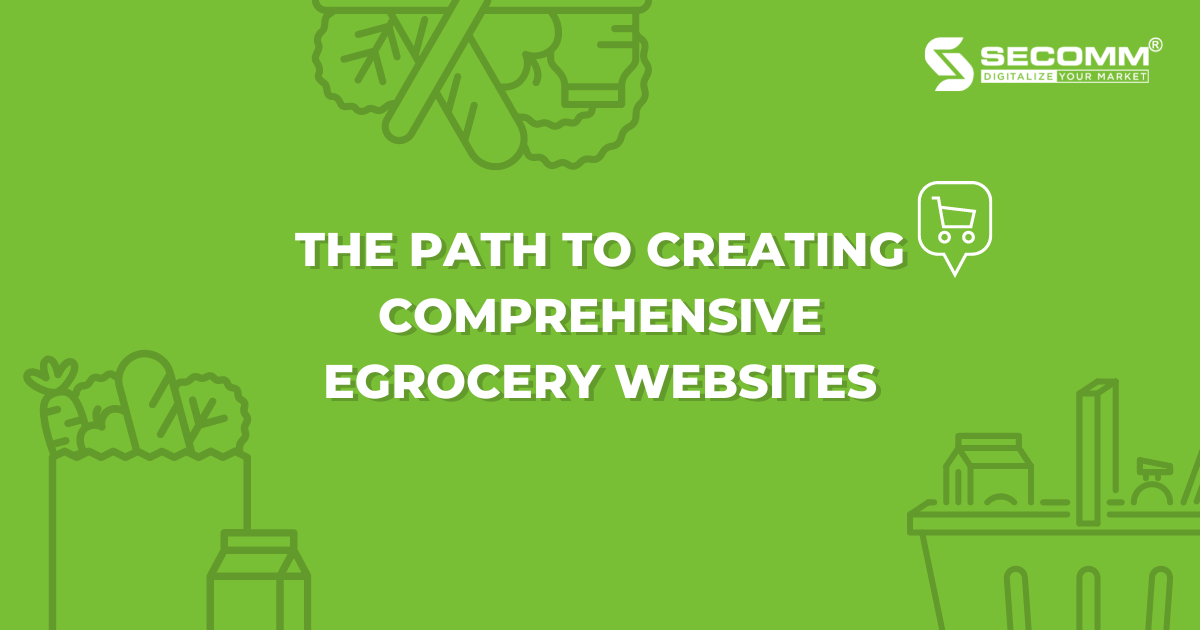
According to Statista, the size of the Vietnamese ecommerce market in 2021 was $13 billion and is expected to reach $39 billion in 2025, ranking second in Southeast Asia behind only Indonesia. The spectacular breakthrough of the grocery eCommerce industry has coincided with the explosion of the eCommerce market. As a result, online grocery shopping has become a part of 53 percent of consumers’ habits.
Grocery companies should create their eCommerce website as soon as possible to jump into the bigger game and develop online grocery business activities to capitalize on the enormous potential of the eGrocery market and gradually transition to digital transformation.
SECOMM has outlined the journey to create a comprehensive eGrocery website for the Vietnamese market with over 7 years of experience in eCommerce.
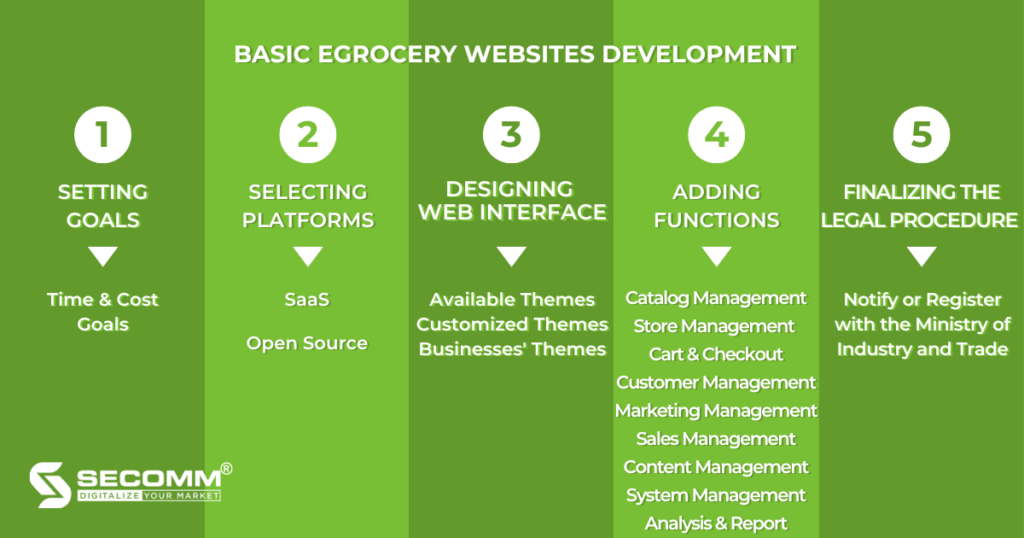
The first step for grocery businesses is to set goals and prioritize those goals to plan the result of an appropriate eCommerce website for each stage.
Businesses can consider long-term goals such as brand positioning, exploitation of potential customers, and product online business capability.
Short-term goal activities such as revenue growth, customer monitoring and analysis, campaign effectiveness evaluation, and so on should prioritize by businesses.
Furthermore, the user experience factor, which includes services such as payment, logistics, online customer care, and so on, is critical to increasing interaction, support, customer consultation, and problem resolution as quickly as possible.
In terms of duration, businesses can choose to deploy quickly to penetrate the eGrocery market or gradually adapt to the market at this stage. When deploying a grocery ecommerce website, the budget will be determined by each business’s strategy and financial potential.
Two popular platforms assist businesses in developing eCommerce websites: SaaS (Software as a service) and Open Source. Here are some of the best Saas eCommerce platforms: Haravan, Shopify, and BigCommerce.
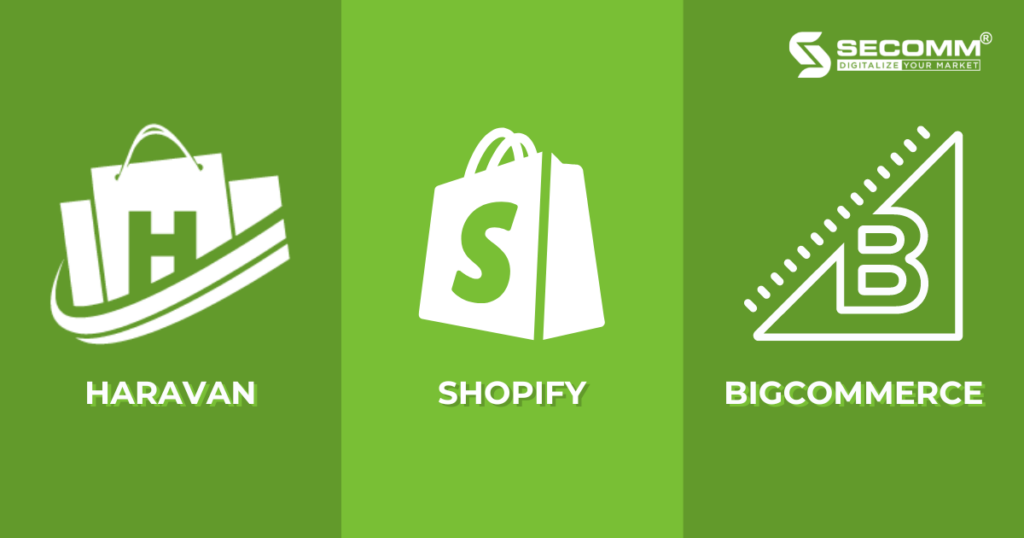
Open Source eCommerce Platforms widely used in the Vietnamese market include WooCommerce, OpenCart, and Magento.
Due to the significant differences between SaaS Platforms and Open Source Platforms, stage businesses prefer to use SaaS Platforms in the initial stages of basic eGrocery
Businesses have to meet the following criteria when designing the website interface: UI/UX standardization, displaying the brand’s and the eGrocery industry’s characteristics, and product presentation synchronization to provide the best experience to customers.
There are three approaches to designing the interface: using available themes, customizing themes, or creating their own. Businesses frequently use the available themes in this stage to save the most money. Still, some companies with financial potential will choose the other two options for better branding.
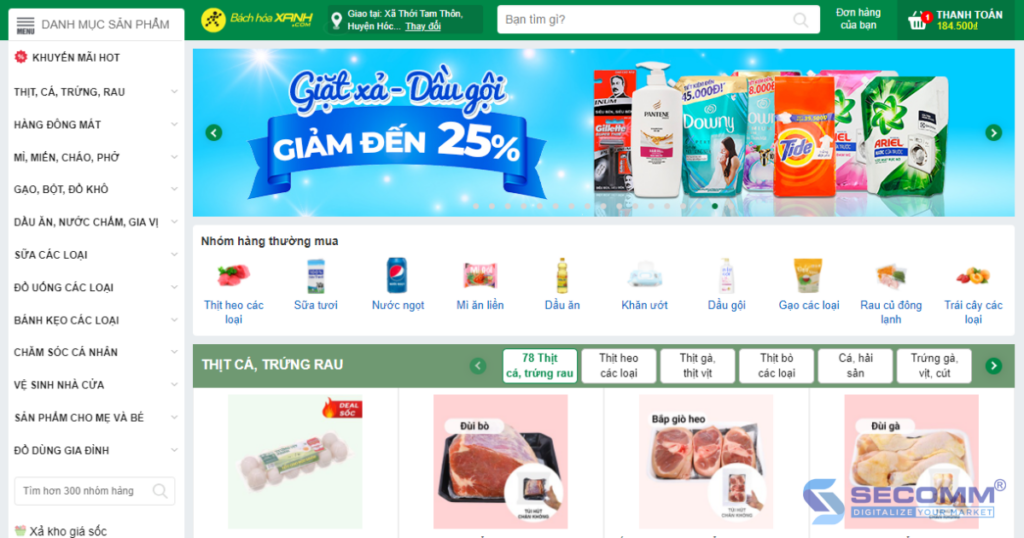
When operating a grocery eCommerce system, businesses can prioritize the development of basic functions to meet the essential needs during this time.
Some basic functions required in eGrocery websites, such as:
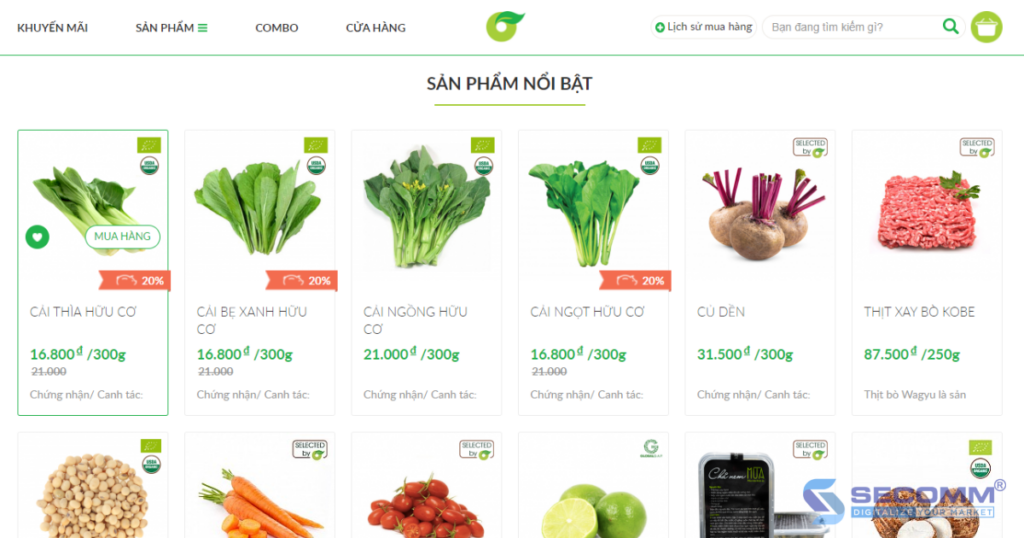
According to Decree 52/2013/ND-CP of the Government, every individual or organization that owns a sales eCommerce website must notify or register with the Ministry of Industry and Trade on the eCommerce Operation Management Portal.
Websites that exceed the time limit or fail to register/notify the competent management agency within the time frame specified will be administratively sanctioned by regulations.
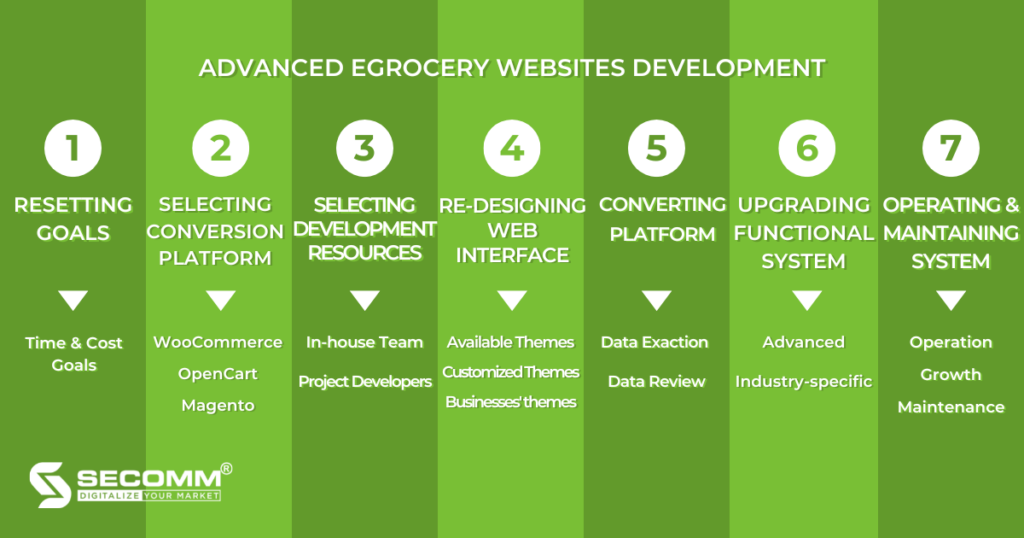
As the company grows and the market changes, the goals must be adjusted accordingly. This is also the time for leaders to rethink the business strategy’s target and money to invest in the grocery eCommerce website system. During this time, businesses frequently focus on the short and long-term goals of expanding the online grocery store system.
Long-term business goals can include expanding market segments, developing loyalty programs, forming consumer online shopping habits, etc.
Short-term goals for businesses can include capturing more new potential customers, increasing revenue, and supporting Ecommerce Marketing strategy.
When SaaS platforms are no longer effective enough to help businesses expand their online grocery store website systems, they have to turn to Open Source platforms like Magento, WooCommerce, and OpenCart to build advanced eGrocery websites.
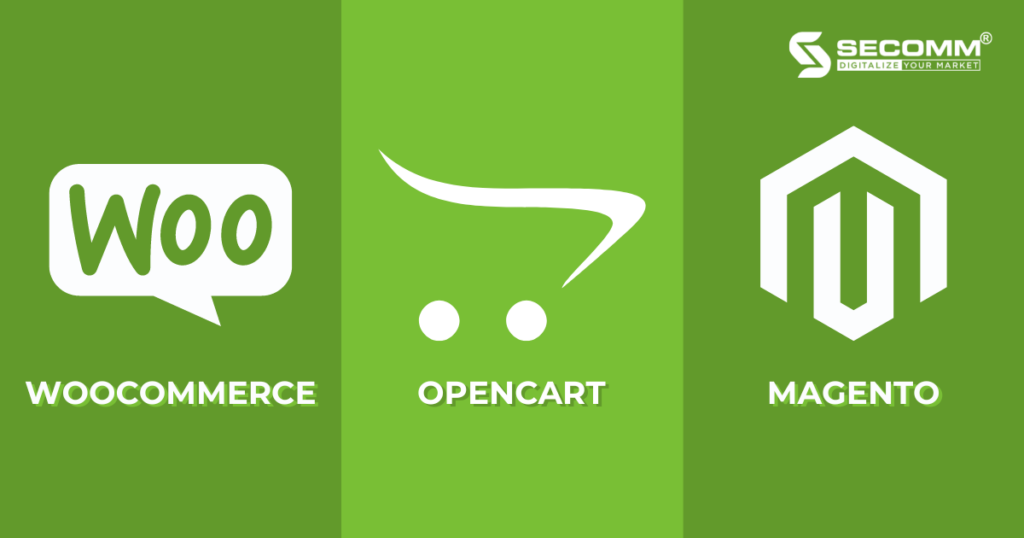
In this stage, platform selection criteria include:
Absolutely, businesses will face more challenges when switching platforms from SaaS to Open Source, such as changing costs, time to train personnel on open platforms, and data loss or errors during the conversion.
Businesses must choose the right resources to develop their website to build eCommerce website on an open source platform. Typically, companies can create an in-house team or find a project developer. Regardless of the resource, professional knowledge and practical experience about the chosen platform are required.
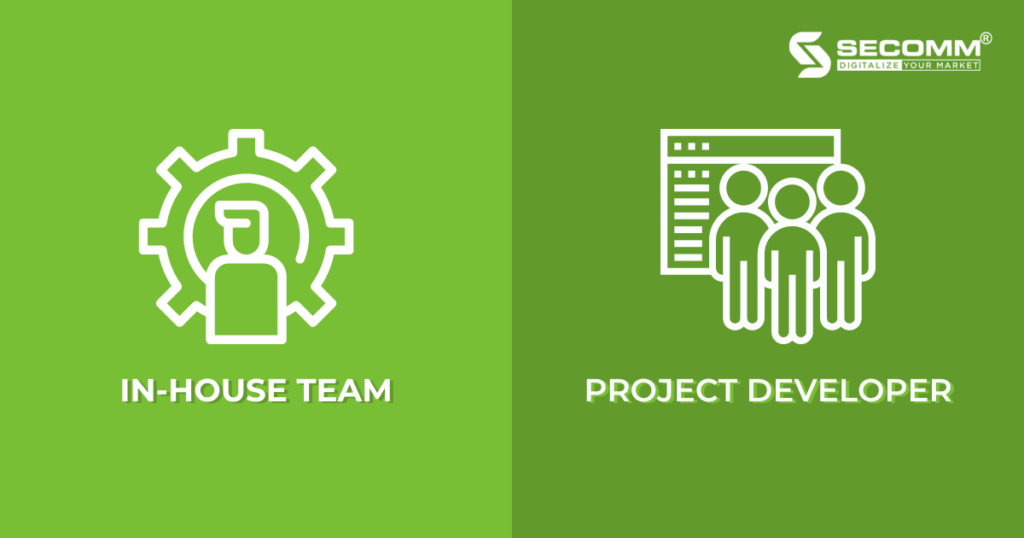
Businesses should recruit and train IT and eCommerce personnel with expertise and experience in the chosen platform. Building the right team will take a lot of time and money. Still, it will help businesses manage resources better and actively edit or develop the website system according to the requirements.
Businesses should look for project developers based on the following criteria to collaborate with them:
This will help businesses learn expertise, gain experience, and develop a website in all aspects of the eGrocery industry. Still, companies and their partners must collaborate effectively to achieve a better result.
Businesses can keep things the same while switching platforms. There is no need to change the current website interface. Many companies, however, will rebuild the website interface to match the new strategy and platform.
Similar to the previous stage, businesses have several options when designing the interface of a grocery eCommerce website: using available themes, customizing the themes, or creating their own. At this stage, however, businesses frequently choose to customize or design their own theme to reflect the characteristics of the eGrocery brand and industry.
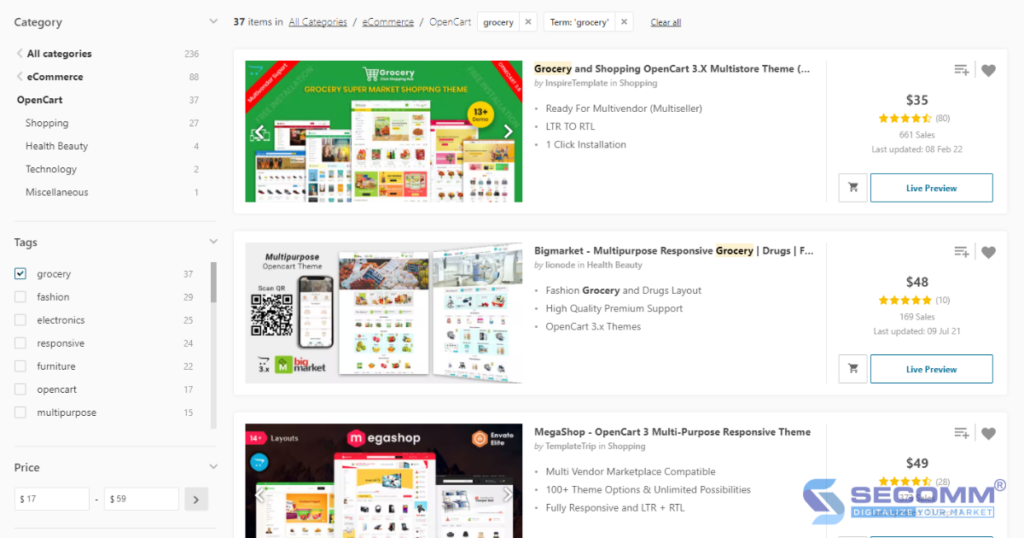
After selecting the appropriate conversion platform, the conversion should be carried out carefully to limit the risk of data loss or enterprise error. To avoid errors, the conversion is usually done as automatically as possible.
The platform conversion process includes steps to extract data from the old system and record it into the new system. After converting the platform, businesses need to double-check to ensure that the converted data is fully and correctly according to the plan.
In addition to the basic functions, businesses should focus on developing a more complex system of functions, including advanced and industry-specific functions for the eGrocery industry.
Advanced functions include order tracking, abandoned cart, similar product recommendations, advanced product search, multilayer product catalog, and others that improve the consumer experience and speed up the shopping process.
Industry-specific functions aid in thoroughly resolving the challenges of implementing intensive departmental eCommerce, meeting the needs of customer segments and businesses such as fast delivery, delivery time selection, and so on.
Furthermore, businesses must constantly update and develop user-friendly functions to stay competitive in the market.
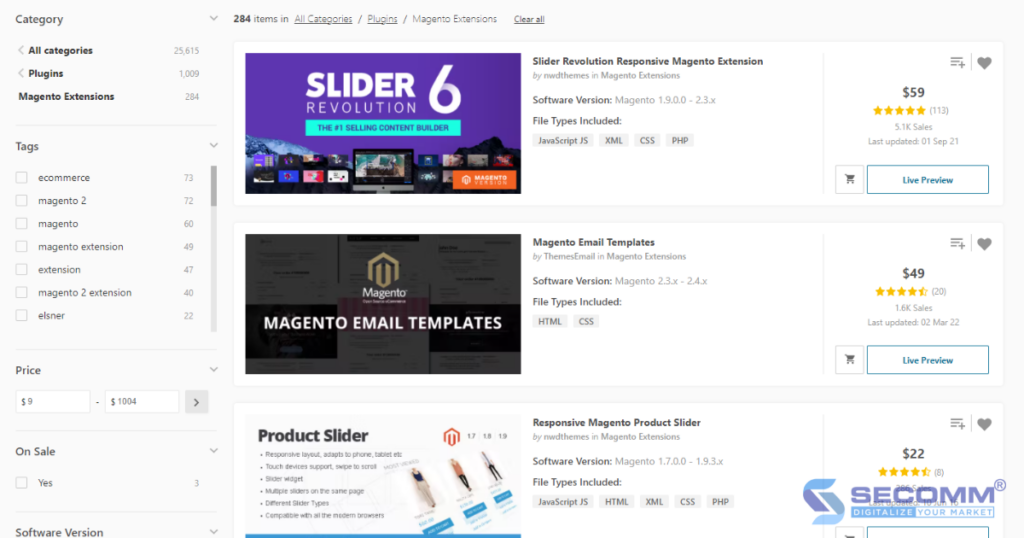
When putting the grocery eCommerce website system through testing, businesses must review and test the entire website and functionality in a specific time frame to ensure order processing speed, website stability, and so on. In addition, businesses must immediately contact the in-house team or the developer if issues arise to adjust and improve the website before going live.
After the grocery eCommerce website system has stabilized, businesses should focus on Ecommerce Marketing strategies (SEO, SEM, Email Marketing, Content Marketing, Social Marketing, and so on) or implement Omni-channel to grow their online eGrocery business.
For long-term sales growth, businesses should maintain, update, and upgrade their website system regularly, quickly adapting to changes in the eCommerce market in general and the grocery market in particular.
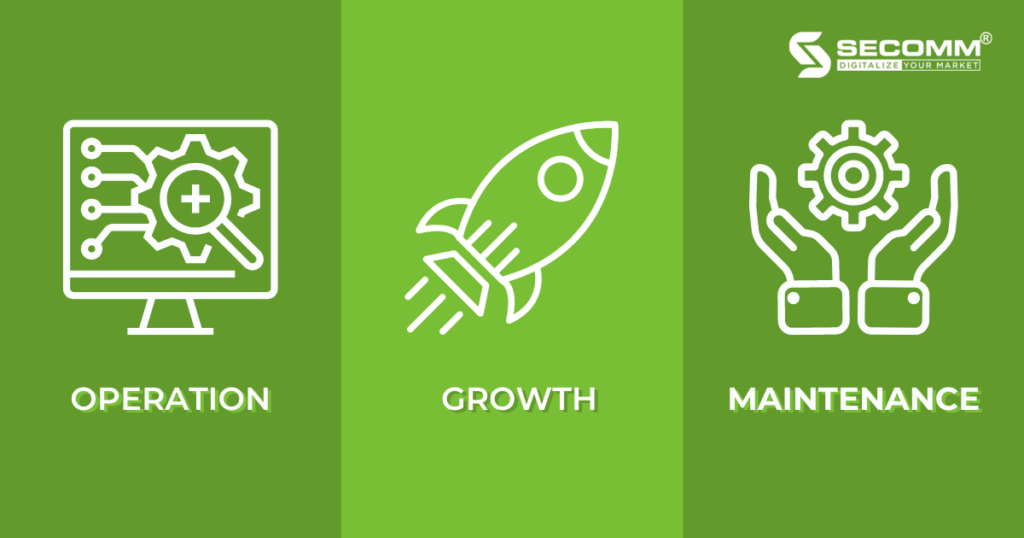
In general, developing comprehensive eGrocery websites for the Vietnamese market is complex. It requires businesses to invest significant time and money in researching the best eCommerce strategy for each stage of business development.
Our company – SECOMM, has been partnering with many big enterprises such as An Nam Group (Vietnam), Jasnor (Australia), and Changi Airport Group (Singapore). As a result, we are aware of the challenges and worries firms face while developing an eCommerce website system.
Get in touch with us now for FREE eCommerce consultancy and solutions in eGrocery businesses.
 2
2
 4,122
4,122
 1
1
 1
1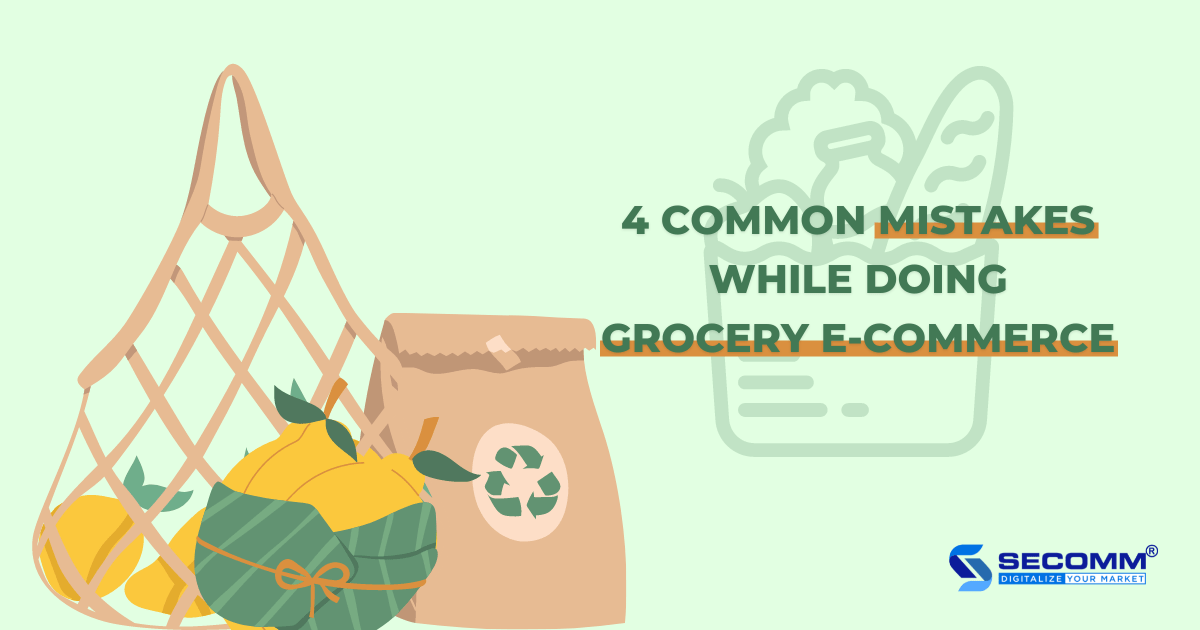
Grocery e-commerce is an inevitable business trend in the current Vietnamese e-commerce market. Some grocery stores have implemented e-commerce very early and have achieved great success, such as An Nam Gourmet, Bach Hoa Xanh, WinMart, and Co.op Online.
However, not all businesses are fortunate to deploy effective e-commerce because risks and wrong decisions when doing business can happen in any market, not only in the eGrocery market.
Some mistakes are fixable, but there are mistakes no matter how much budget and time it takes to make up. Here are some online grocery store mistakes that eGrocery business leaders need to know.
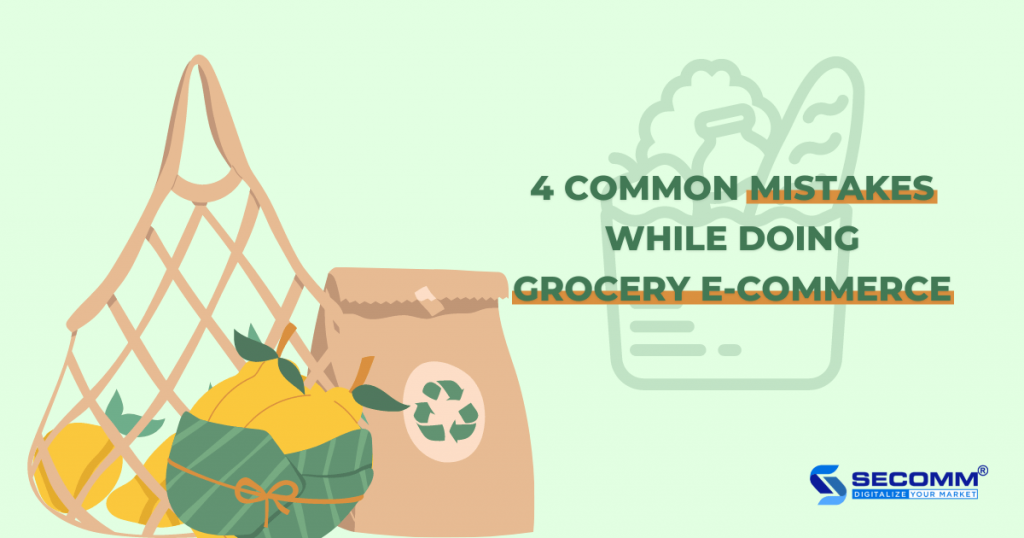
The grocery store business process in chain stores and e-commerce websites is entirely different. However, when implementing e-commerce, many businesses put the entire existing process on the website system without any customization or modification to conform to general operating procedures.
To shift business from offline to online, businesses must face difficulties such as synchronizing data from POS (Point of sale), e-commerce platforms, and e-commerce websites for other systems like CRM, ERP, BI, etc.
Grocery e-commerce is an extraordinary industry, with many complex features such as products with many units, selling methods, weight differences, constantly changing prices (day/week/month/year), expired products that need to be canceled, or imported new must have specific data, complicated payment processes, cumbersome warehousing operations, etc.
In particular, most products in the grocery store are fresh and fast food, so the damage rate is high, and the delivery time needs to be faster than in other fields. In addition, for these items, “housewives” also need to choose the correct delivery time.
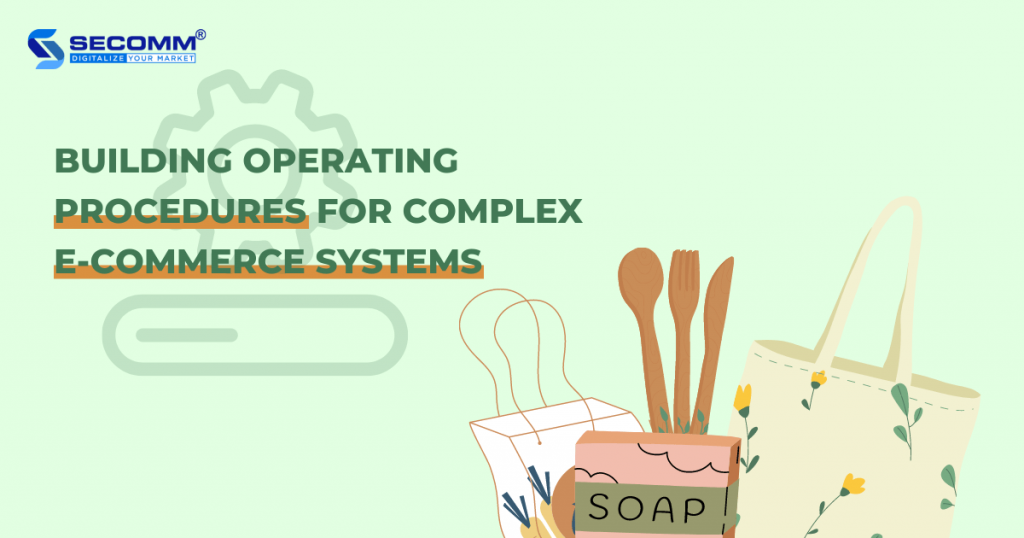
Because of the complexity of the operation process, the requirements for the e-commerce system are also more unique compared to other industries, making it difficult for managers to grasp the business situation and not be able to manage the number of products in stock in each branch.
Enterprises should build their in-house team or look for experienced grocery e-commerce developers to design the system operation process for specific industry and business problems that SaaS platforms cannot provide.
An e-commerce platform is software that businesses use to build an e-commerce website. Choosing a platform is always the first step in the e-commerce business process, so choosing the wrong one will lead to the entire online grocery store strategy going down.
After a period of using the unsuitable platform, businesses are required to “change blood” with another platform. This mistake wastes time and budget to build an e-commerce website for businesses without bringing about the expected results. It takes time to recruit and train employees to get used to the new platform.
To avoid this unnecessary mistake, businesses need to clearly define short-term and long-term goals for the brand, thereby building the criteria for choosing the most suitable e-commerce platform. To do that, businesses can do their research or seek professional advice before making a final decision. Of course, this takes time, but it will save time in the long run for the business.
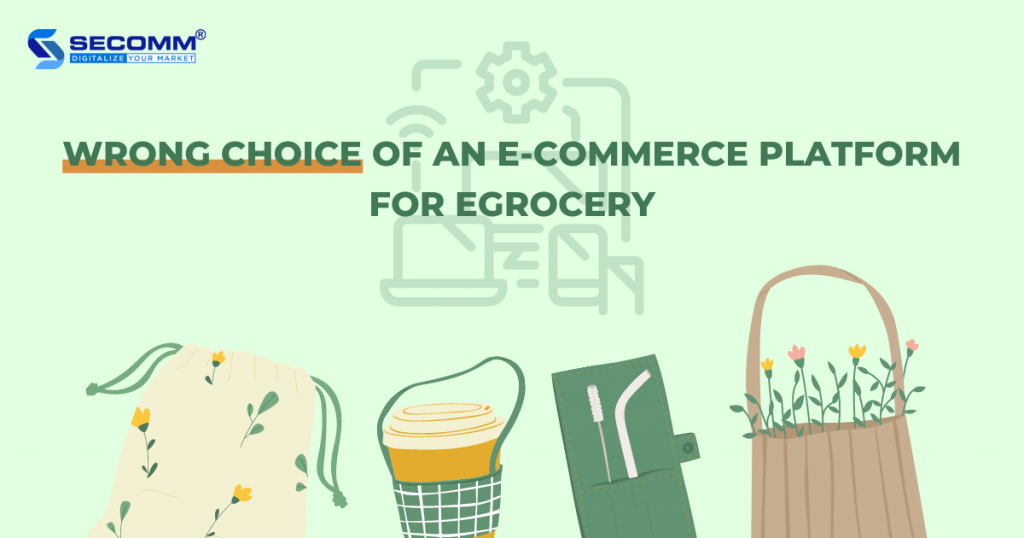
Currently, businesses that want to implement e-commerce step by step often choose Saas (Software as a service) platforms such as Shopify, BigCommerce, and Haravan in the early stages. This helps businesses save budget and time in the short term, market exploration, etc. Then, switch to open source platforms (Open Source) such as WooCommerce, OpenCart, and Magento to upgrade and expand the website system with convenient features for users and businesses.
Businesses with a long-term e-commerce business orientation often choose open source platforms right from the start to long-term companionship with businesses. Starting and developing continuously on an open source platform helps businesses save money and time to switch platforms, and own and fully control the system from source code to customer data, efficiently and proactively develop new features suitable for users and markets.
However, similar to building an operating process, choosing an e-commerce platform does not have a typical “recipe” for all businesses. Hence, each business needs to understand its business strategy, operating model carefully, and so on. in each stage of development.
The interface is essential in the grocery business, and it is necessary to meet UI (User Interface) and UX (User Experience – User Experience) standards. These are two crucial factors in any e-commerce website. However, many businesses forget these two factors when designing websites, leading to consequences such as an unattractive interface, not showing the characteristics of the business and the grocery, poor website performance, and page loading—slow, poor navigation, and few specialized functions for e-commerce, etc.
The UI / UX standard design has not been emphasized. However, the user experience on the enterprise’s website becomes worse, unable to retain users, affecting the revenue and brand positioning of the business.
So when choosing an e-commerce platform, businesses should also choose platforms that can help businesses customize the interface and functionality of the source code.
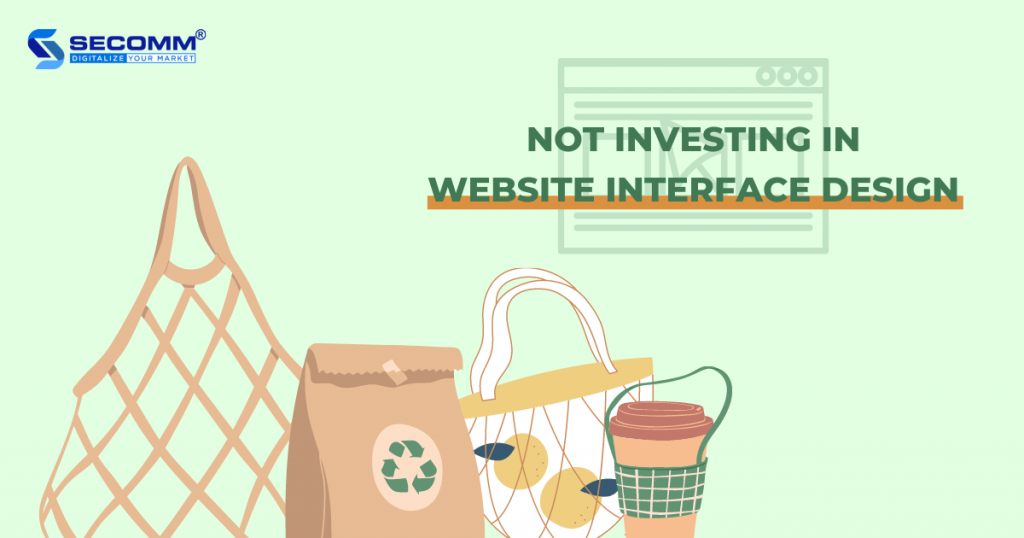
Currently, there are 3 ways to design the interface for a website:
At the right time, the functional system is not what “needs not to have” and “what has is not needed.” For example, in the early stages of entering the e-commerce market, businesses often do not have a certain number of users, so the functions of the Loyalty Program (loyalty program) are not necessary. Instead, businesses should focus on building functions that help exploit potential customers. Then, after having a stable number of users, businesses can gradually build more specialized functions, solving industry-specific problems.
Building a functional system that is not suitable for users’ needs at each time will waste time and cost to build a website without providing a satisfactory shopping experience, affecting revenue efficiency and can be left behind competitors in the industry.

In general, egrocery is the “golden opportunity” for businesses to implement e-commerce. However, to capture opportunities and market share, businesses need to pay attention to many factors, especially the mistakes to avoid mentioned in this article.
With experience in successfully implementing complex grocery e-commerce systems like An Nam Gourmet, SECOMM understands grocery businesses’ obstacles. Contact SECOMM now for a free consultation on detailed e-commerce system development solutions!
 2
2
 3,422
3,422
 1
1
 1
1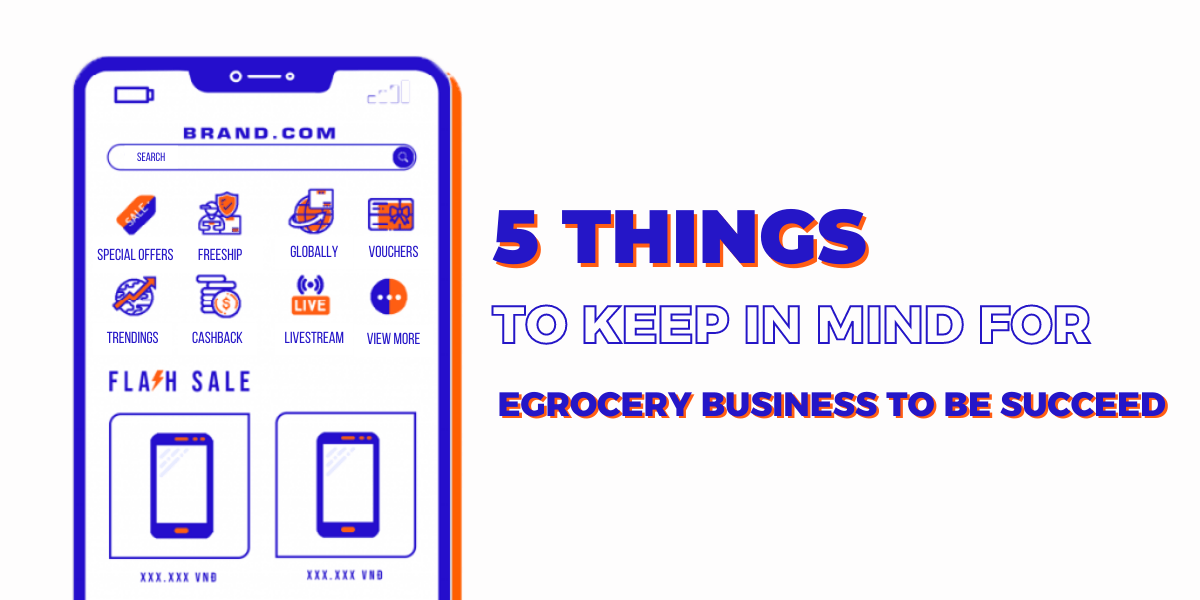
When grocery business activities face many obstacles such as strict lockdown measures by Covid-19, shortage of necessities, and geographical distance, the demand for egrocery increases daily.
Ecommerce marketplaces such as Tiki (Tiki Ngon), Lazada (Lazada Supermarket), Shopee (Shopee Fresh), and super apps like Momo (Online shopping), Grab (Grab Mart), etc. all, in turn, deploy egrocery to respond to consumer needs promptly. In particular, grocery stores’ eCommerce websites such as Bach Hoa Xanh, WinMart, and Co.opmart quickly seized the opportunity and grew impressively!
The egrocery market continued to thrive after the lockdown period was removed, indicating the expanding potential of the grocery eCommerce business.
Not only was grocery eCommerce appearing in the Vietnamese market but also globalization. For example, in the United States market, egrocery has an annual growth rate of 200% (according to Statista).
Businesses must swiftly develop an eCommerce system fit for industry and customers to capture changes in the market. However, administrators must consider several concerns while implementing grocery eCommerce to efficiently engage in the market.
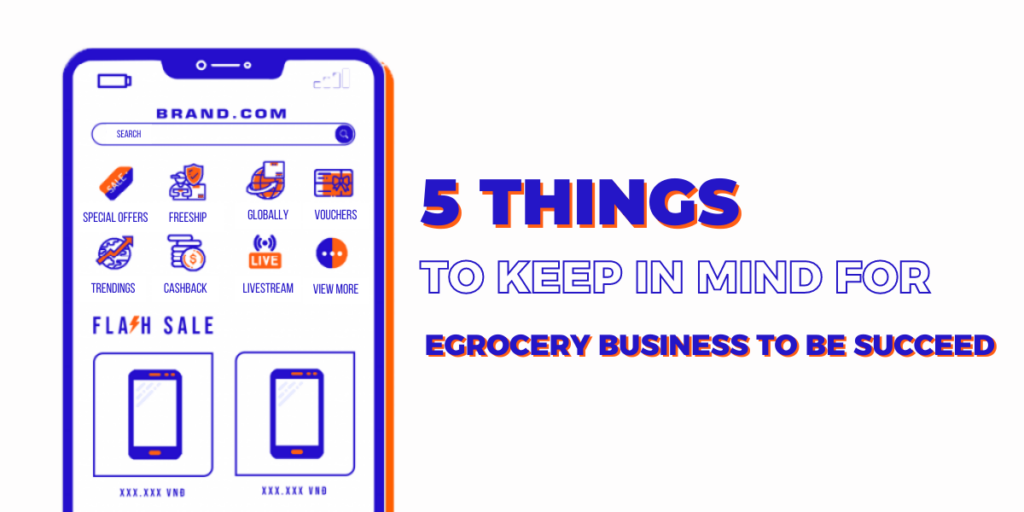
Choosing the right eCommerce platform is essential for any business, not just the grocery industry. An eCommerce platform compatible with business strategies will help companies save time, accelerate the digital transformation process, and save money on deploying eCommerce websites in both the short and long term. In addition, businesses do not need to switch platforms many times, saving time and budget for recruiting and training personnel to familiarize themselves with the system.
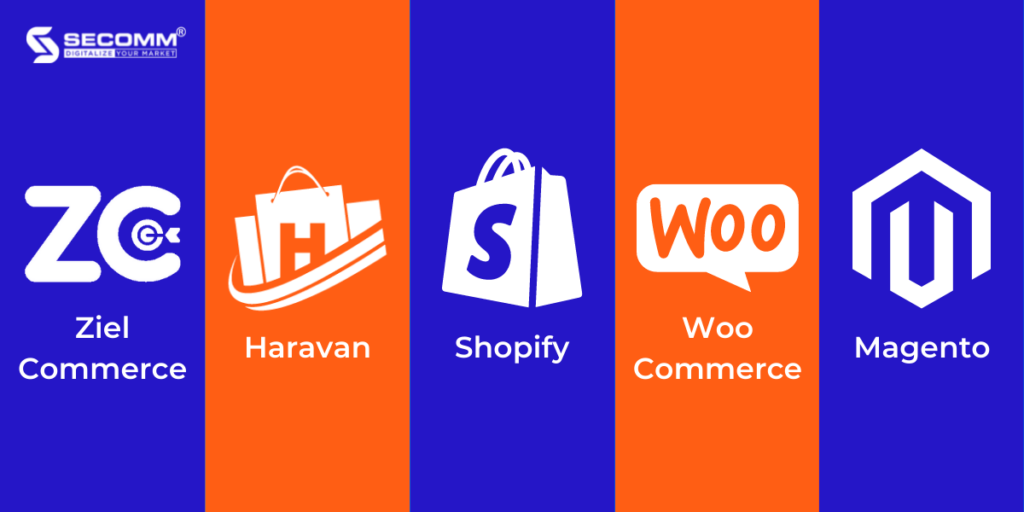
Some grocery business eCommerce platforms include Ziel Commerce, Haravan, Shopify, WooCommerce, and Magento. In particular, Ziel Commerce is a platform designed explicitly for eGrocery businesses.
SaaS platforms like Haravan and Shopify are suitable for SMEs (small and medium enterprises), startups, or new entrants to eCommerce. WooCommerce is ideal for businesses that need to own the source code and customize the website at an affordable cost. The Magento platform is suitable for many different business models (B2C, B2B, B2B2C, etc) and many different business sizes (SME, startup, large corporation, etc).
This platform meets the needs of building an industry-specific eCommerce website under its characteristics, with full ownership of the source code and the ability to customize the website. However, due to the prolonged deployment time and high prices, many businesses are hesitant to use Magento, while many enterprises trust it.
A big problem that egrocery businesses need to pay attention to is that the grocery industry has a relatively complicated operation.
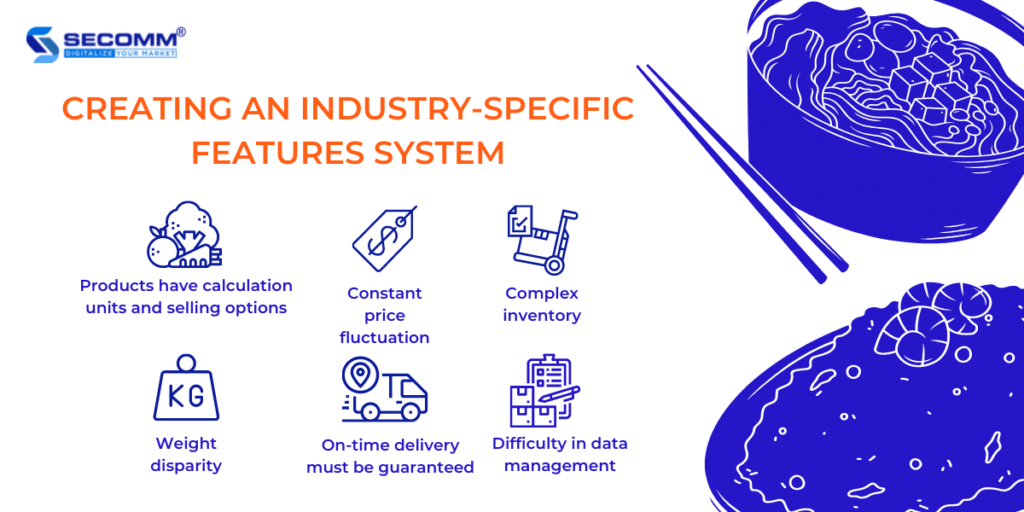
Grocery products have many units of measure, weight differences, and different ways of selling; prices constantly fluctuate and update continuously by day/week/month/year.
The import and export of warehouses are complicated (general warehouse, store warehouse, warehouse for each area in the store), so when deploying an online grocery store, businesses need to synchronize the price and quantity of products so that when restocking, the data will not be lost. Weight and cost data on branches are changed under control, avoiding the lack of synchronization between frontend and backend, causing data processing to be interrupted.
At the same time, grocery products are mainly fresh foods such as meat, fish, eggs, milk, etc, so they need to be refrigerated, delivered quickly, or selected with the correct delivery time.
Handling all the problems in the complex operating process of the grocery industry requires a team of highly qualified IT and eCommerce personnel to design an eCommerce system that is suitable for the specific process and requirements of the business – something current SaaS platforms are not enough to meet.
When running an online grocery store, the user experience requirements are very high; from navigating shopping behavior to the checkout process, order delivery needs to be optimized. Because user experience increases the likelihood of customers placing their first order, it also gives customers more reasons to buy again, contributing to a competitive advantage over competitors in the same industry.
There are many ways for businesses to enhance the user experience, such as layering product categories to navigate customers more intuitively and building specialized functions such as quick add products to cart, fast checkout, search enhancements, and product recommendations based on collected data, etc.
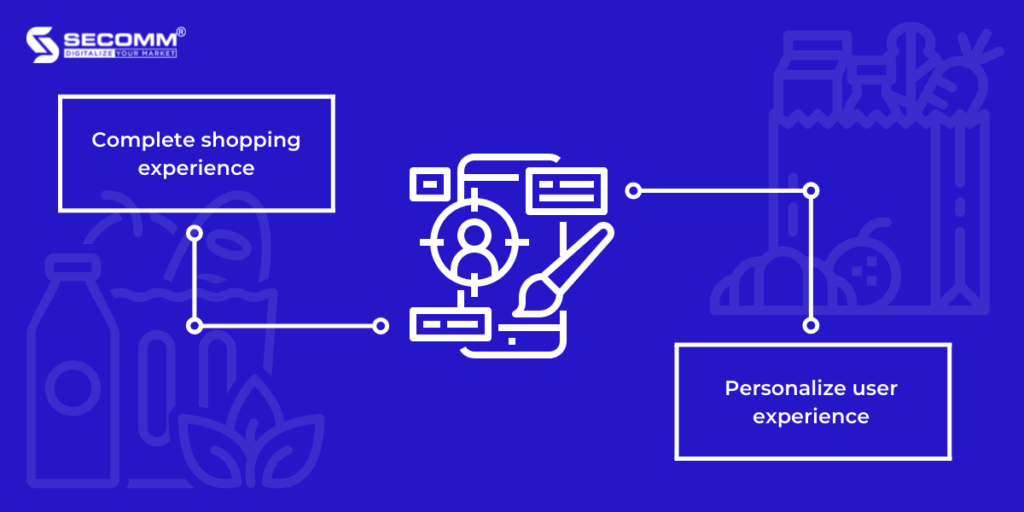
At the same time, personalizing the user experience is an essential factor in the customer’s shopping journey. Businesses exploit, analyze, and leverage data to build the right customer journey, match consumer behavior, and increase the user experience level of personalization.
Personalize from CMS content and display products to navigate the shopping journey for businesses to increase loyalty and customer lifetime value (CLV).
The secret of doing an online grocery business is building incentive programs suitable for customer segments.
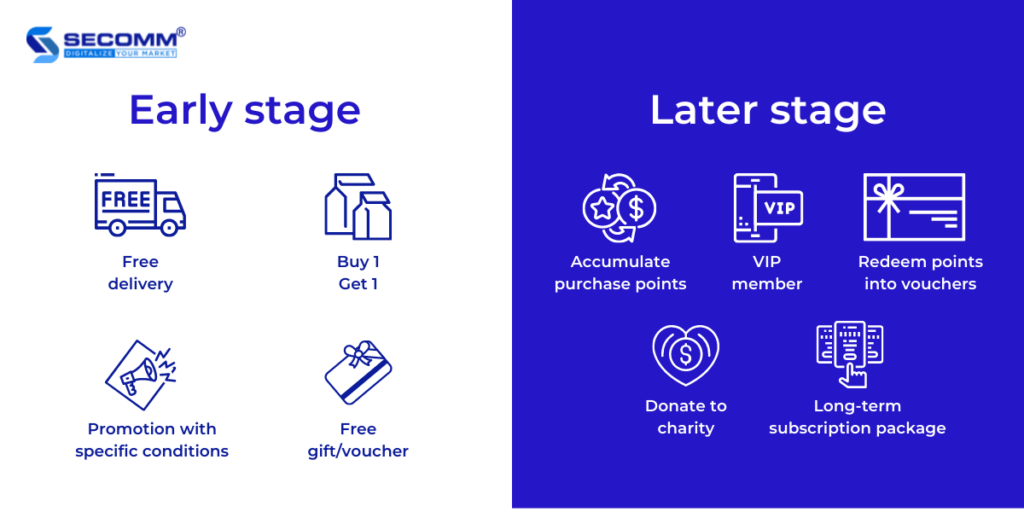
Some popular promotions that businesses can apply in the early stages include free shipping, buy one get one free, gifts/vouchers, or promotions with specific conditions (certain items reach a particular value).
After that, businesses can deploy loyalty programs such as accumulating points for purchases, VIP membership, converting reward points into discount codes, donating bonus points to charities associated with the brand, subscription plans, etc.
Omni-channel is one of the inevitable eCommerce trends in 2022; the application of Omni-channel will help businesses do online grocery business more conveniently.
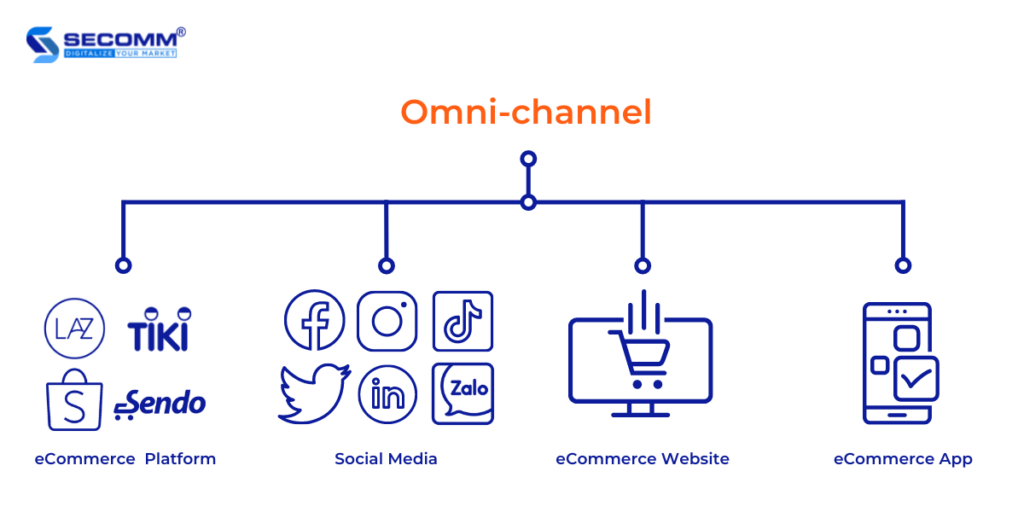
Omni-channel will help customers’ shopping experience be seamless from the physical store to the website, helping businesses follow customers from eCommerce platforms, social networks, websites, etc.
In addition, by collecting and analyzing information from Omni-channel, businesses can efficiently study customer behavior, preferences, and psychology and know whether they are satisfied with the product, service quality, or not to take reasonable measures to change.
It can be said that the grocery eCommerce business has both opportunities and challenges, requiring business managers to think carefully about tactics to make the most effective steps. But, of course, that work is not easy, finding a companion is also tricky, building an in-house team is not easy, and businesses have to pay a lot of opportunity costs and time to reach the “finish line” themselves.
With experience in successfully implementing complex grocery eCommerce systems like An Nam Gourmet, SECOMM understands grocery businesses’ obstacles. Contact SECOMM now for a free consultation on detailed eCommerce system development solutions!
 2
2
 4,275
4,275
 0
0
 1
1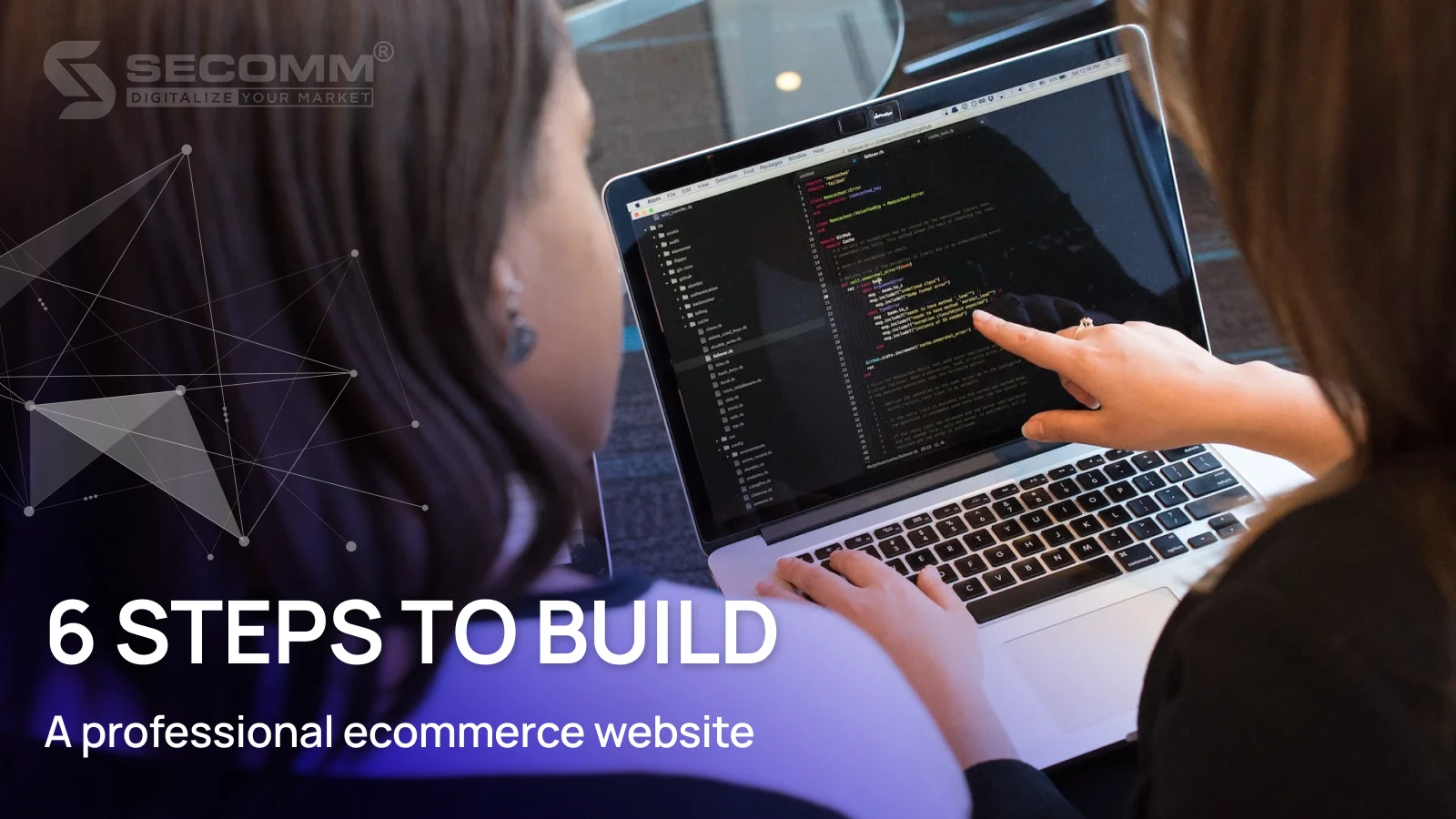
Trends in consumer shopping are shifting from offline to online, especially among the younger generation—an important factor impacting the new economy. Building an ecommerce website is crucial for the success of ecommerce businesses in today’s digital economy. So, what should businesses do to build a professional ecommerce website?
Objectives:
Businesses need to determine the purpose of the website and the priority of each goal to plan the development of the website according to each stage:
Requirements:
The ecommerce website needs to have a powerful configuration, a professional interface, and a diverse system of functions to meet the growing needs of customers. When designing the website, businesses should pay attention to:
Example: The structure of some common pages of an effective e-commerce website:
To maximize the customer experience, the ecommerce website needs to integrate features that support personalized customer experiences, aligning with their shopping behavior.
Example: Some common features:
Depending on the goals and complexity of the e-commerce website, determine the time and budget. To accurately determine the time and budget, businesses should seek advice from experienced and professional units.
Each platform has its advantages and disadvantages. Businesses need to consider choosing a website development platform that is suitable for their e-commerce business strategy. Some popular platforms include:
Suitable for businesses investing in the long term, saving budgets in the long run.
Suitable for building simple and less customized e-commerce websites.
Suitable for building e-commerce websites for new businesses with relatively low revenue.
Criteria for choosing a domain name:
Short and easy to remember
Criteria for selecting a hosting provider:
Configuration considerations: Disk space, bandwidth, parked domains, CPU, RAM, FTP accounts, MySQL accounts, dedicated IP, etc.
Support services: Data backup, 24/7 live chat support, and ticket submission for issue resolution.
When building an e-commerce website, businesses need to collaborate with units based on certain criteria:
Some ecommerce website design units in Vietnam include:
Purchase domain name and hosting
Criteria for choosing a domain name: Short, easy to remember.
Criteria for choosing hosting providers:
Coordinate with the development unit to ensure a smooth development process. Businesses should regularly update the project progress according to the approved solution. Simultaneously, update changes and coordinate with the cooperating unit. During the User Acceptance Test (UAT), businesses should test according to a checklist to ensure that the website development process meets expectations.
During the development process, businesses also need to work with payment and shipping units to provide services for the ecommerce website. When signing contracts with payment units, attention should be paid to security, compatibility between the website platform and the payment platform, and service fees. Some common online payment gateways in Vietnam include Paypal, Ngan Luong, VNPay, Airpay, and e-wallets such as Momo, ZaloPay. When cooperating with shipping units, businesses should consider the quality of services, shipping staff, packaging, and storage of goods to avoid affecting the user experience
 79
79
 31,881
31,881
 1
1
 58
58Subscribe to get the latest eBook!
Hotline